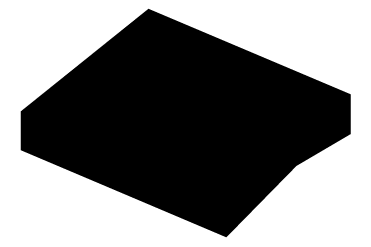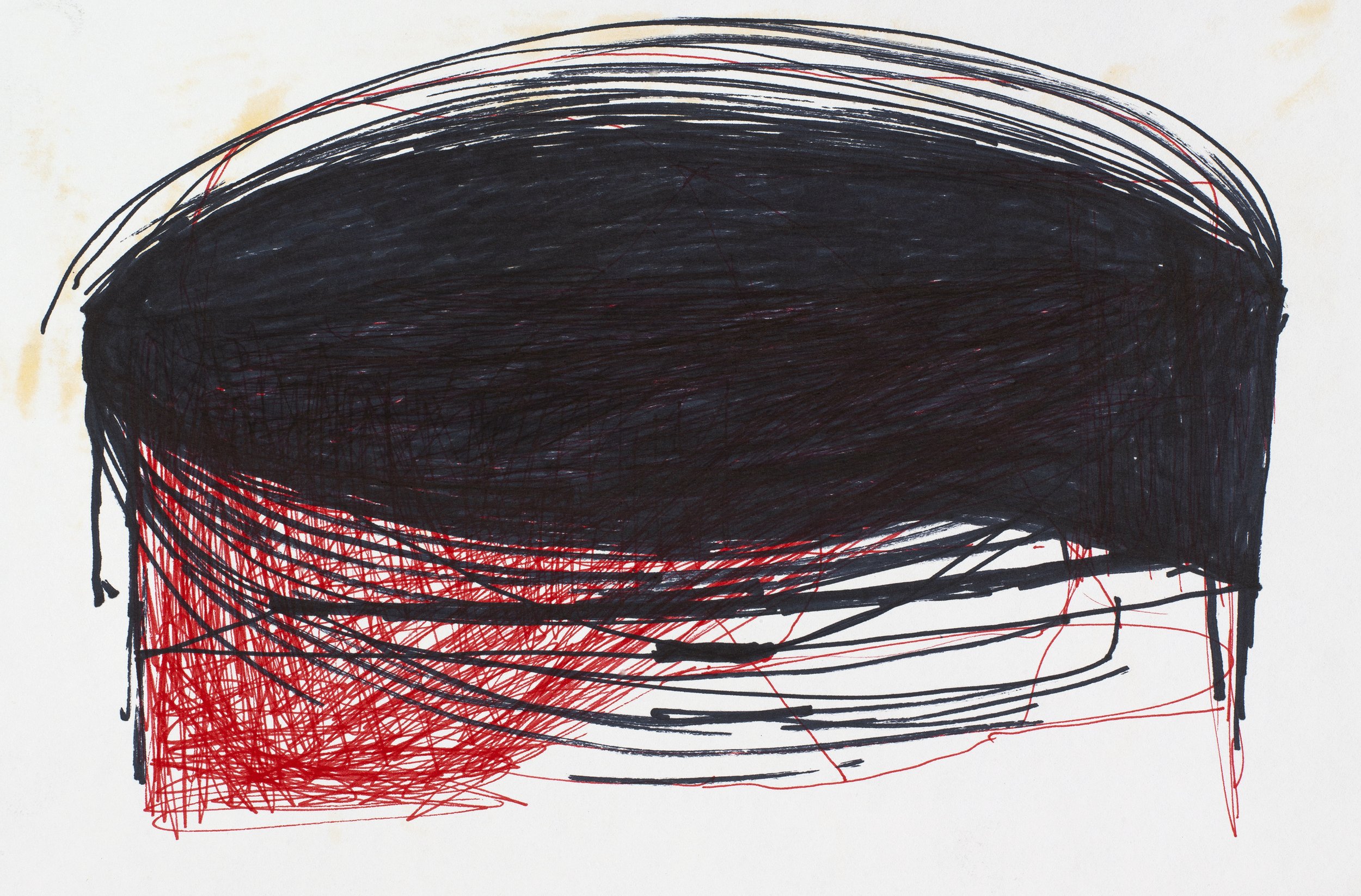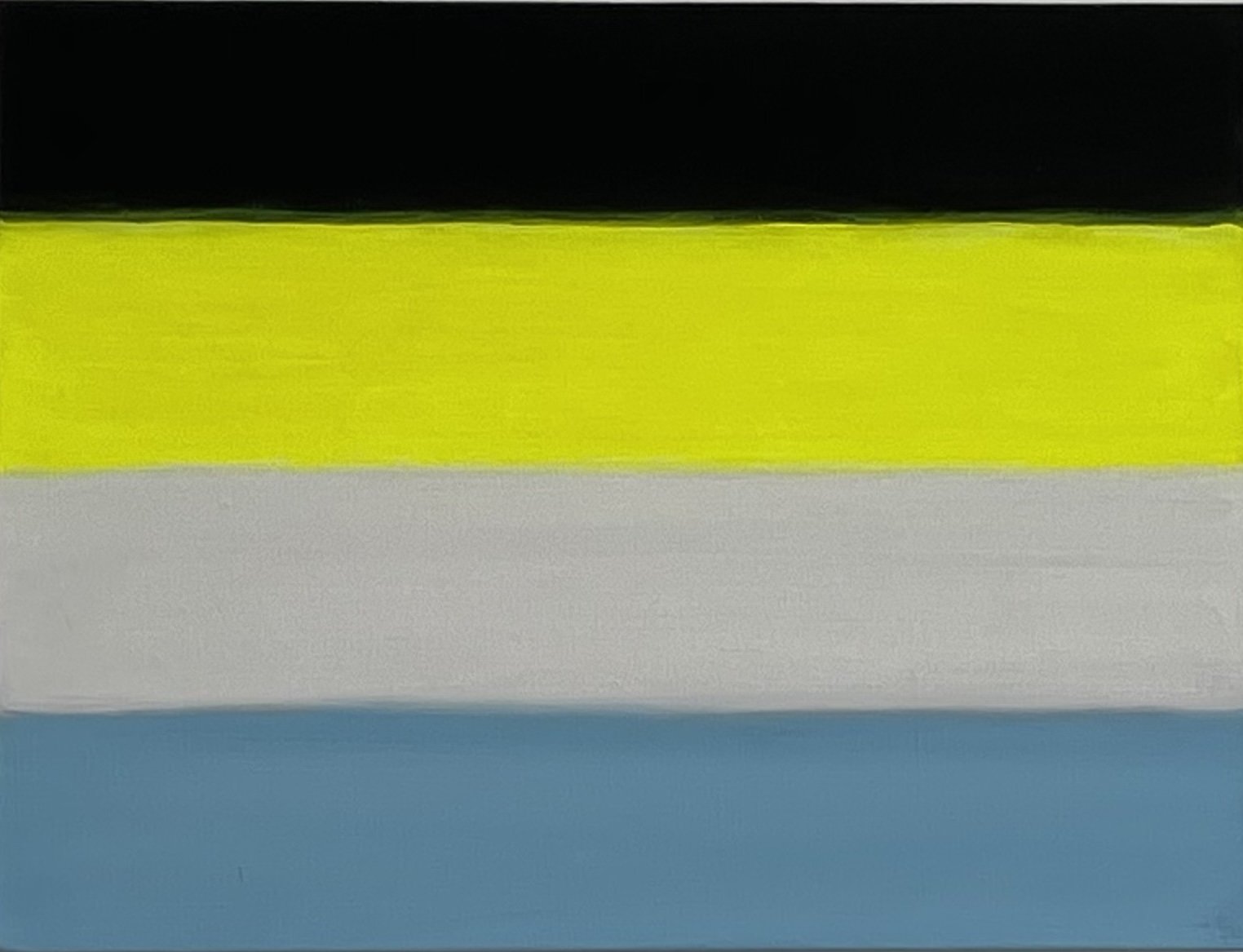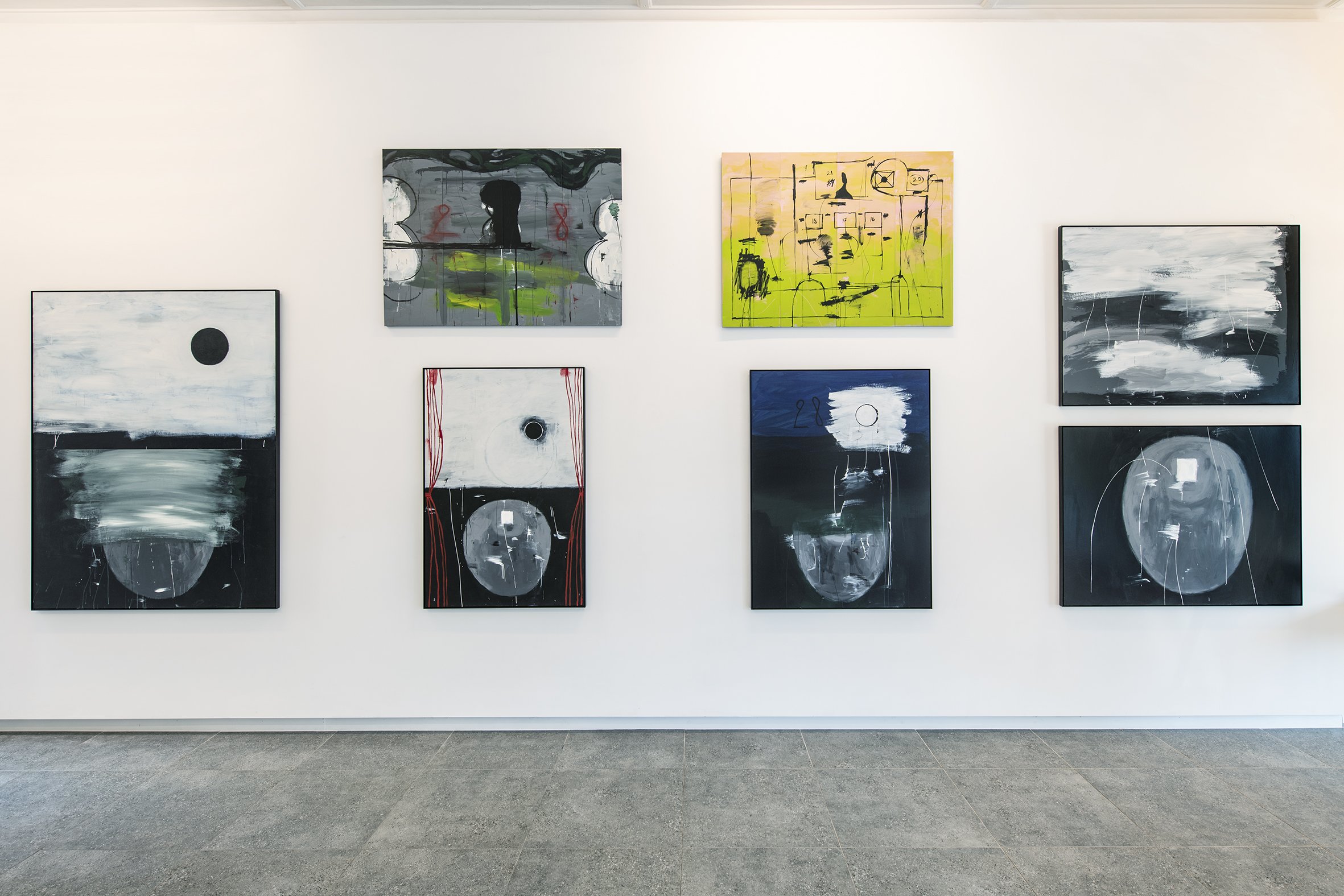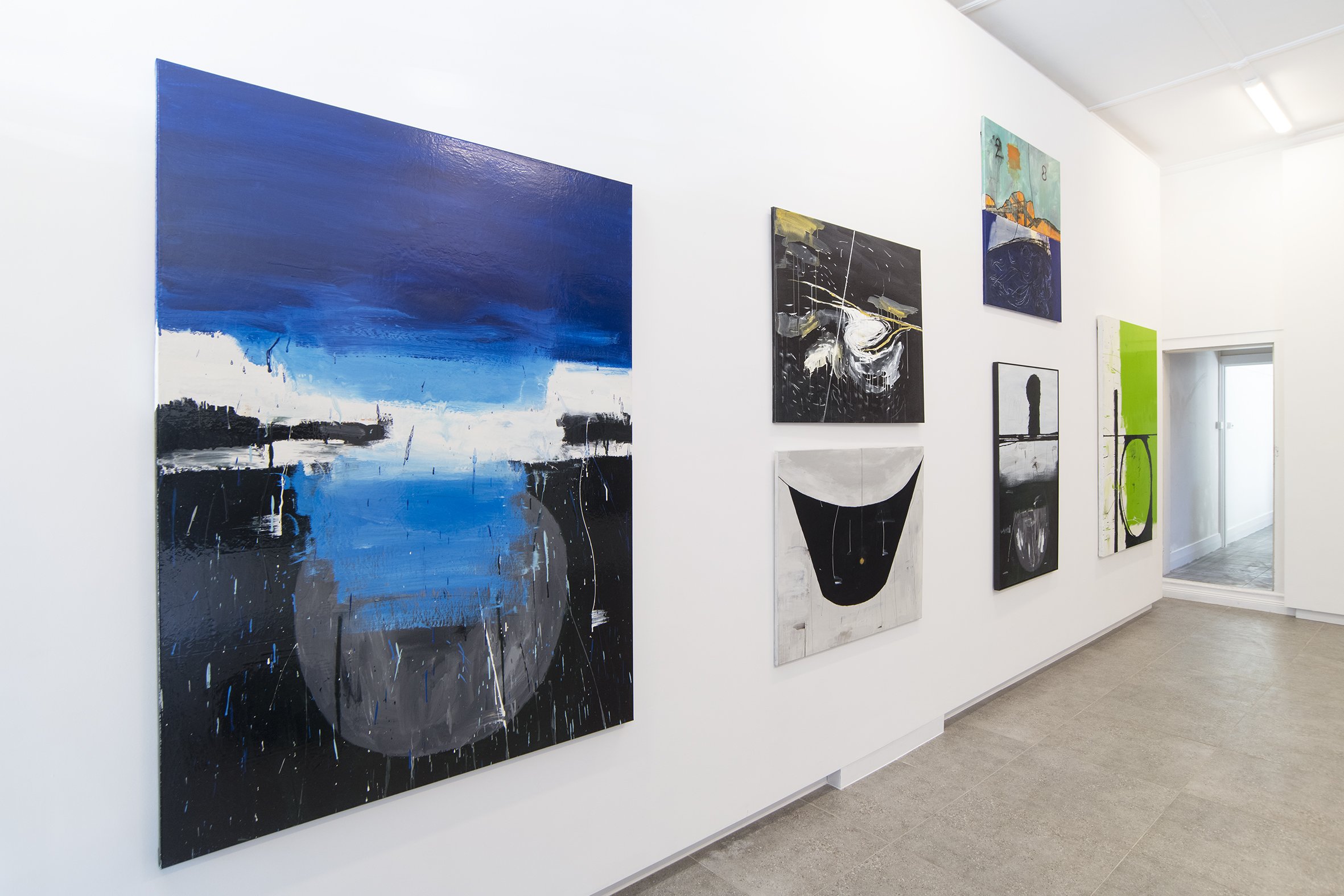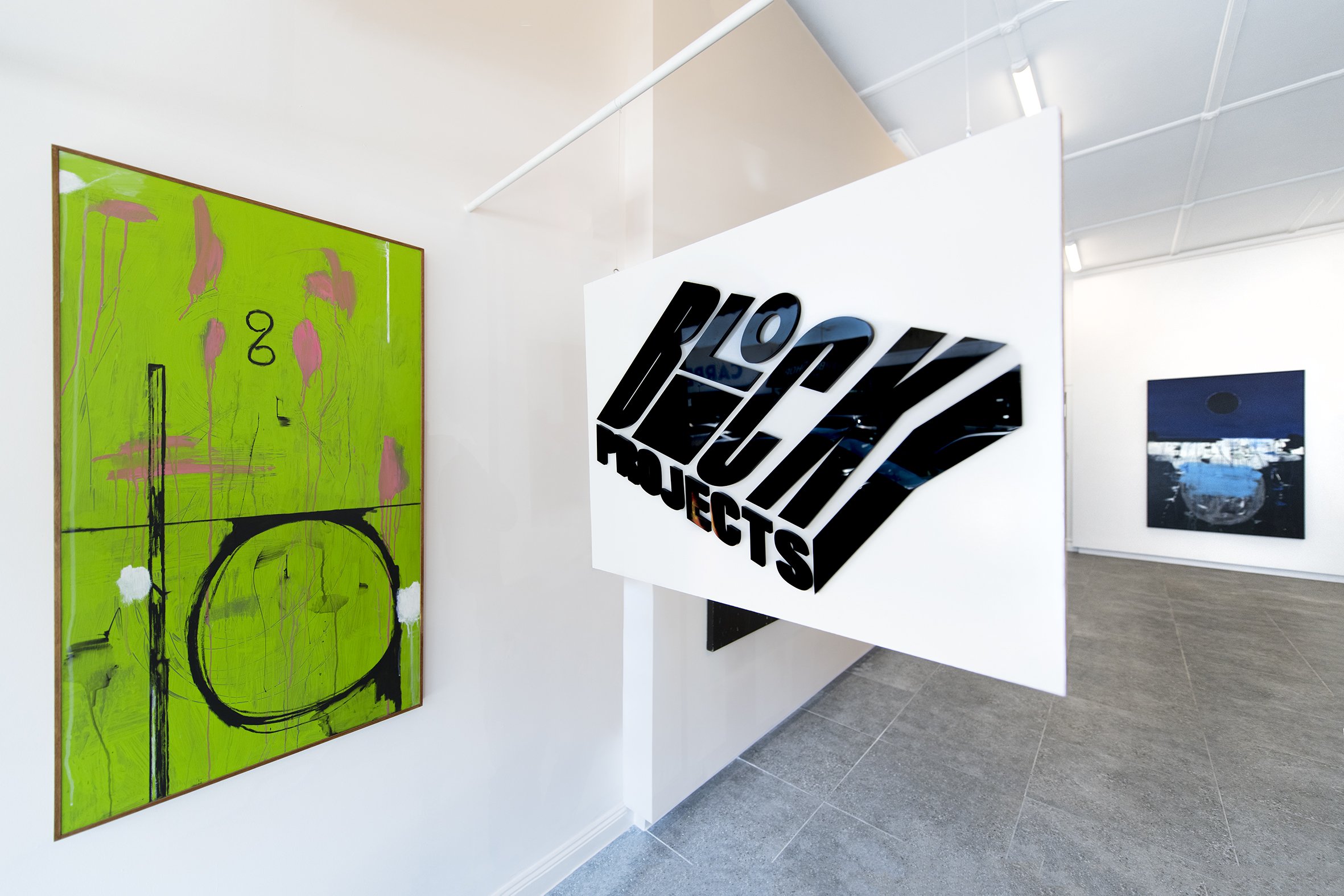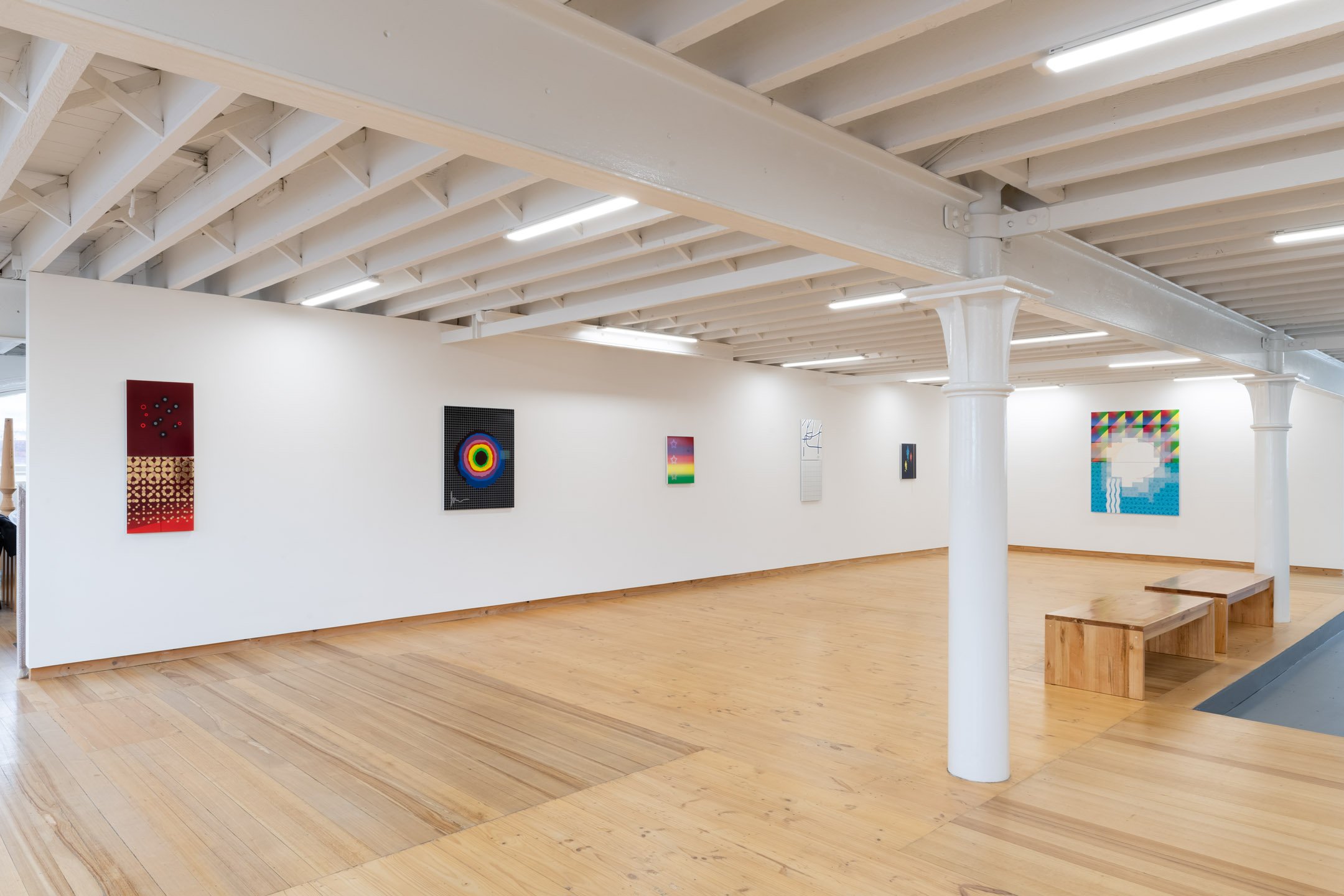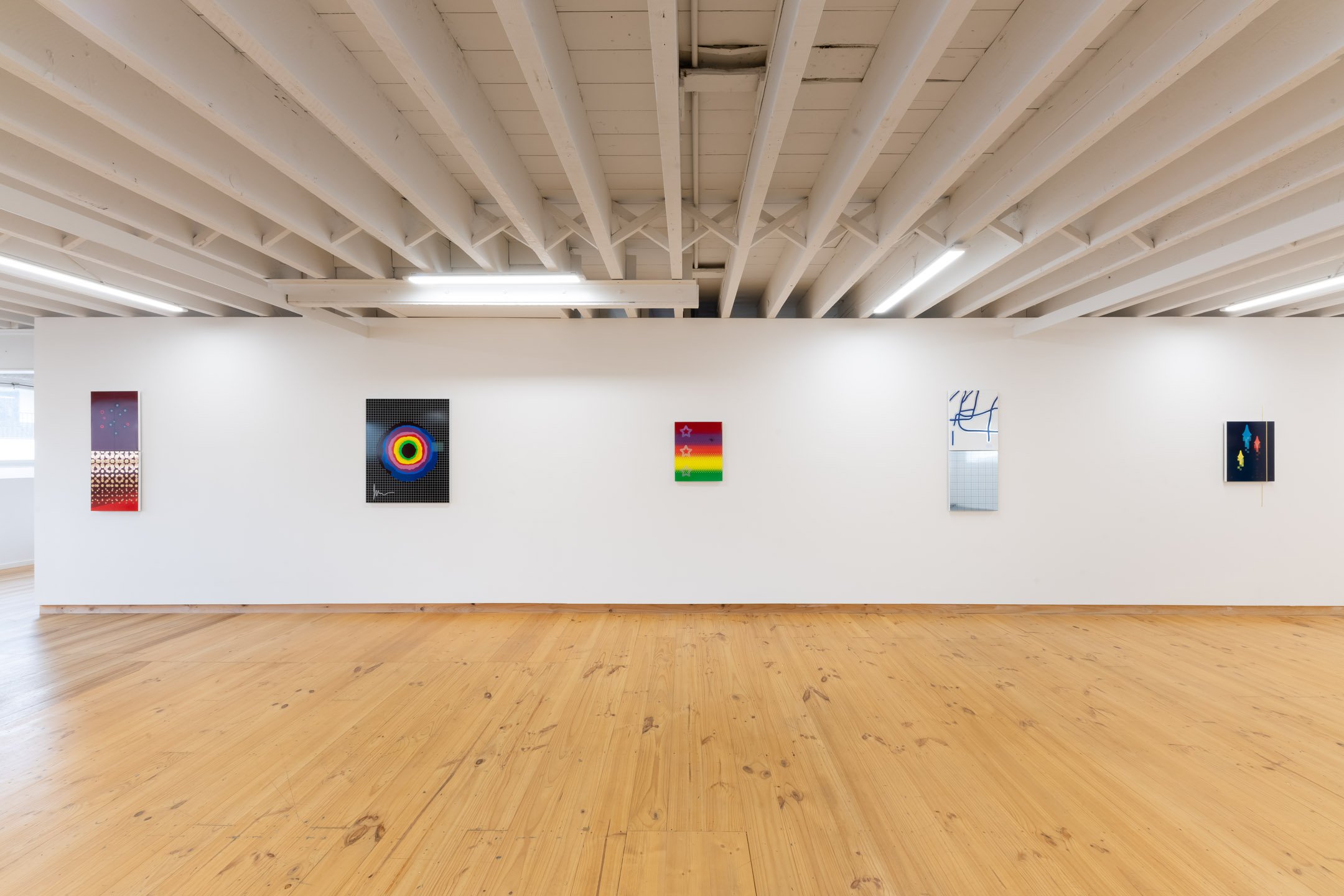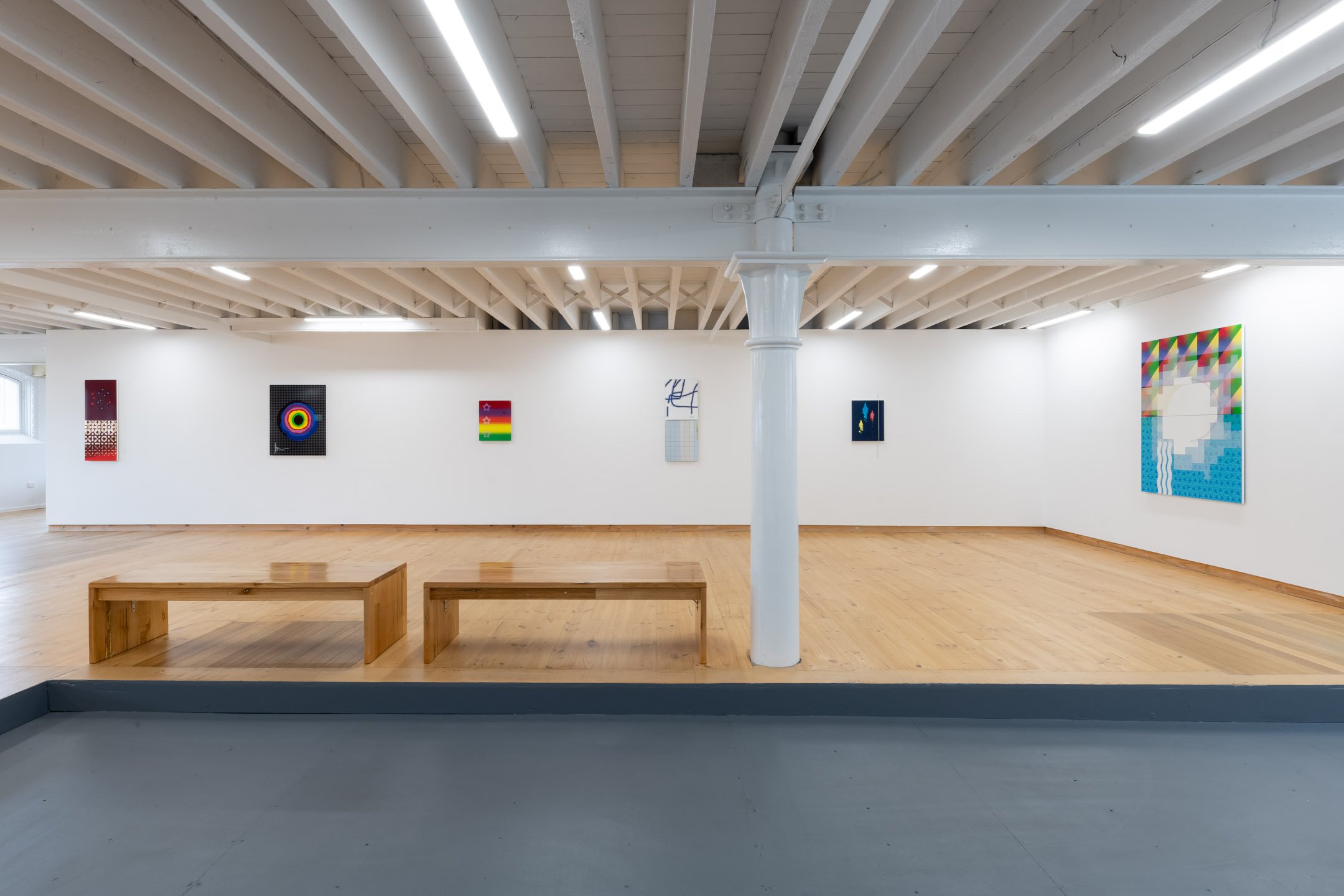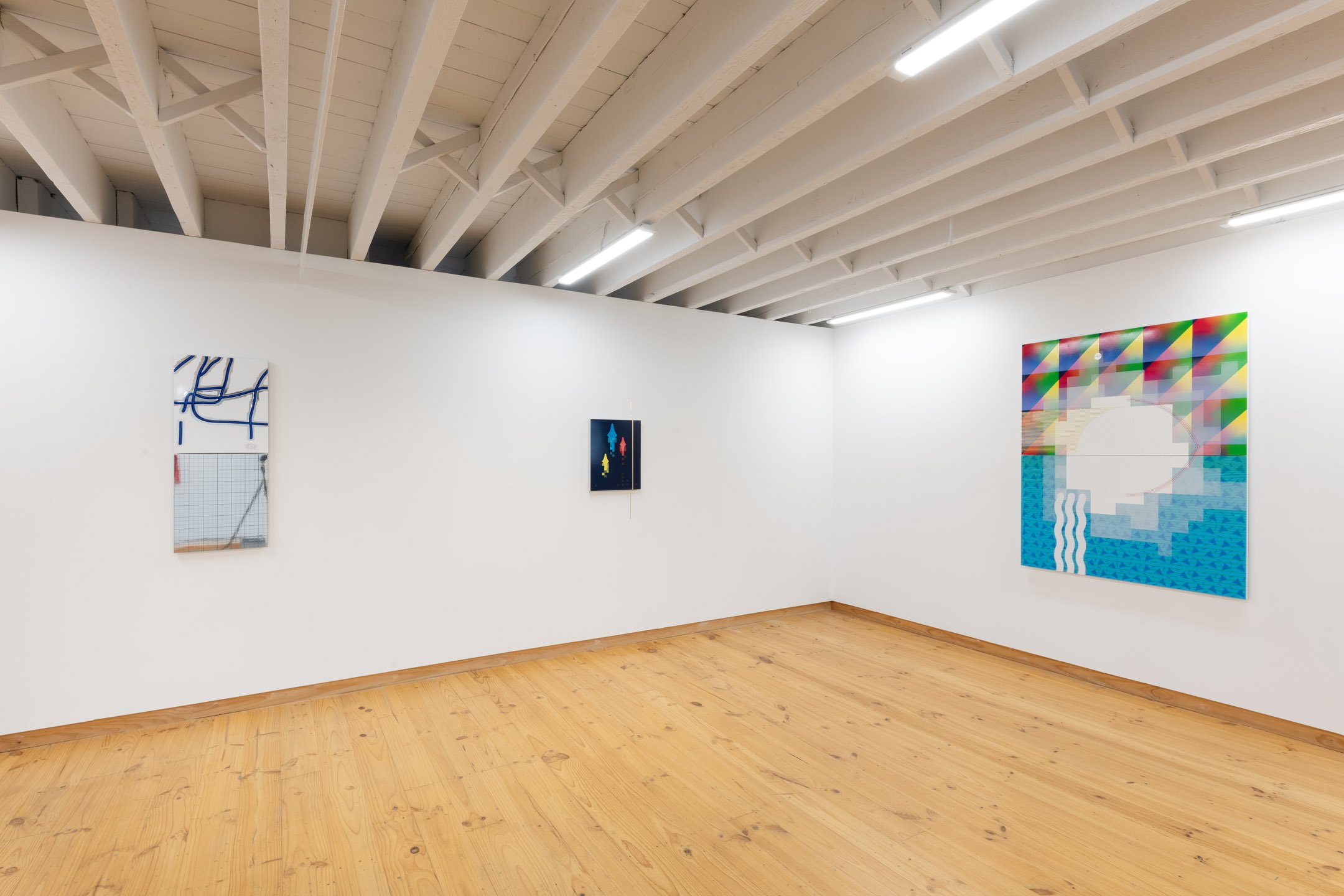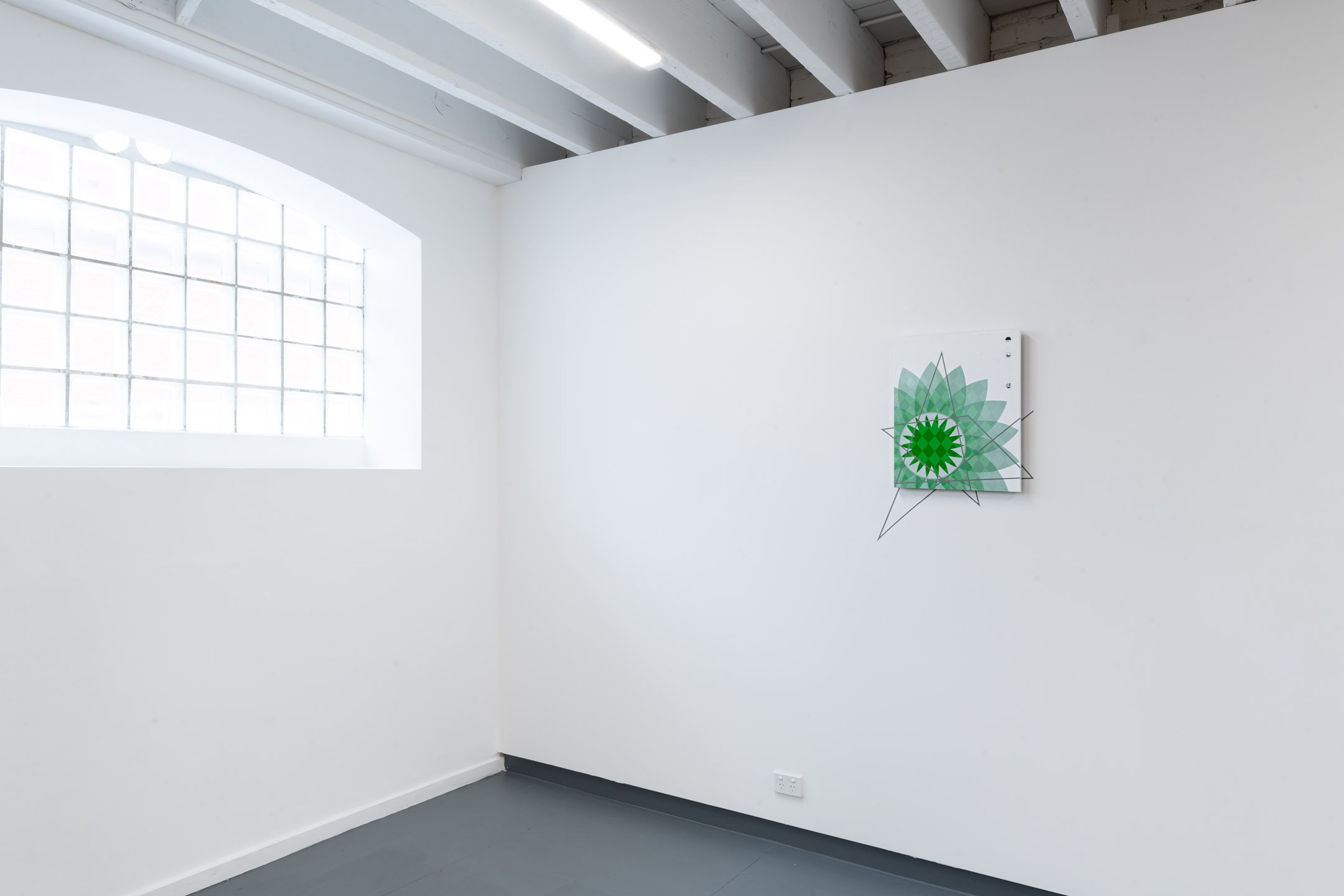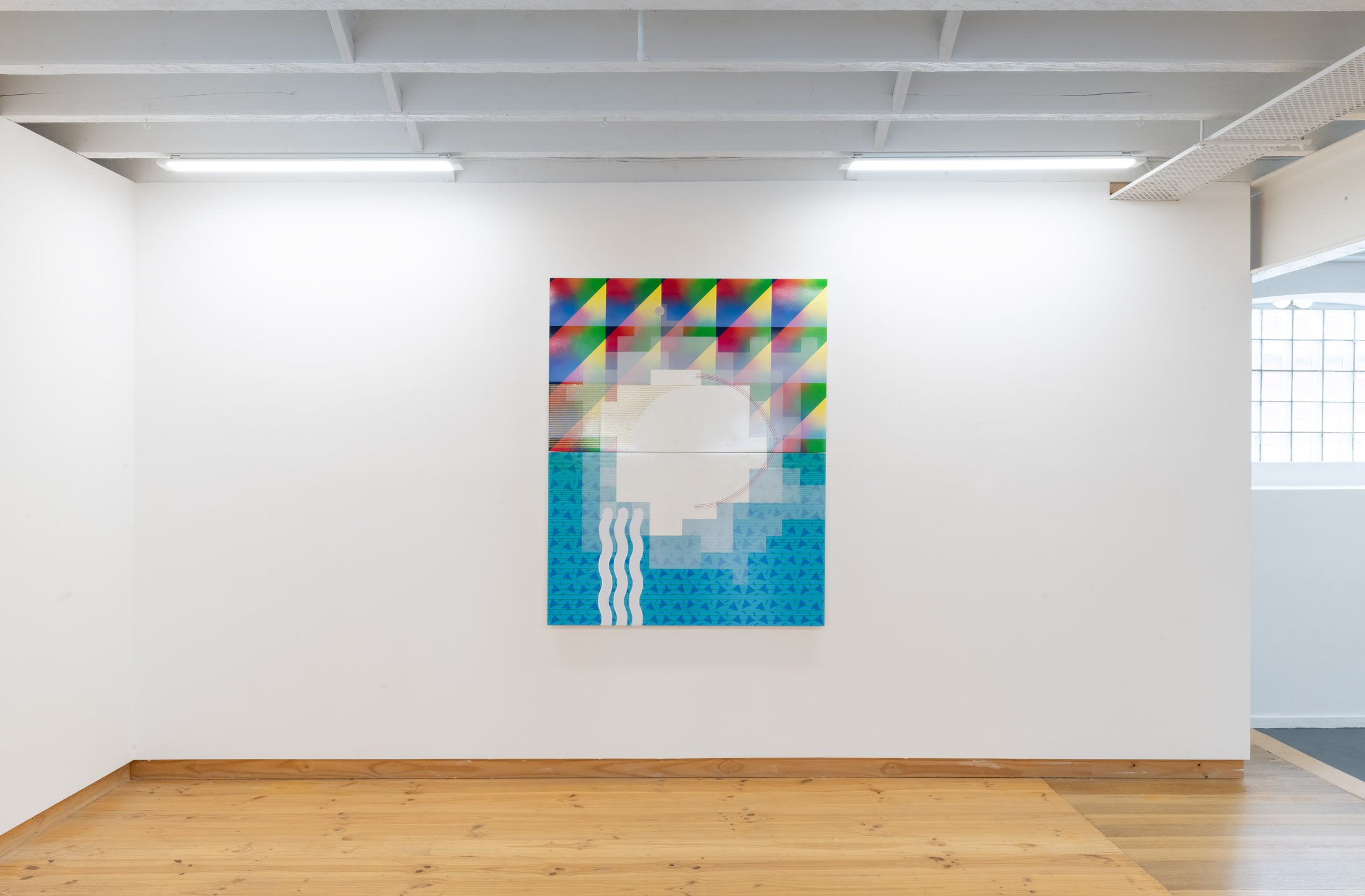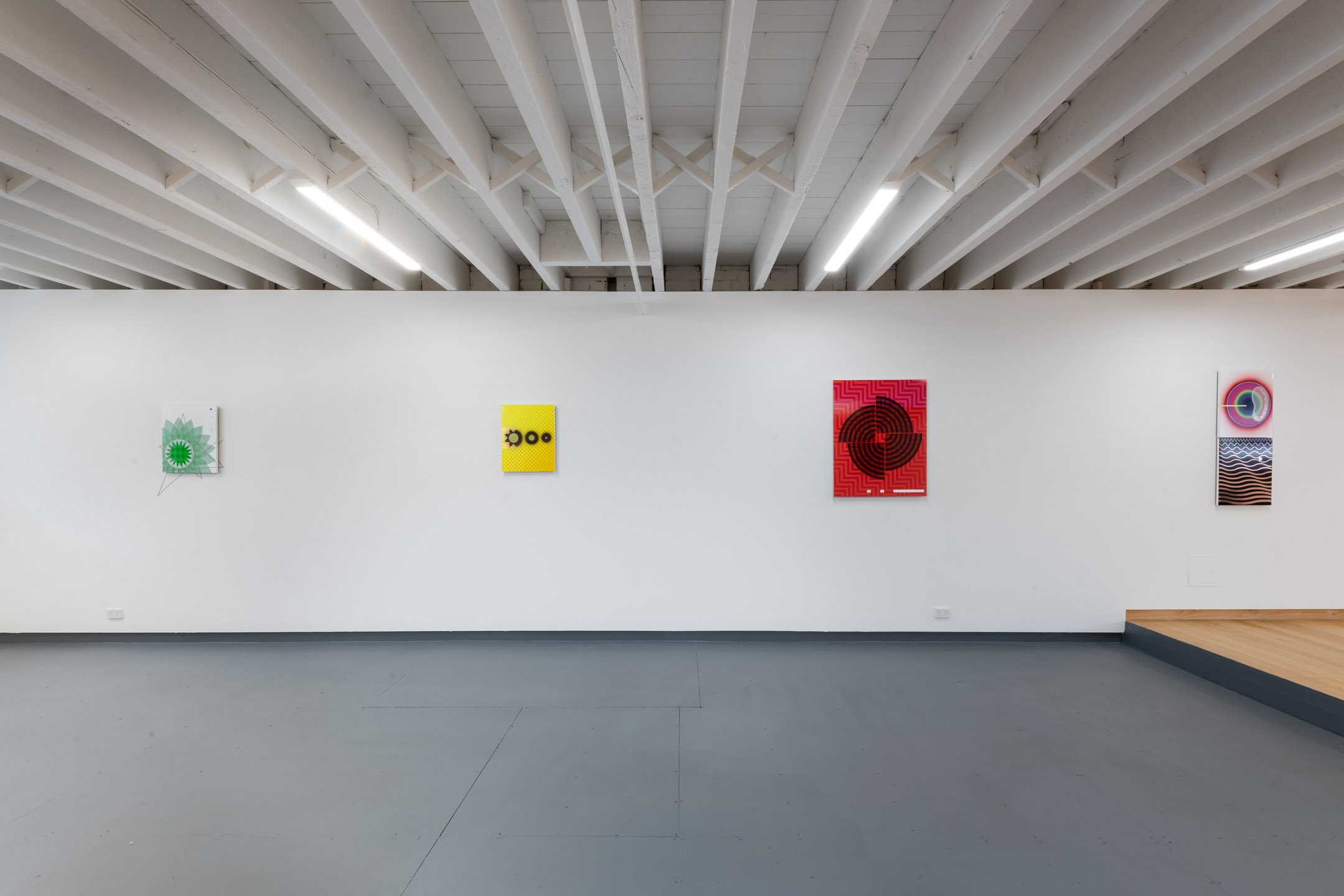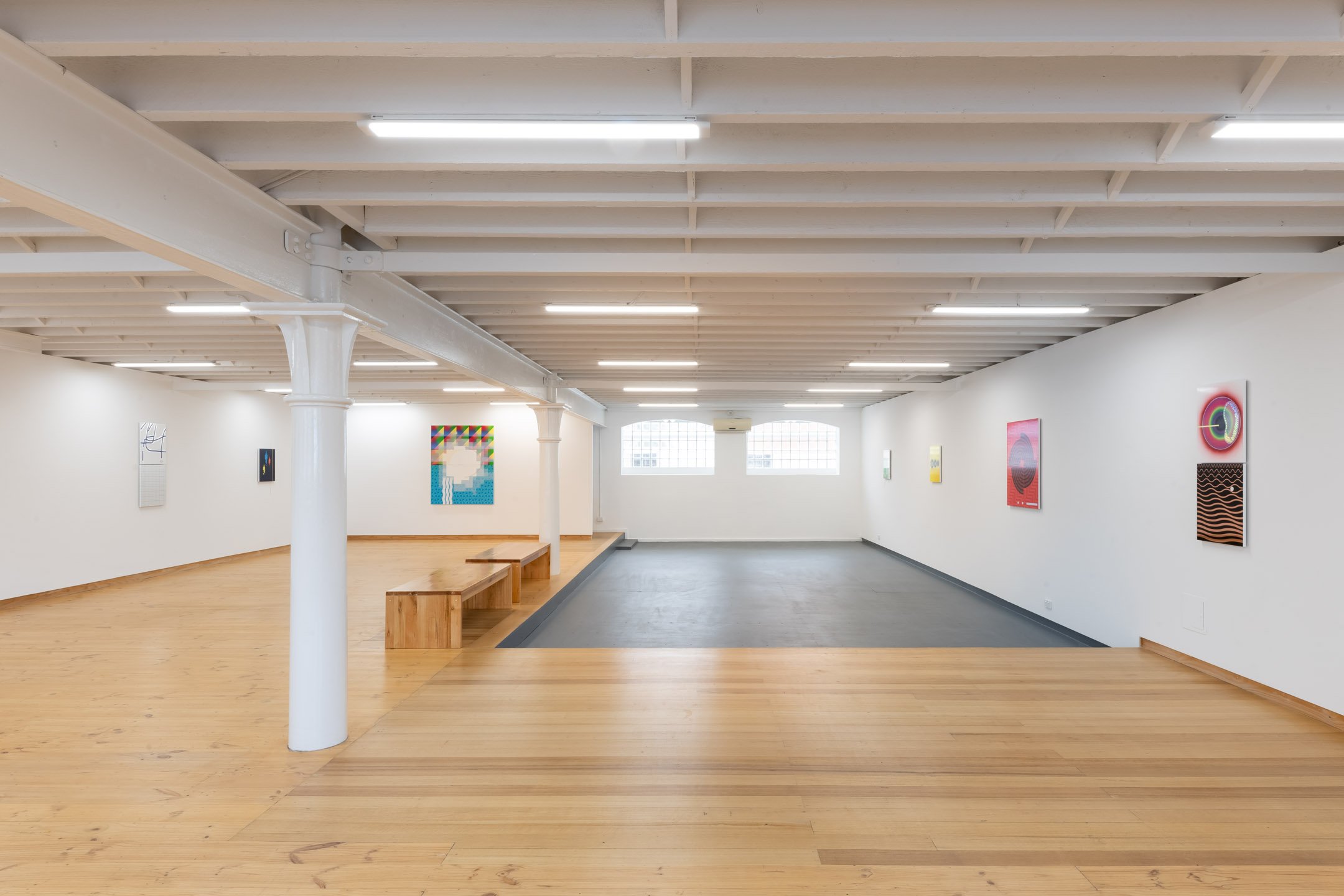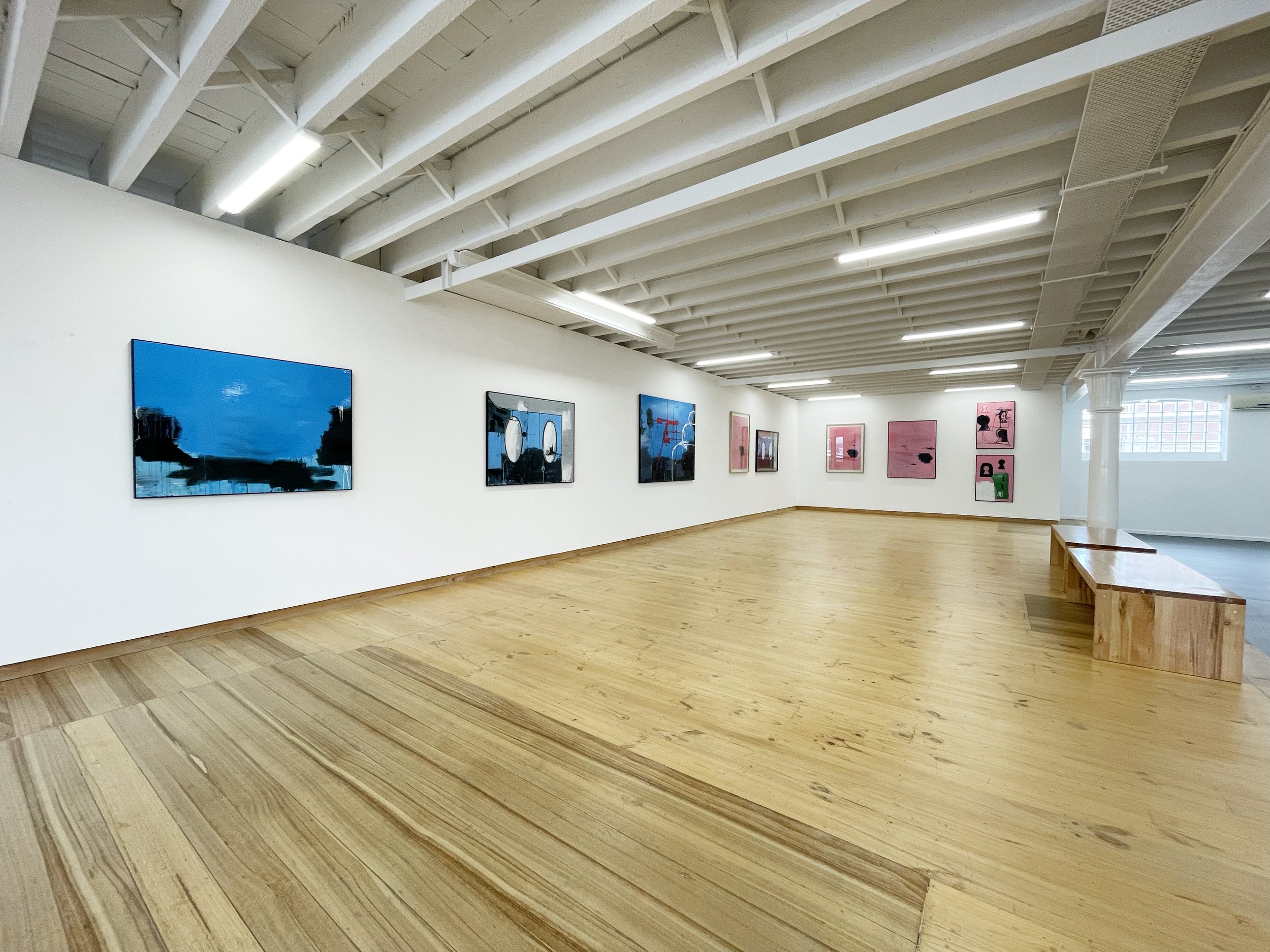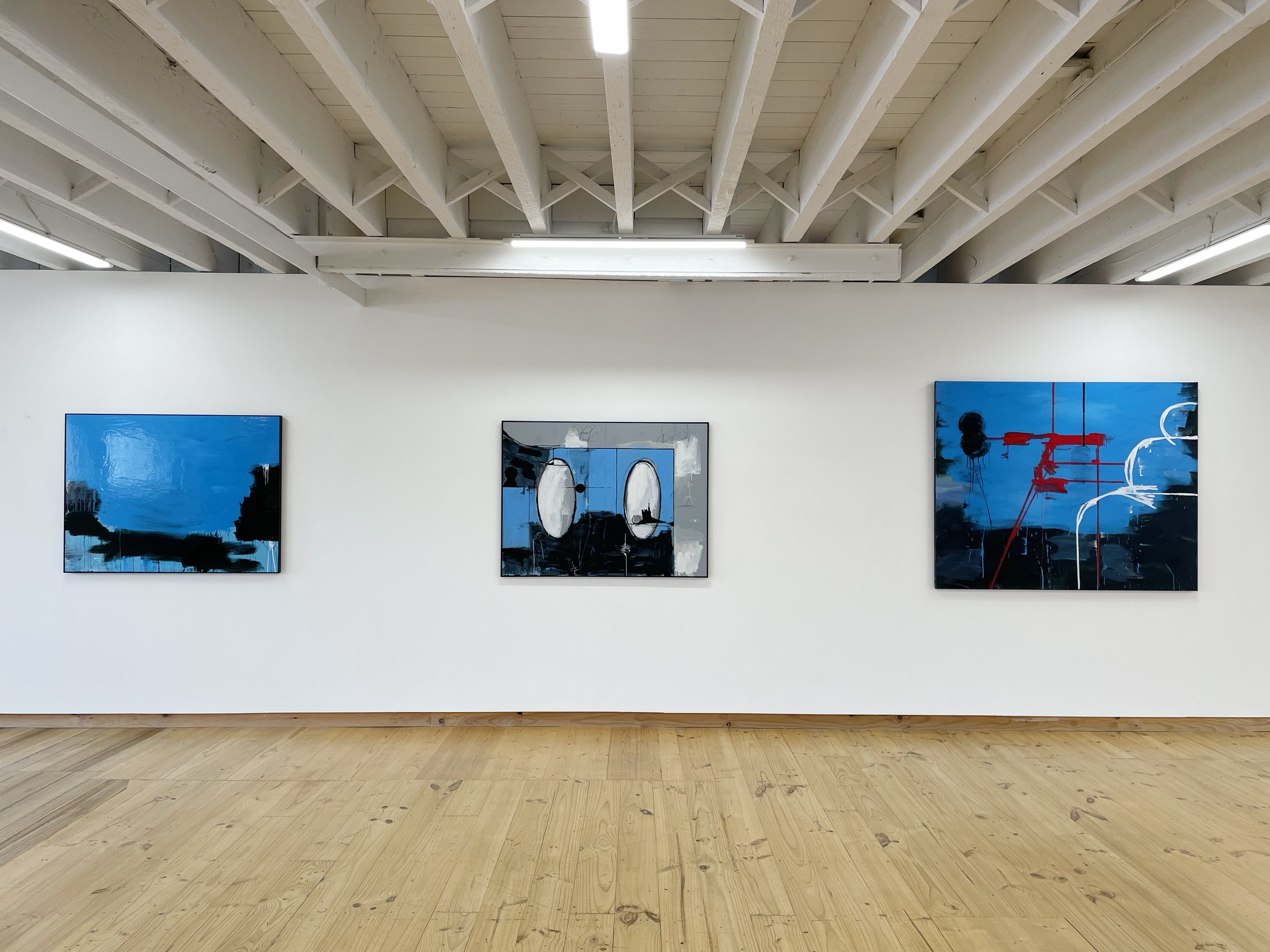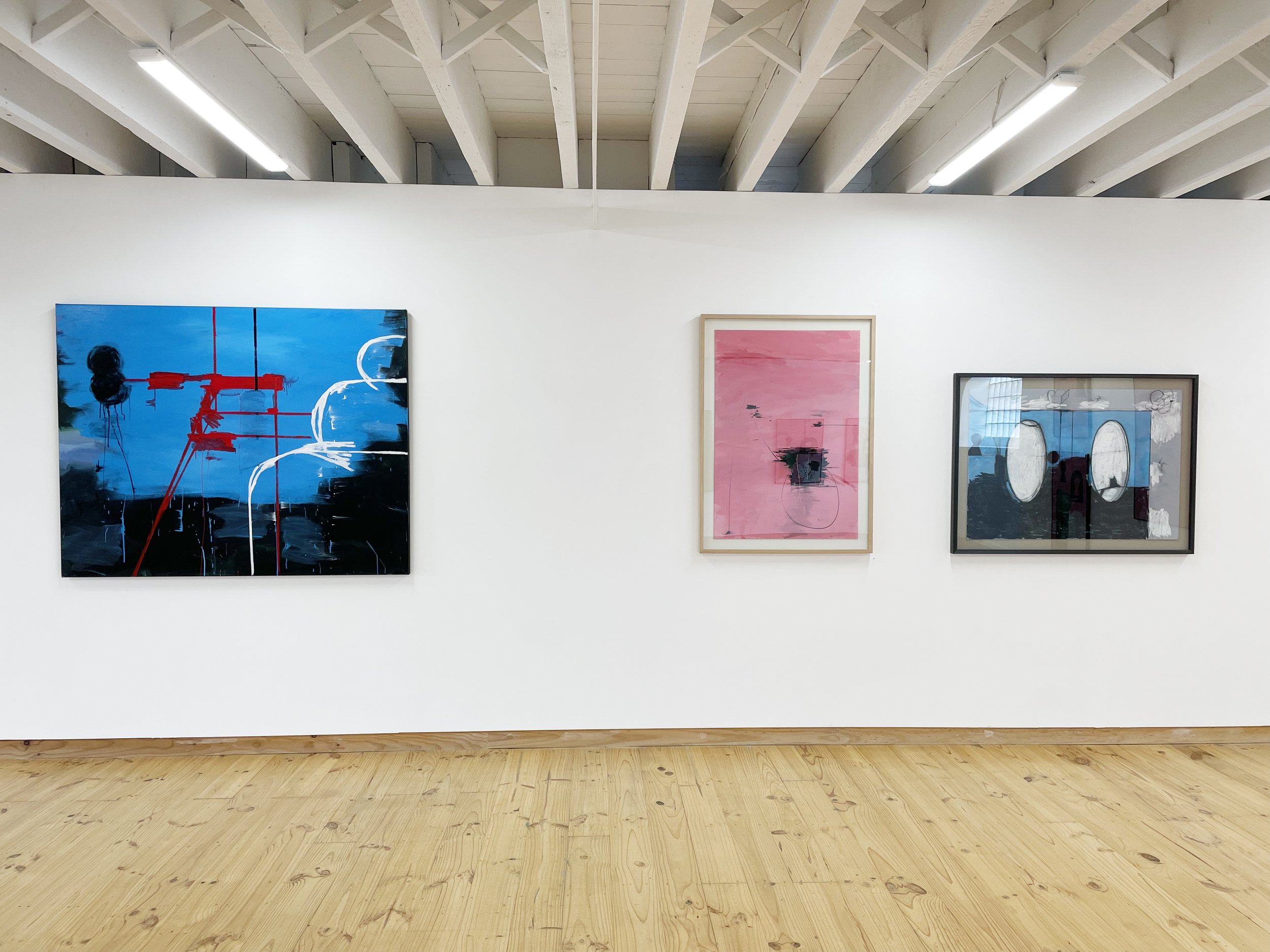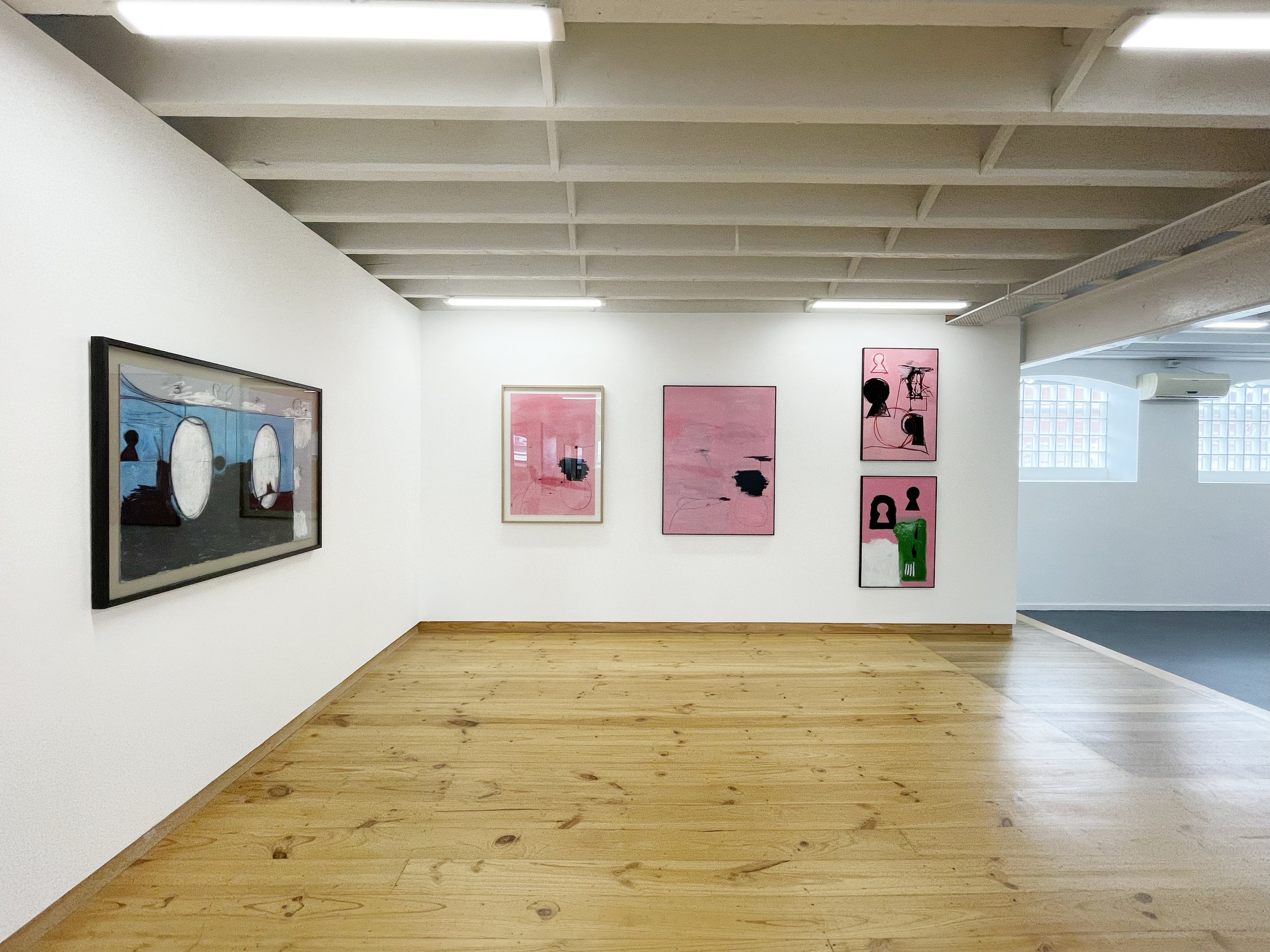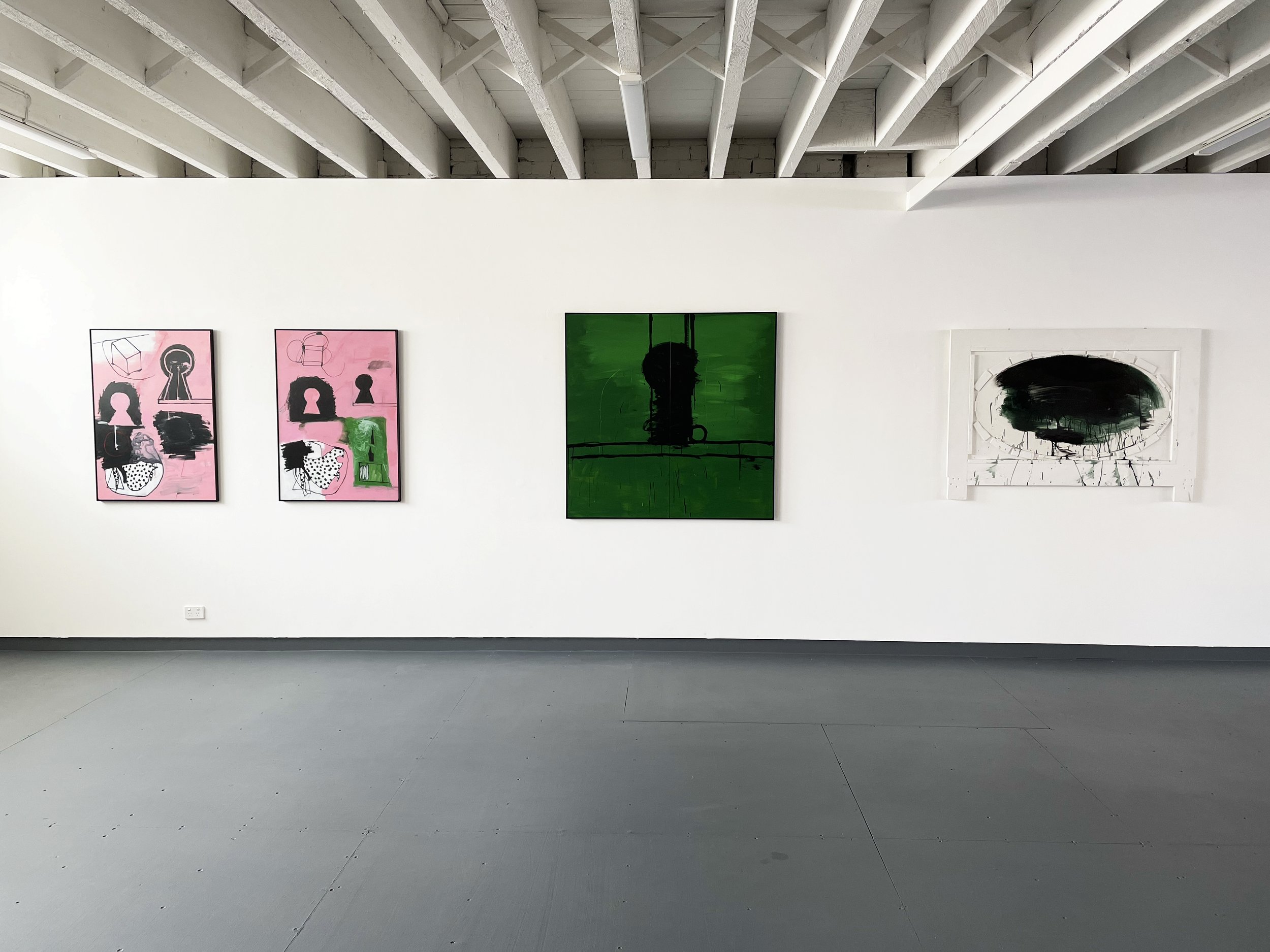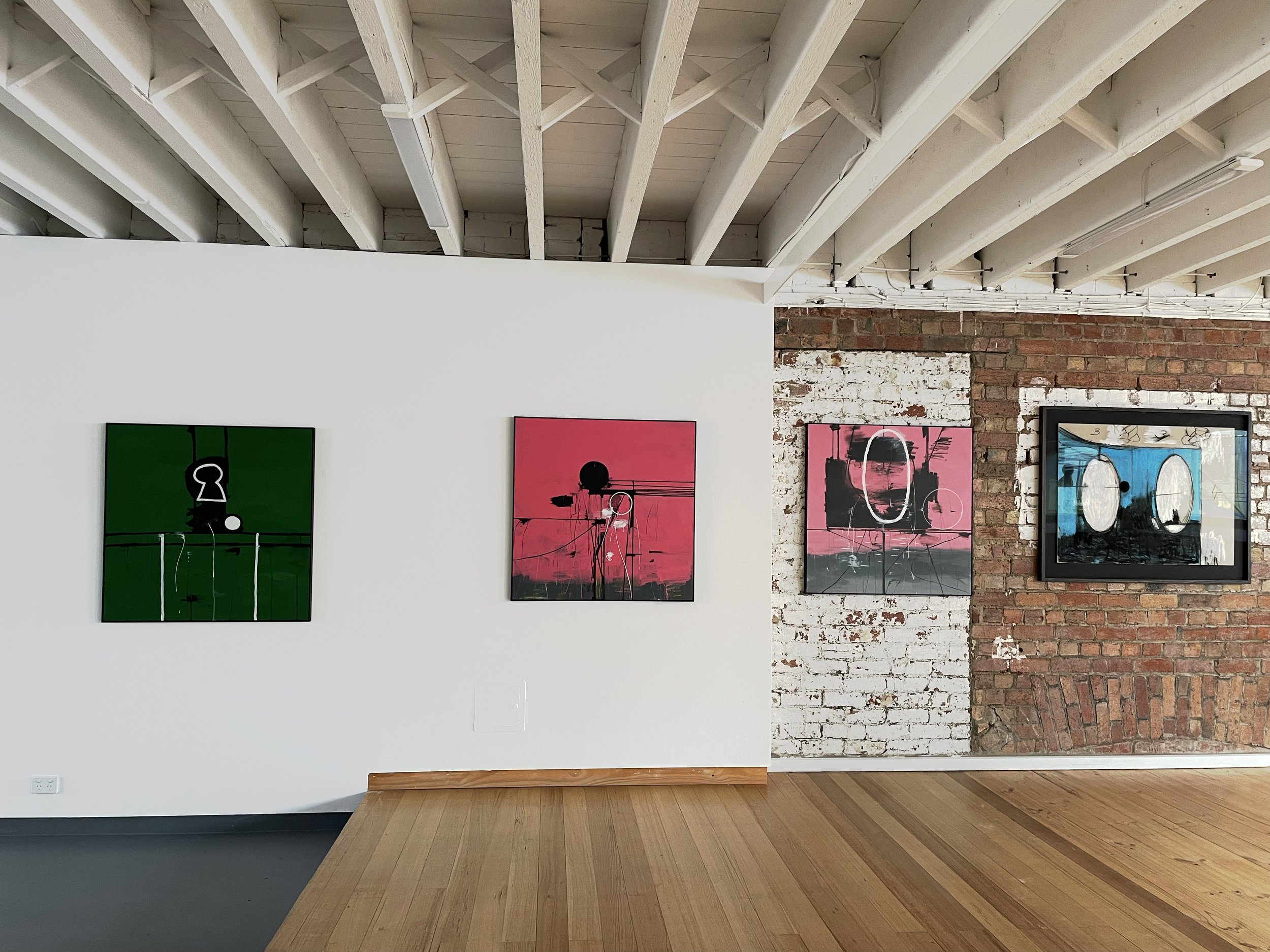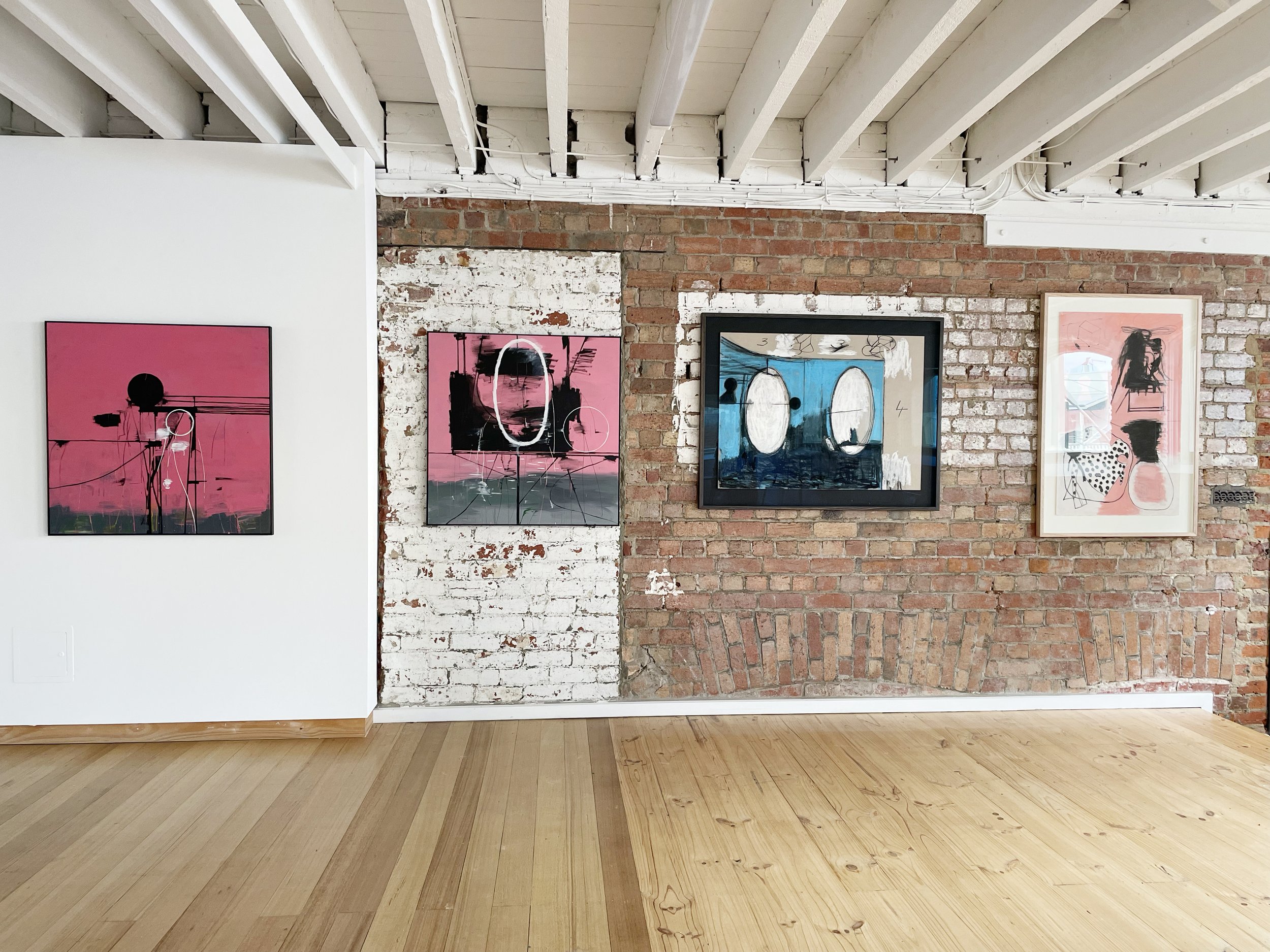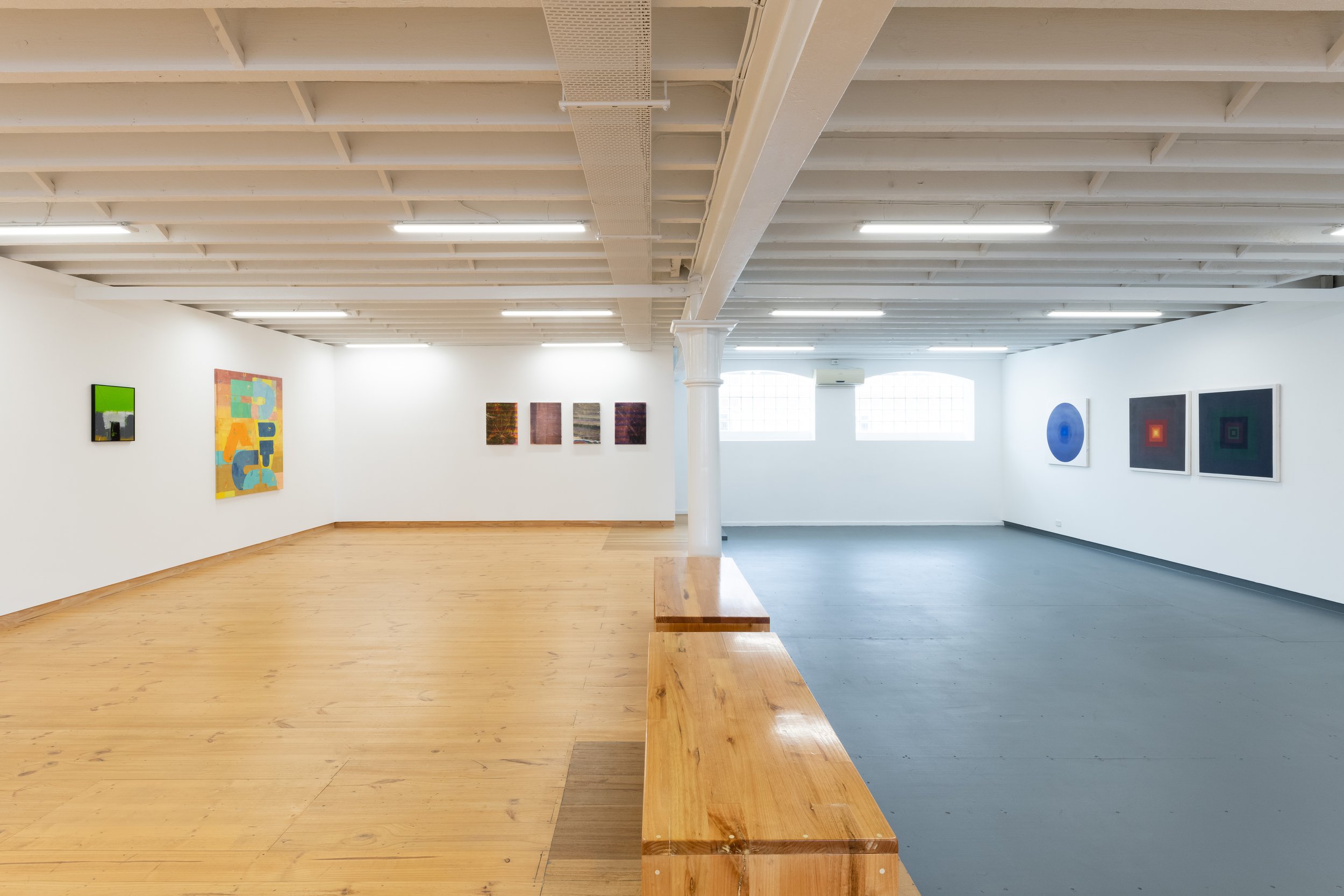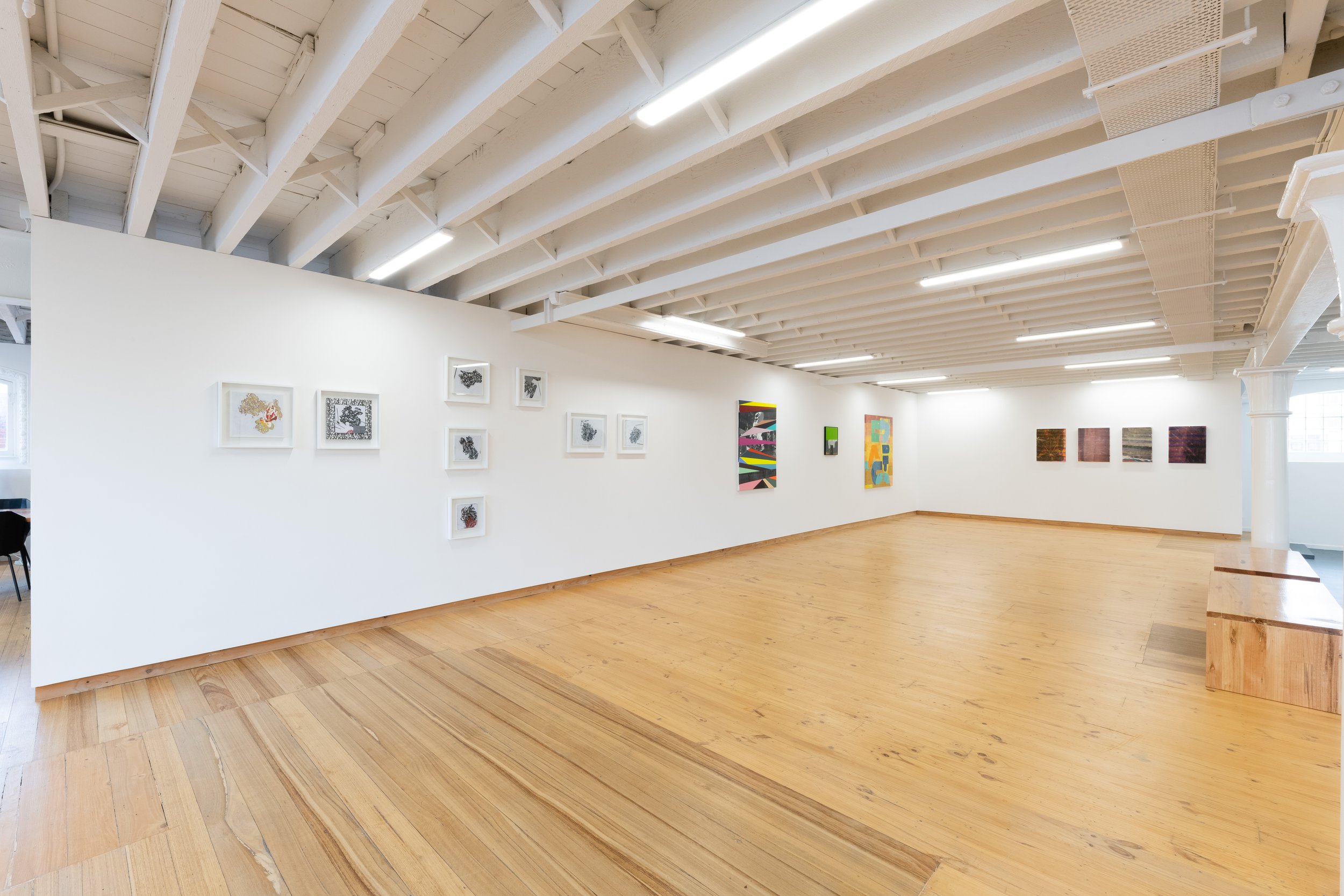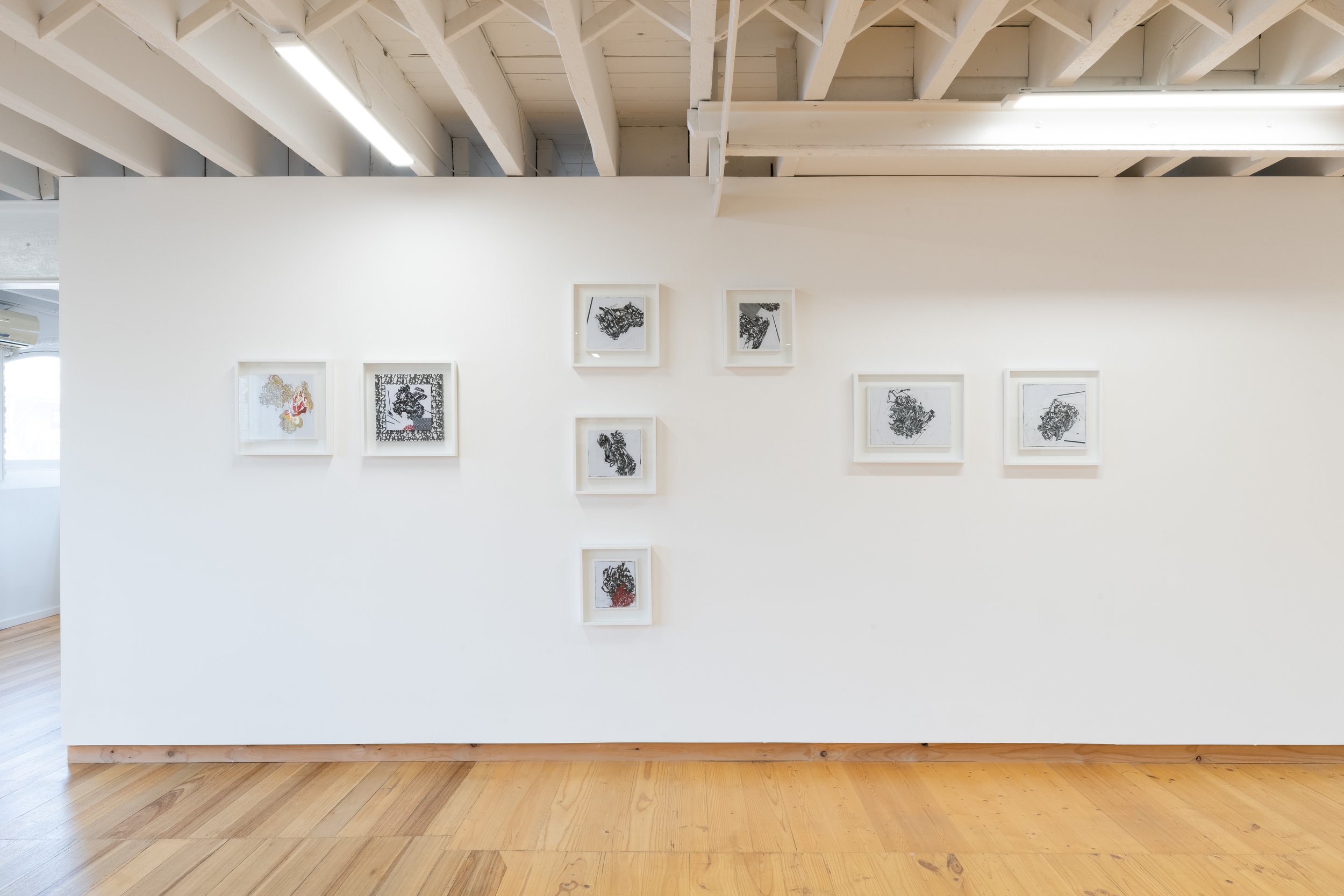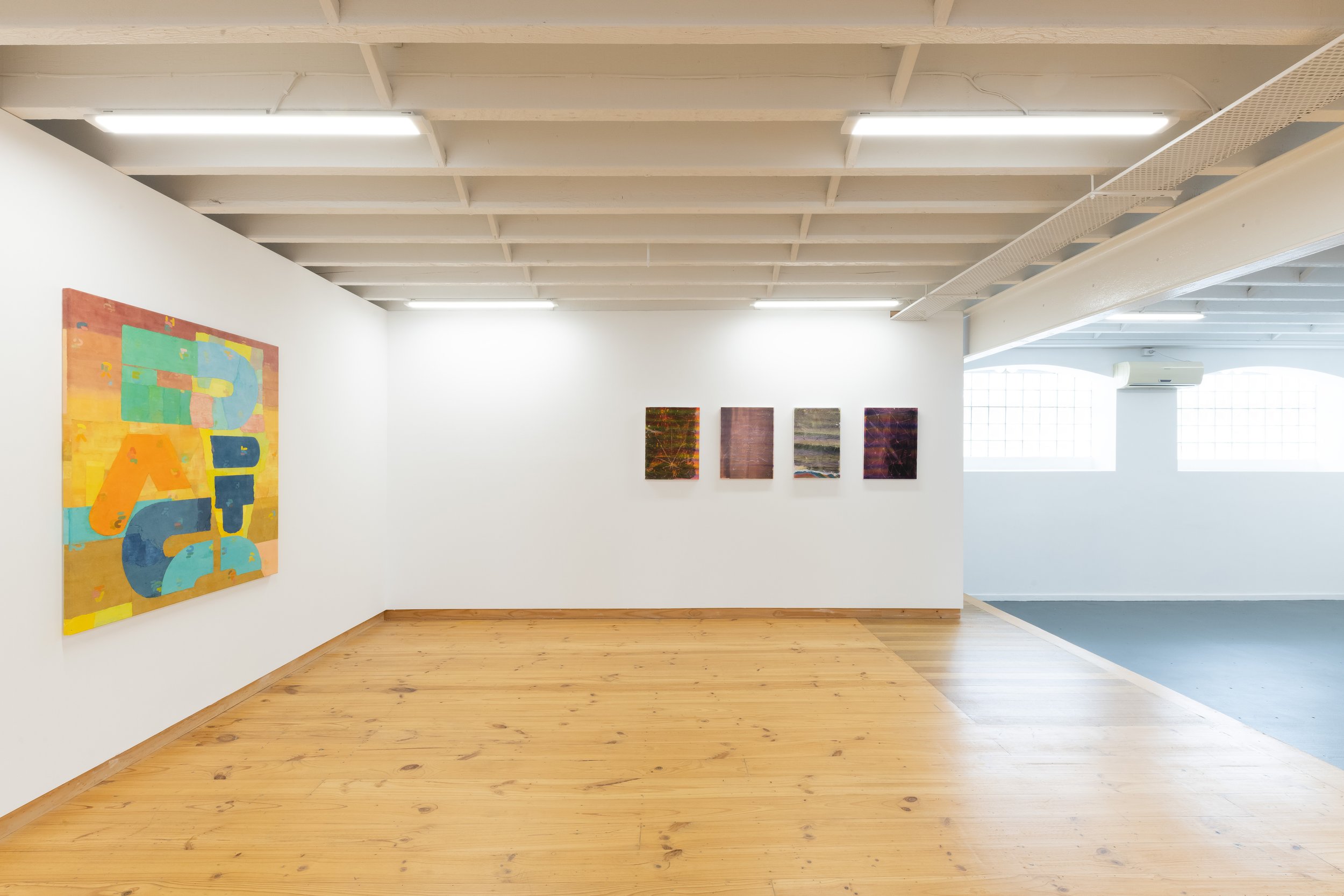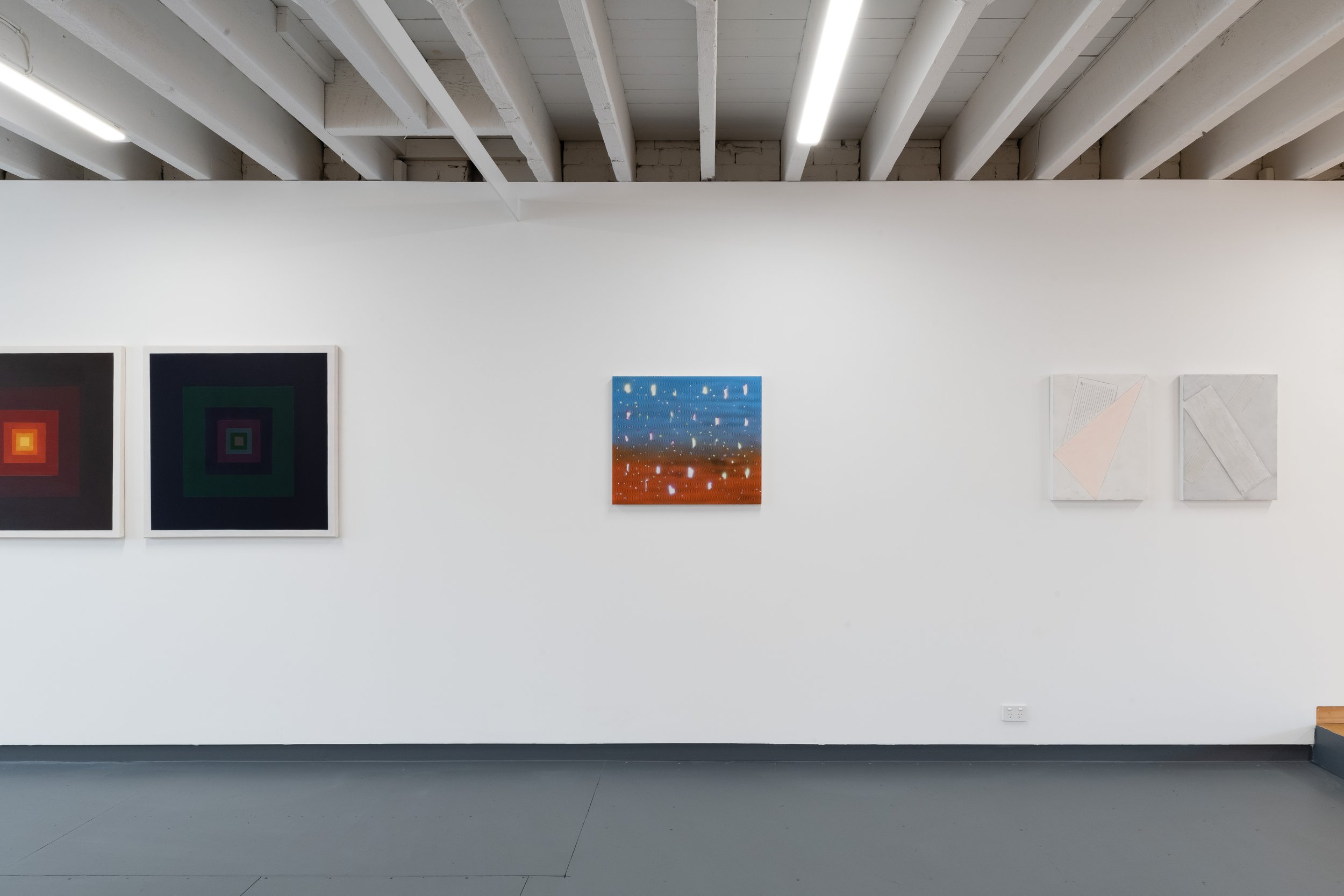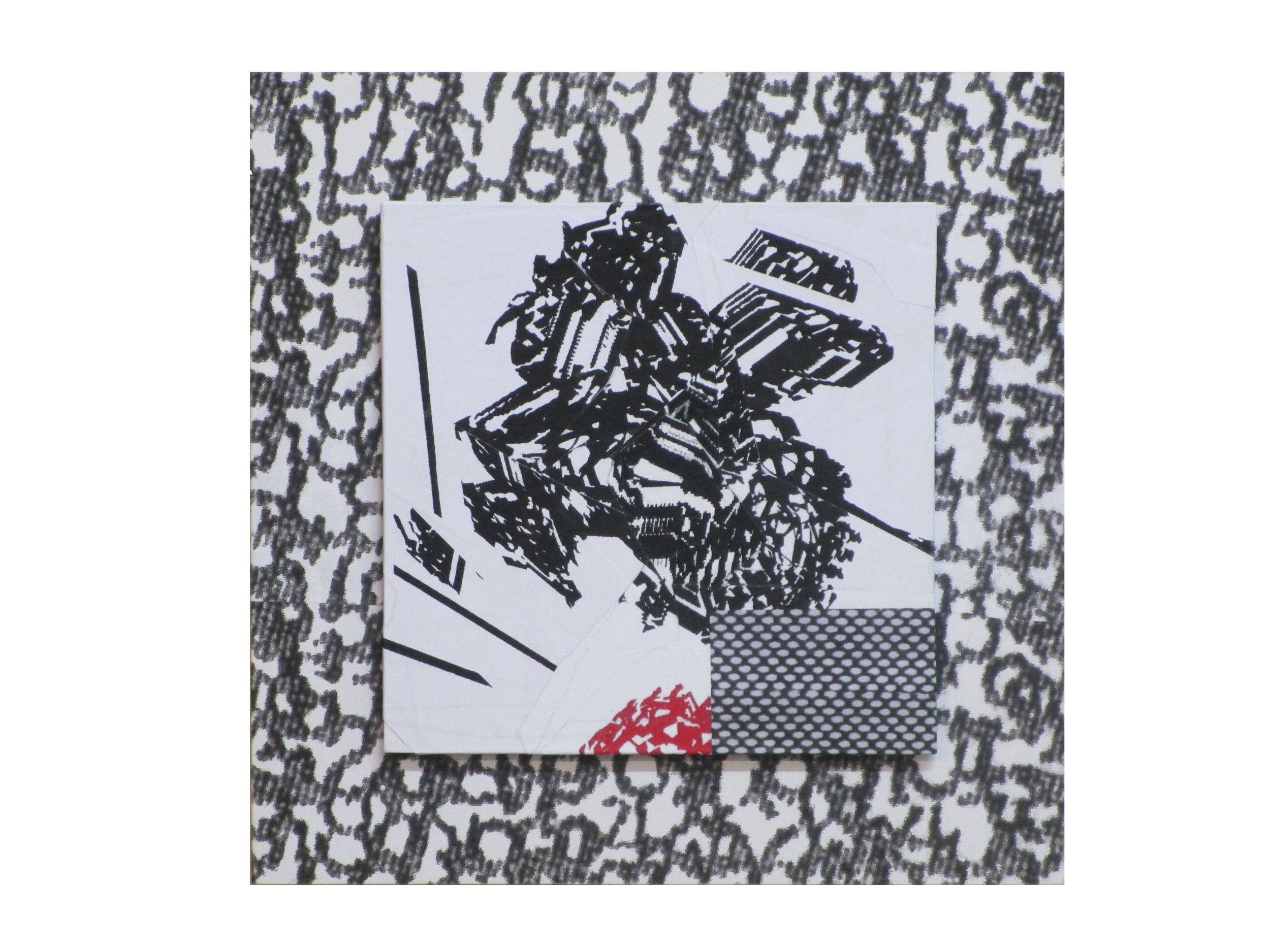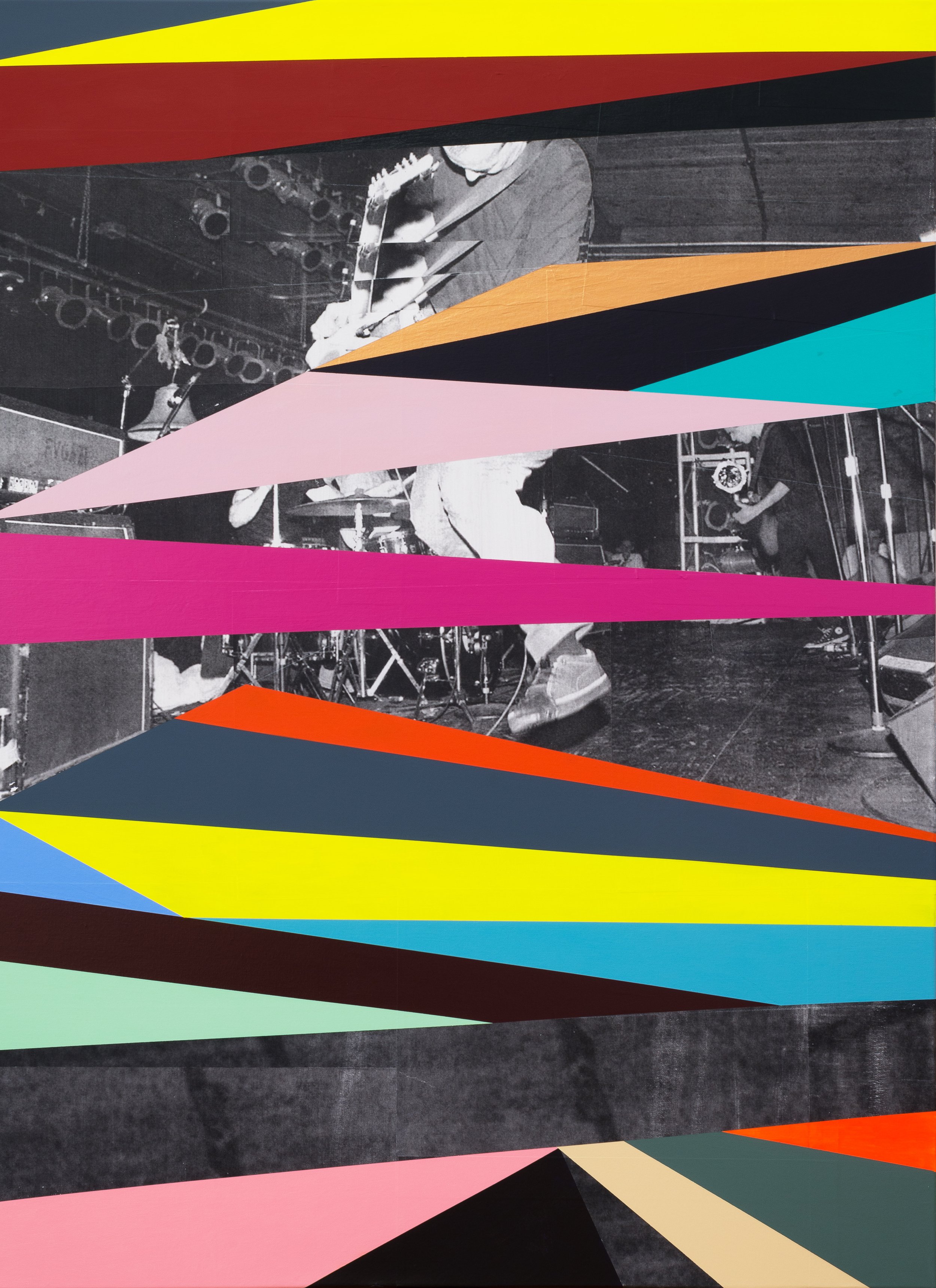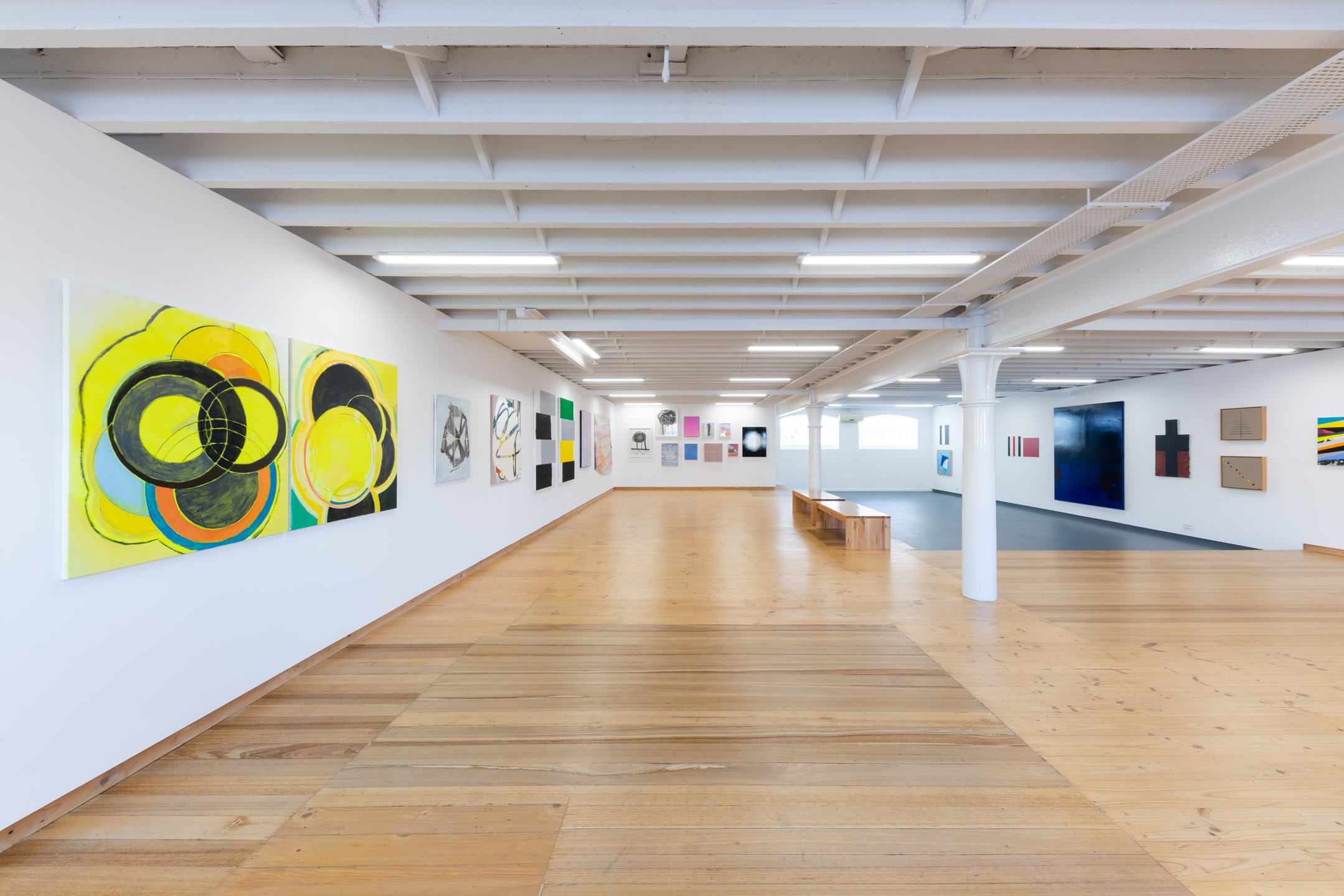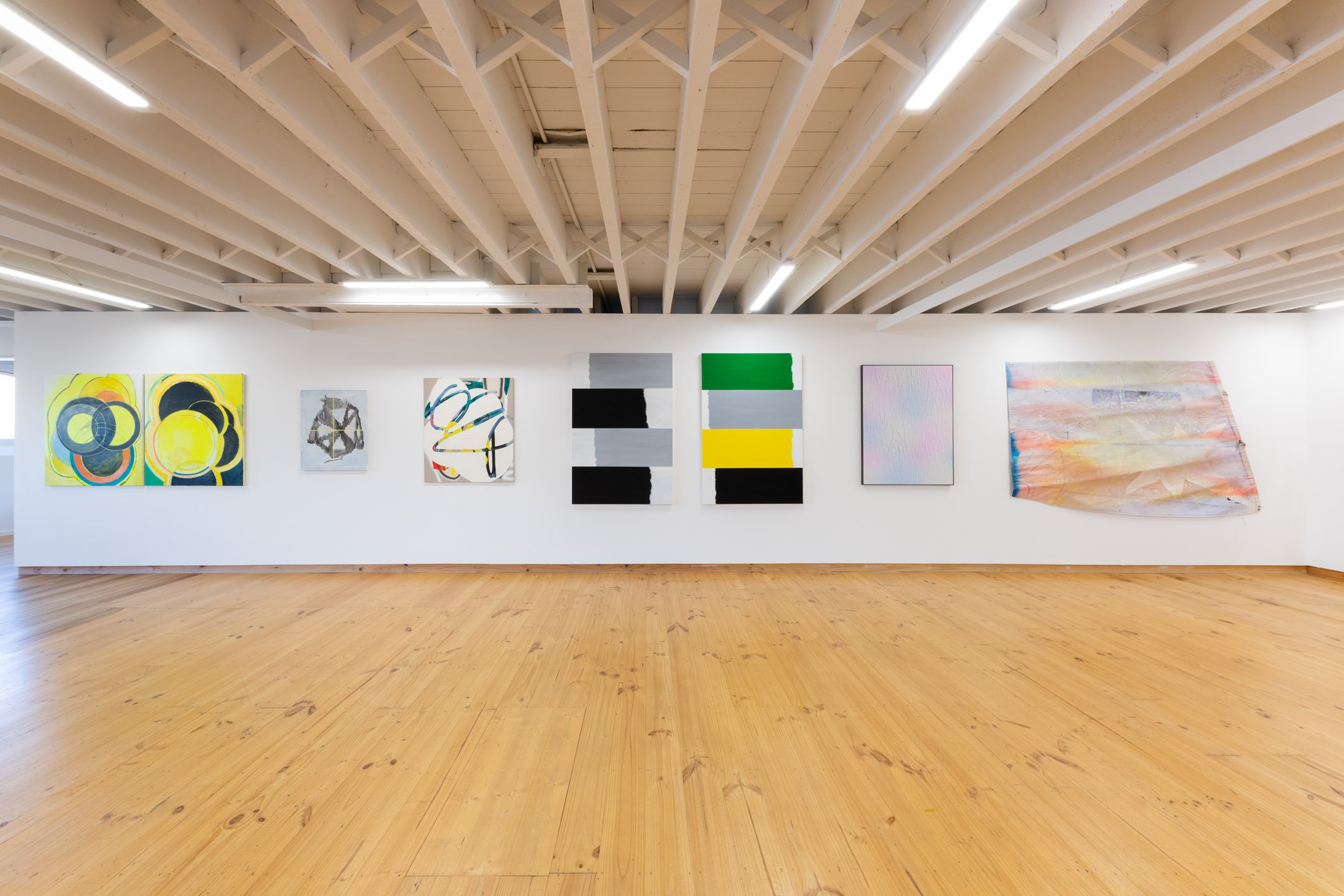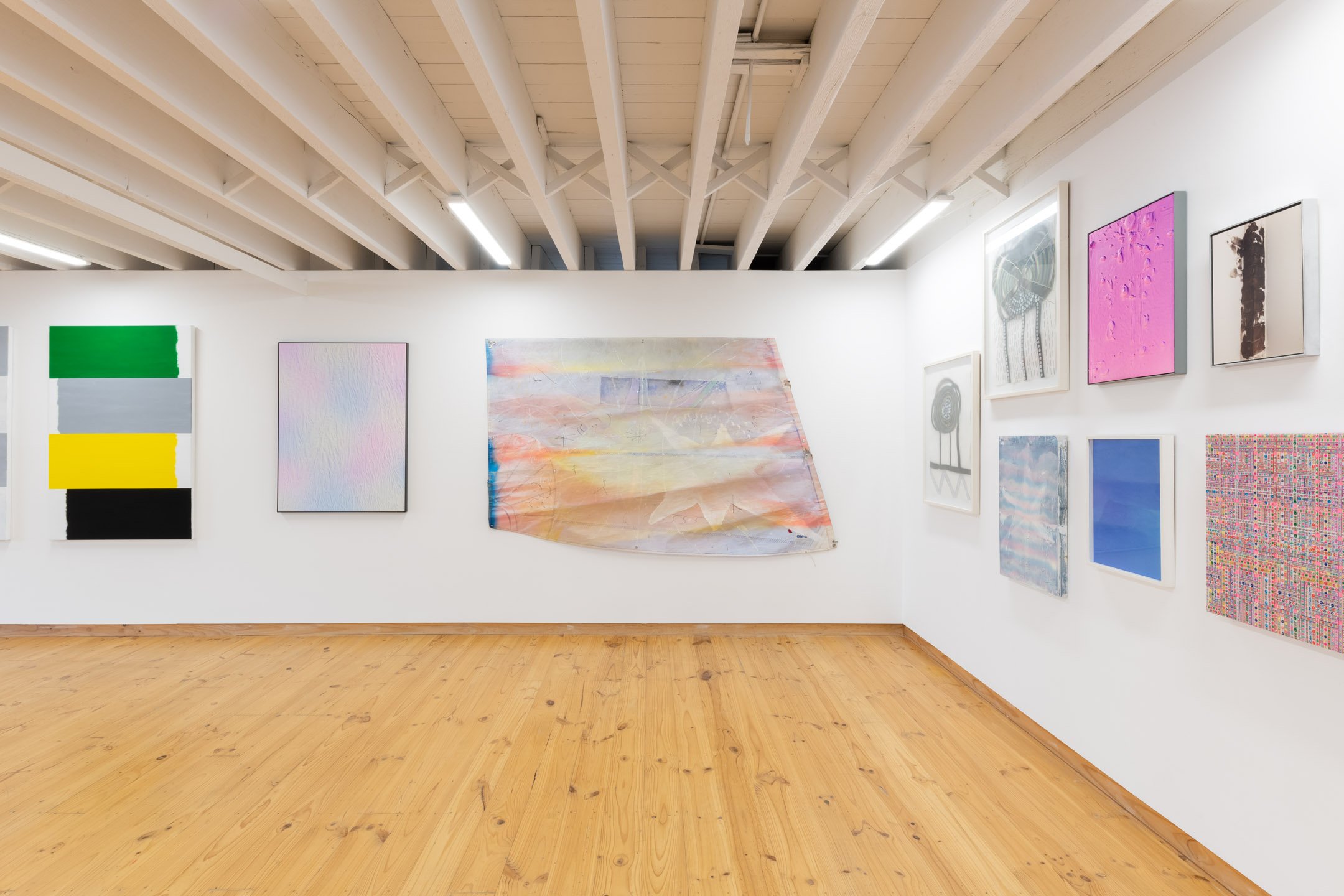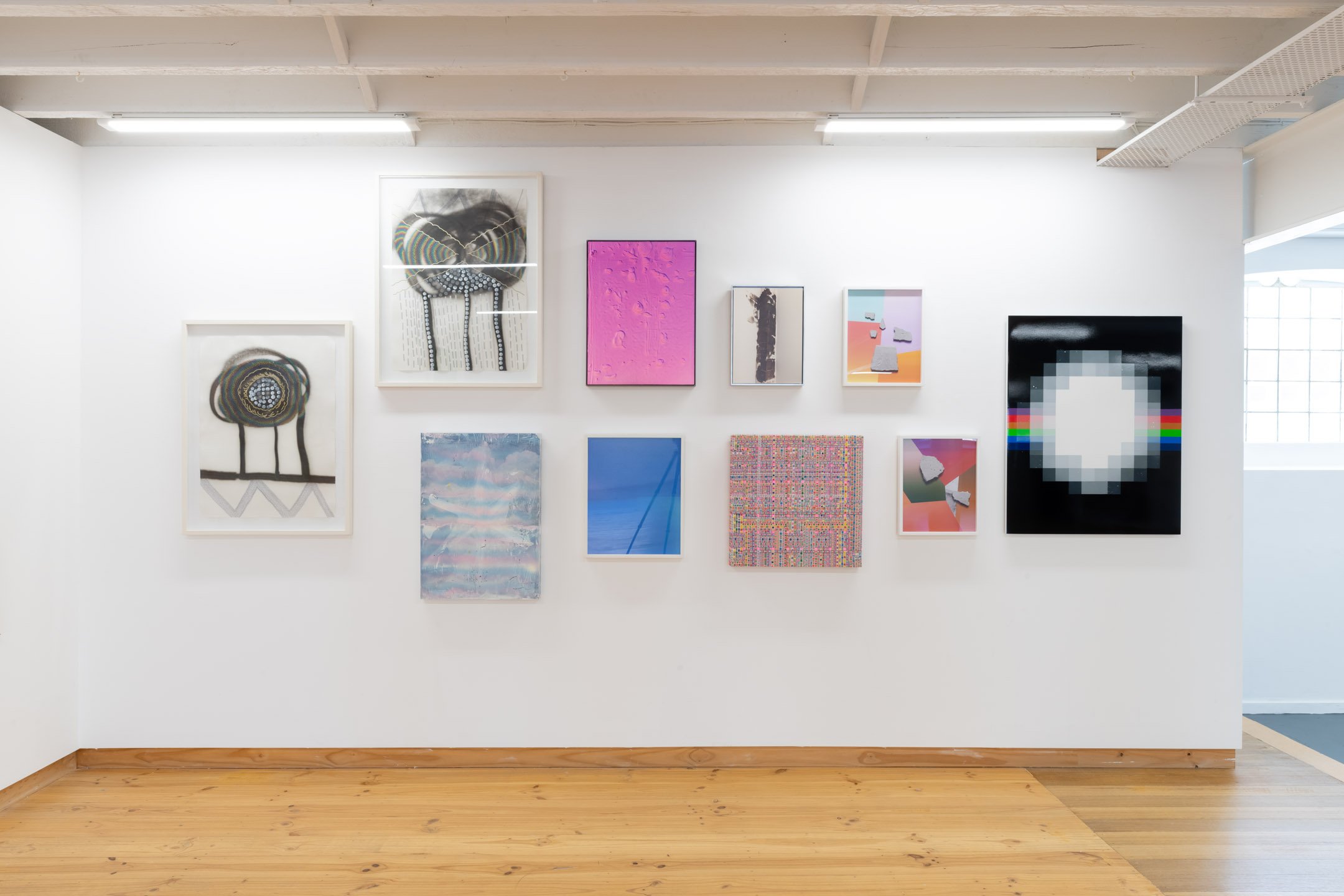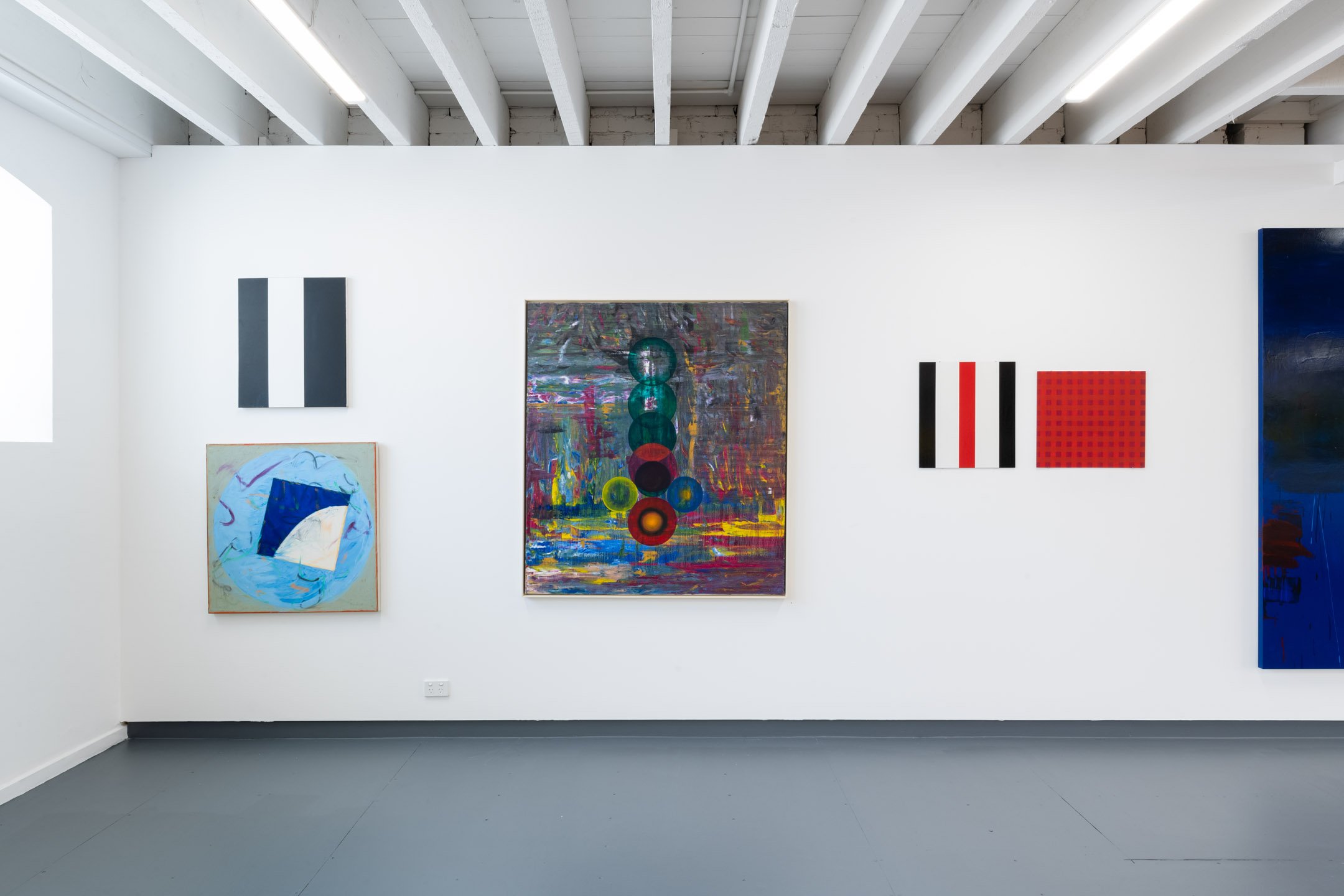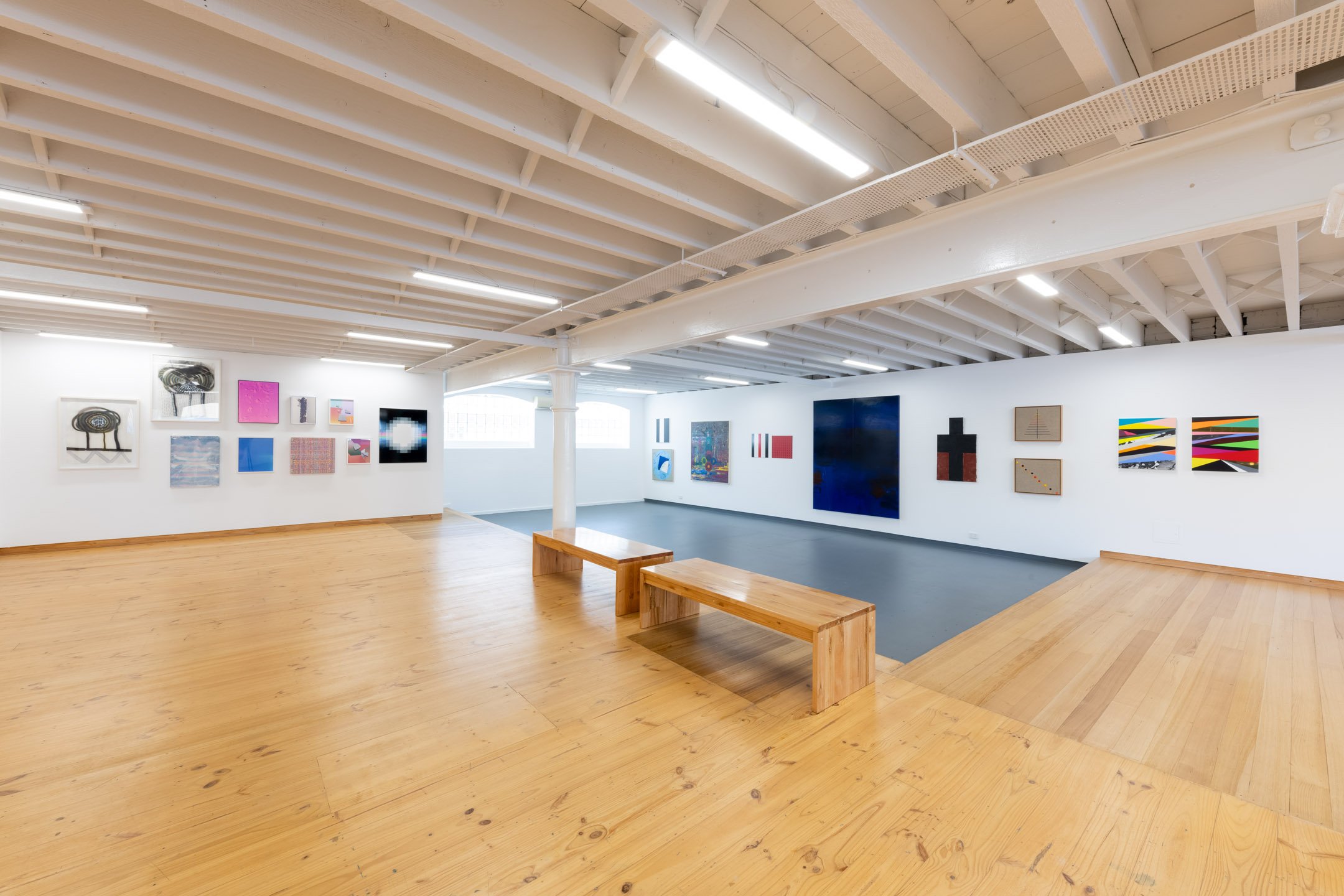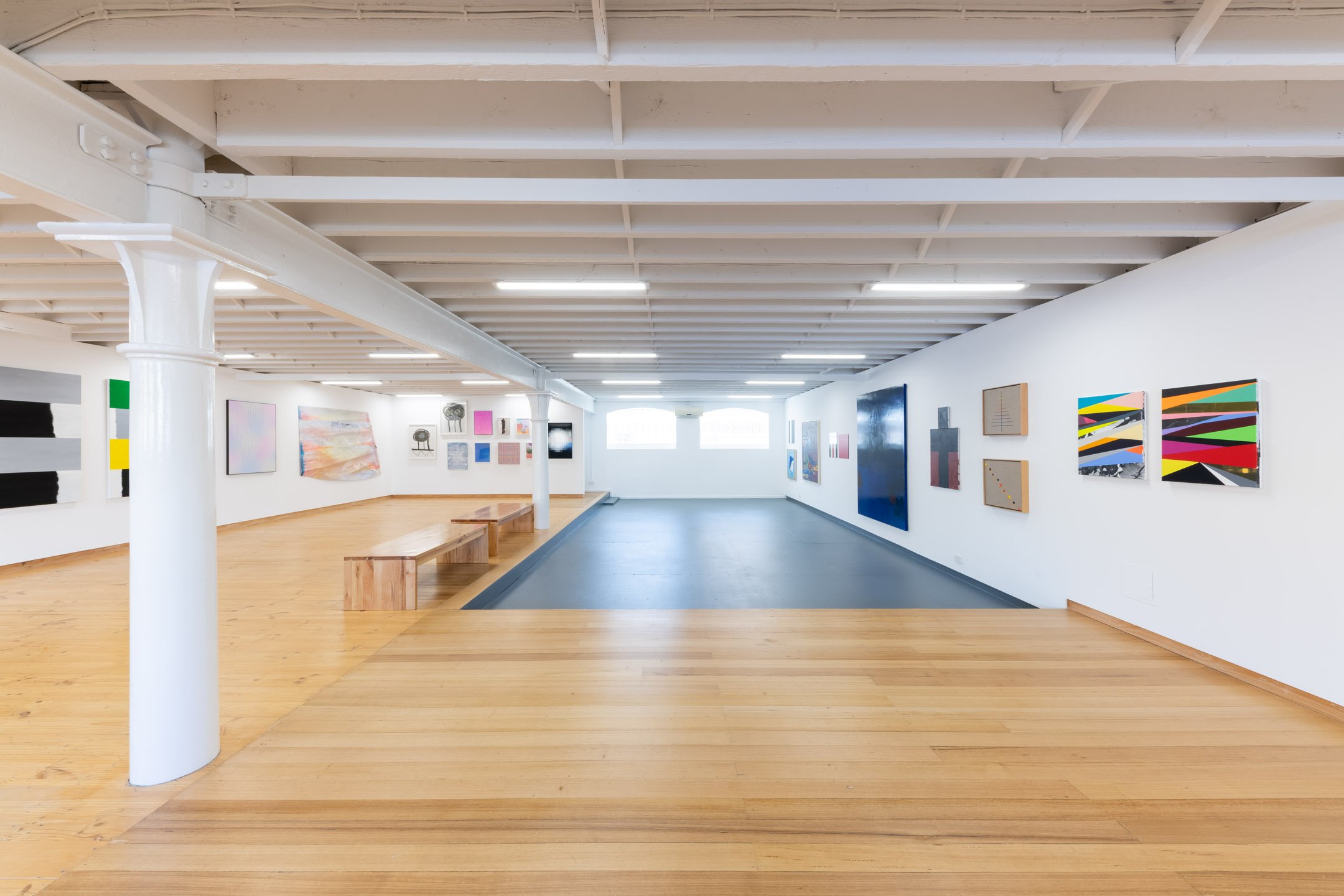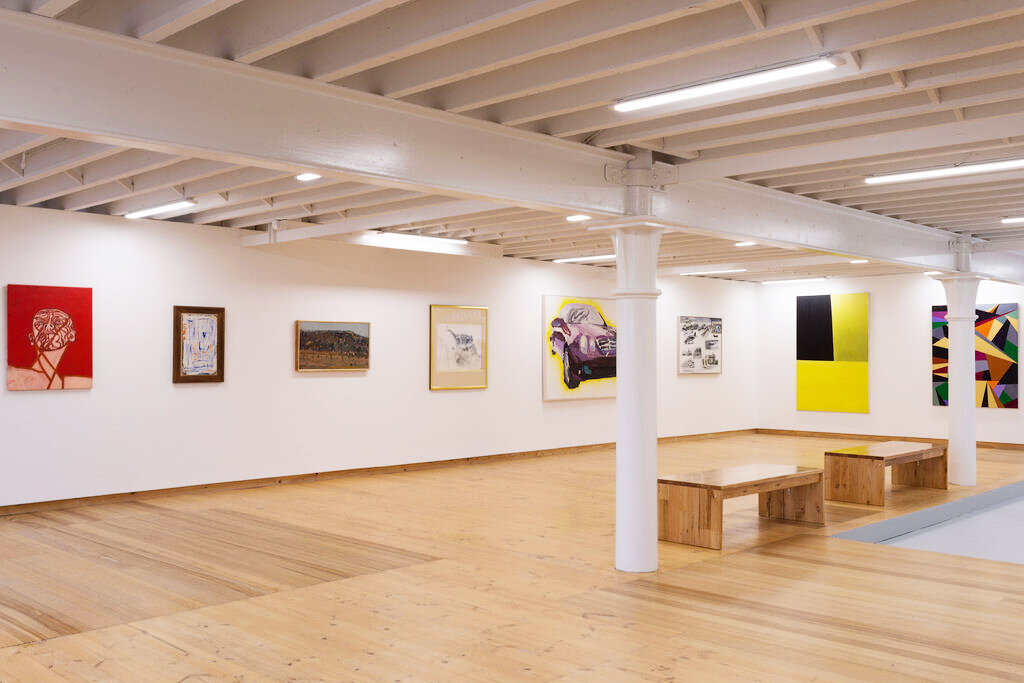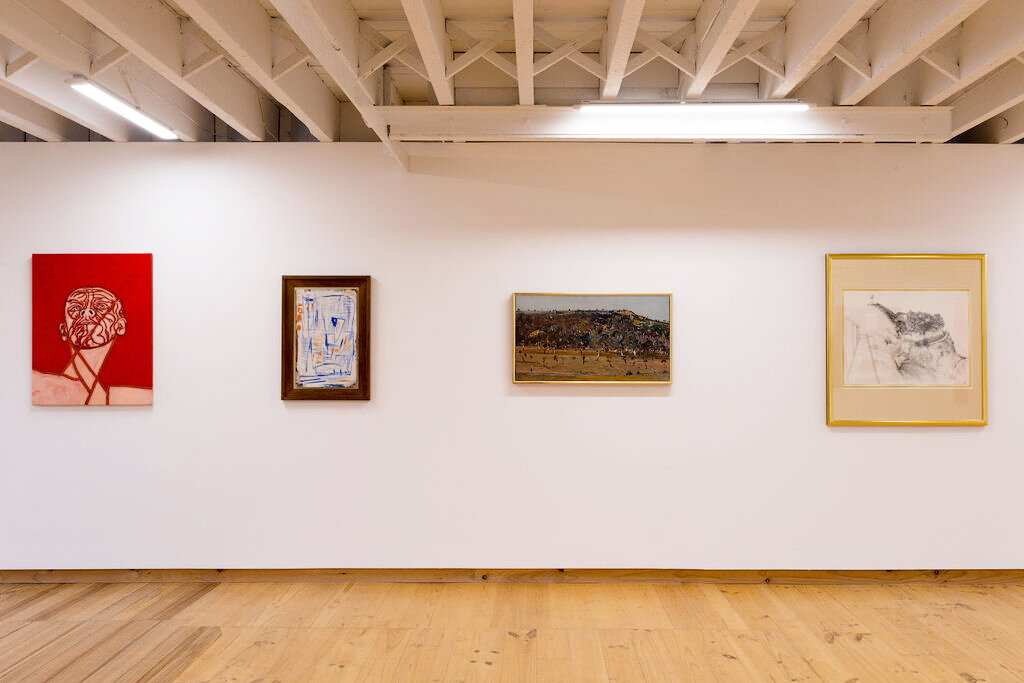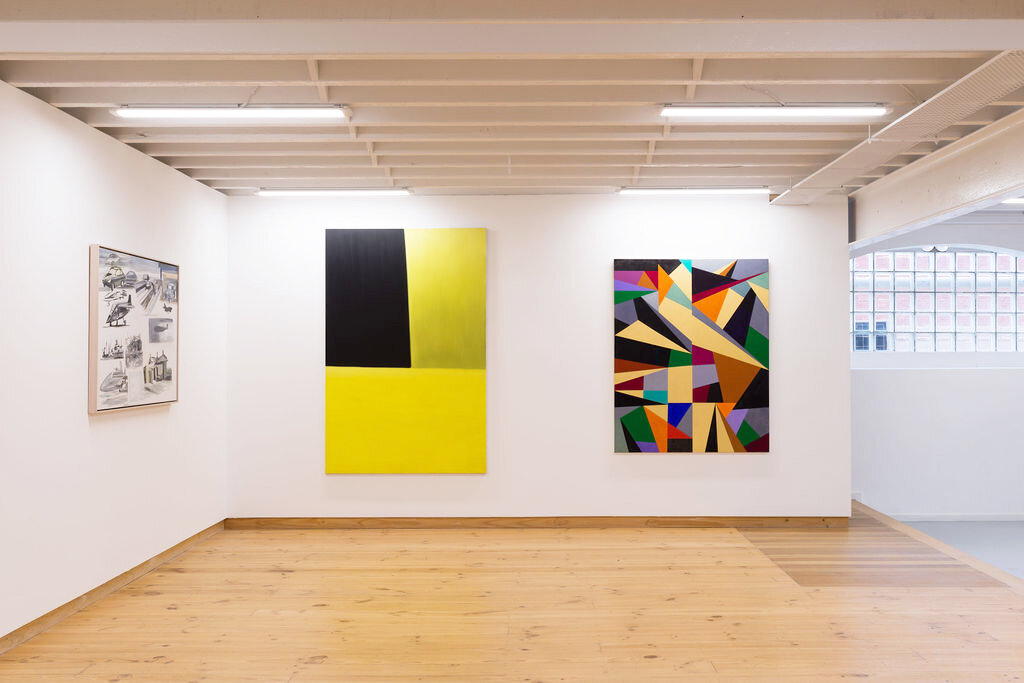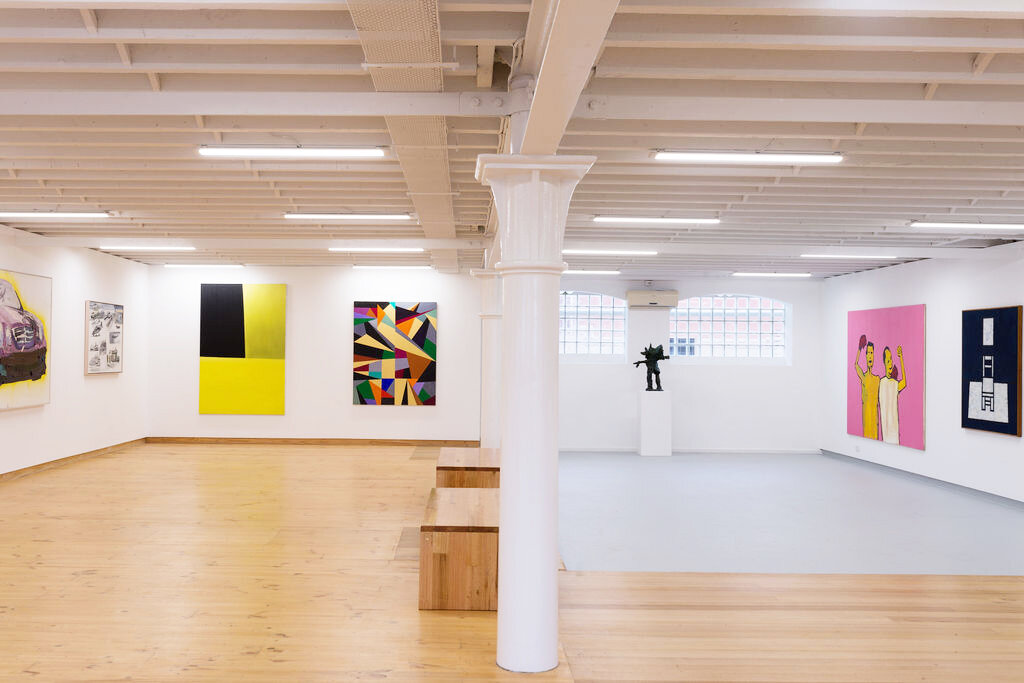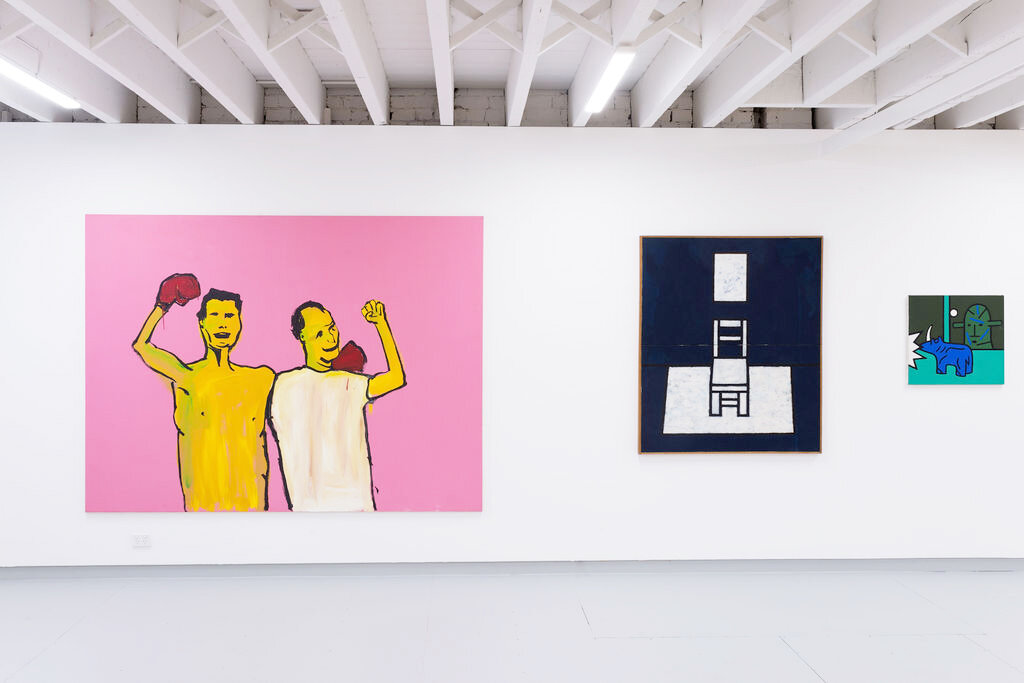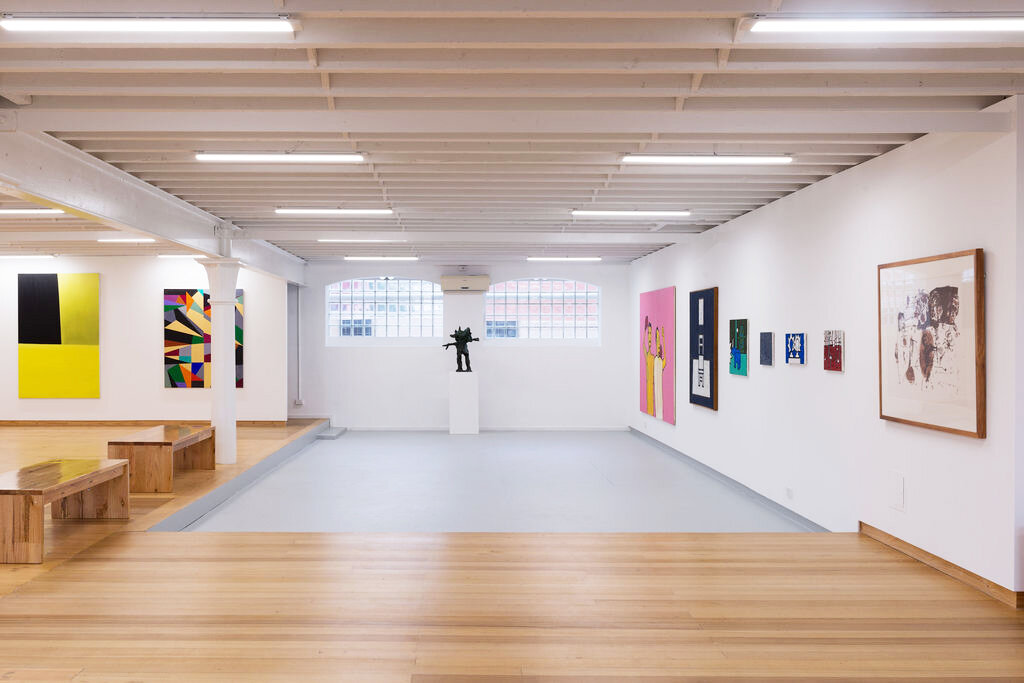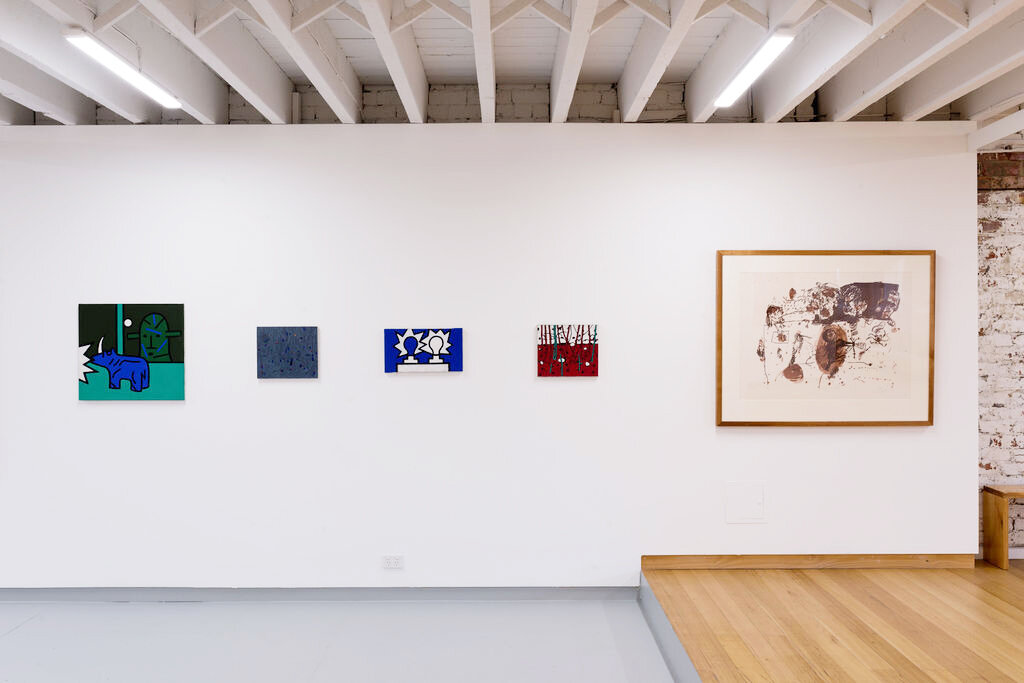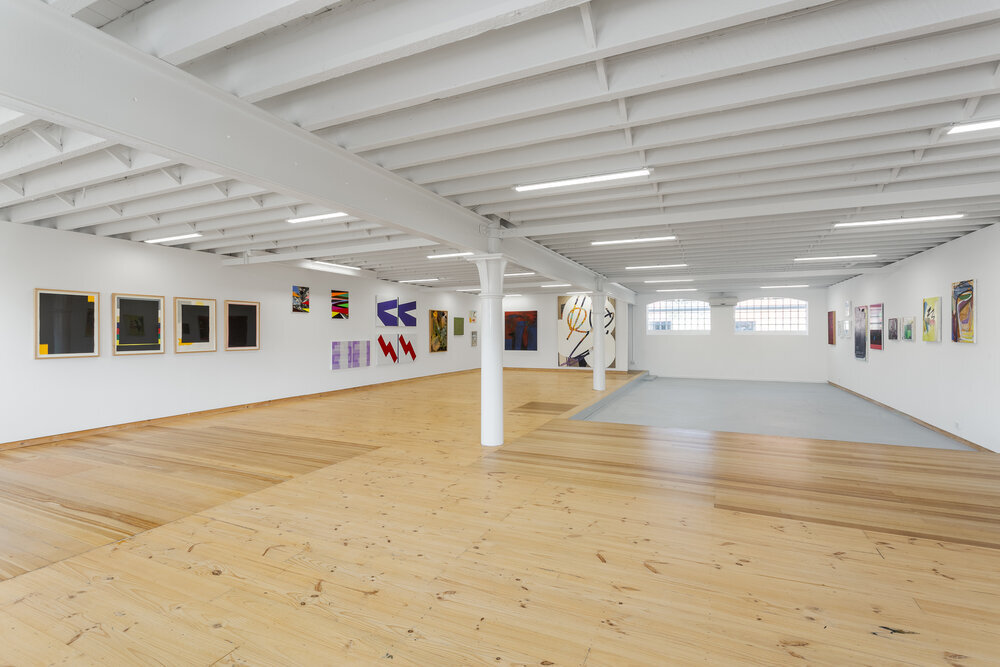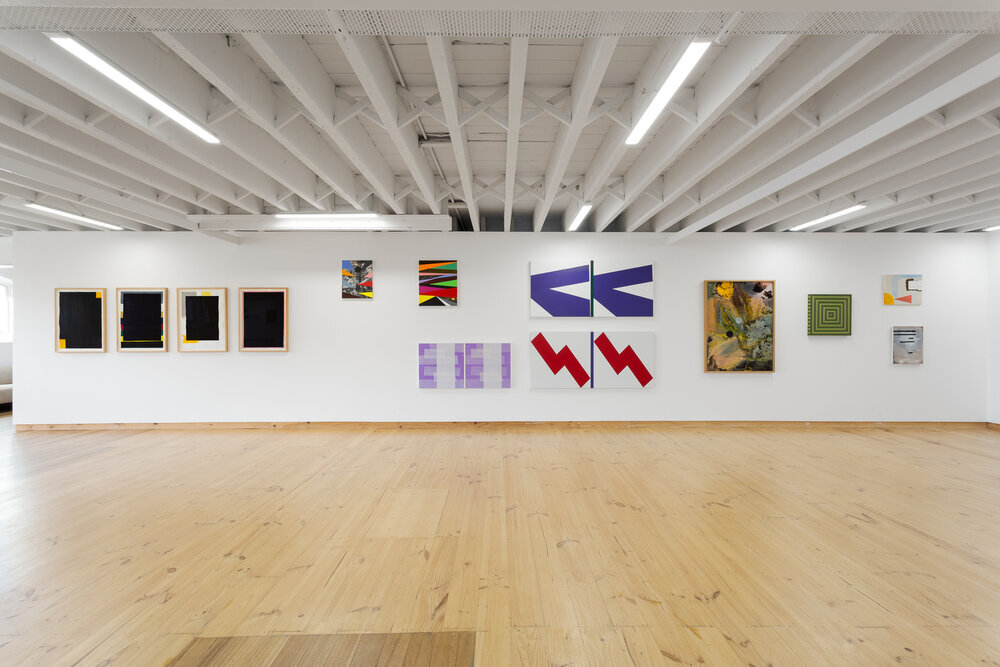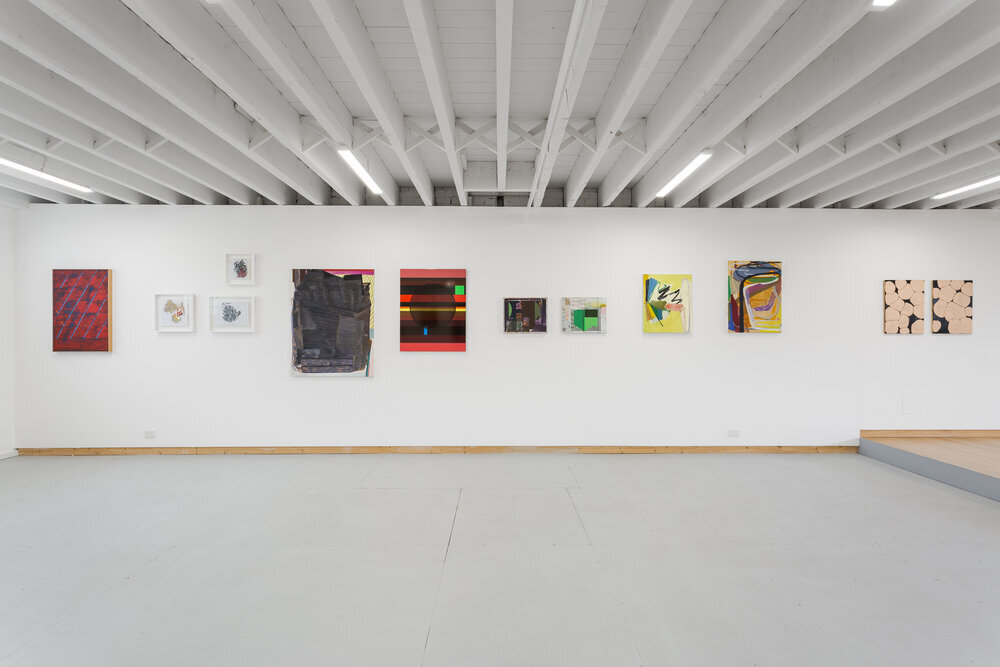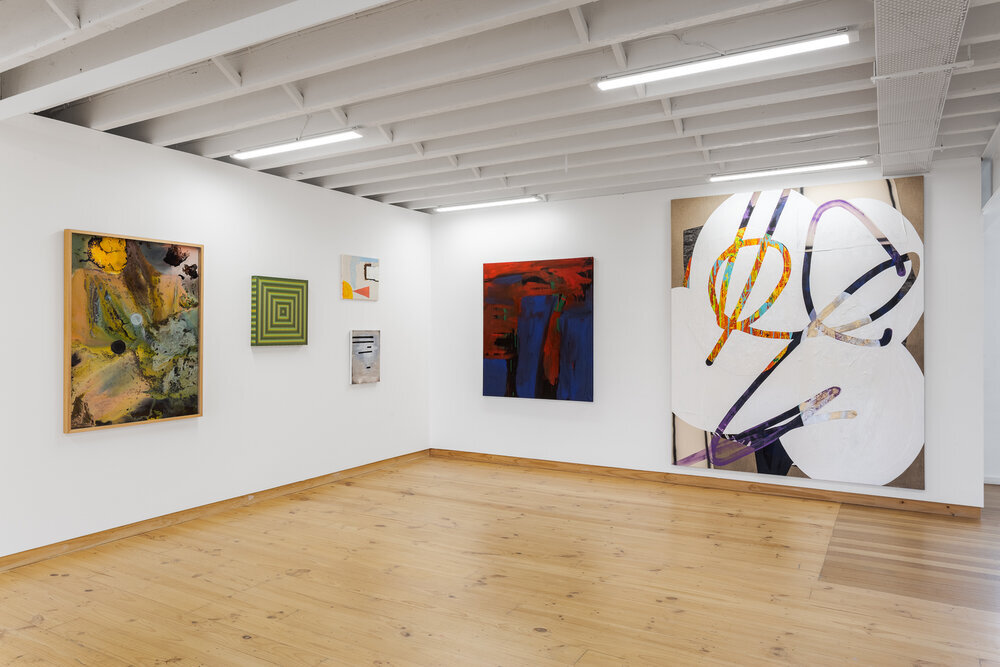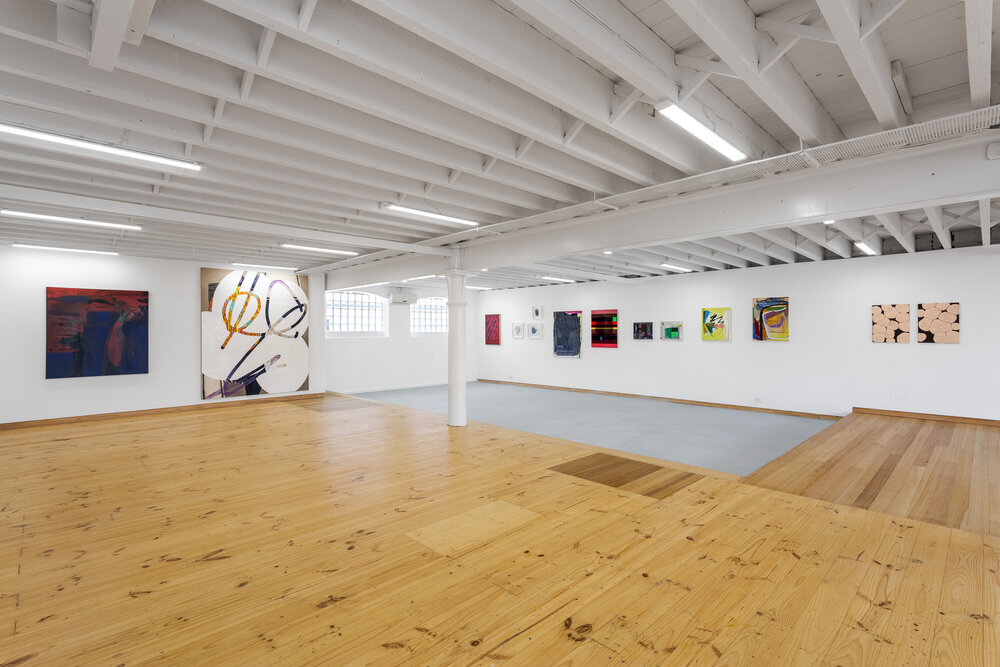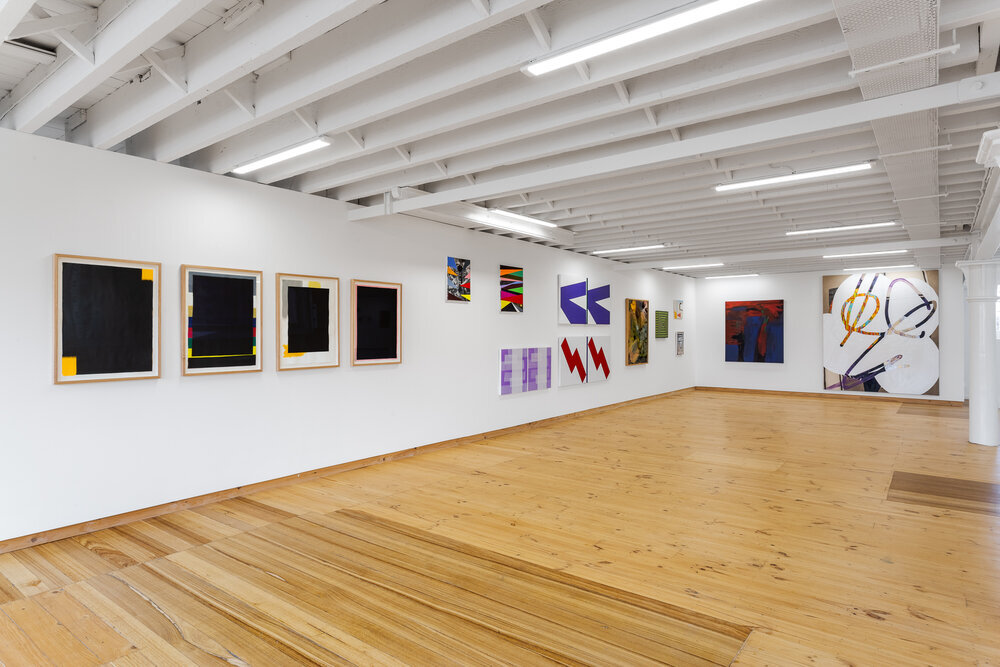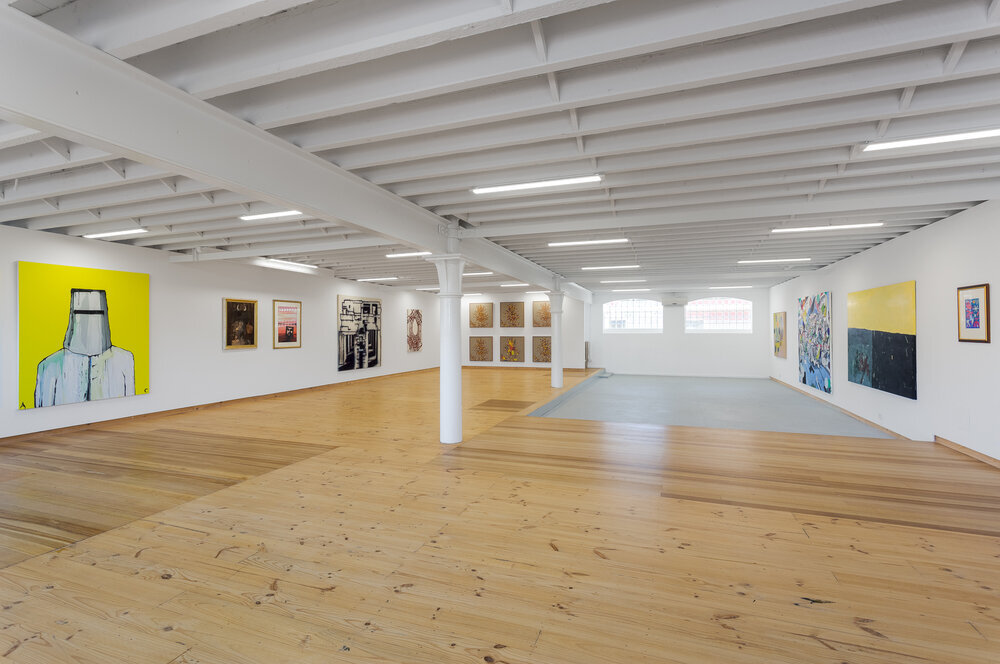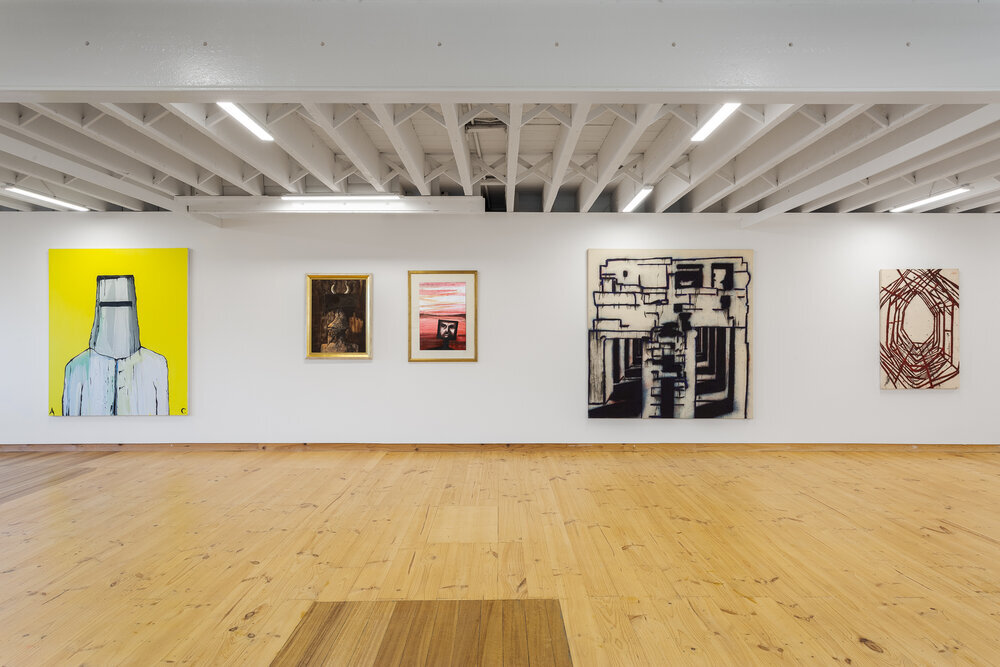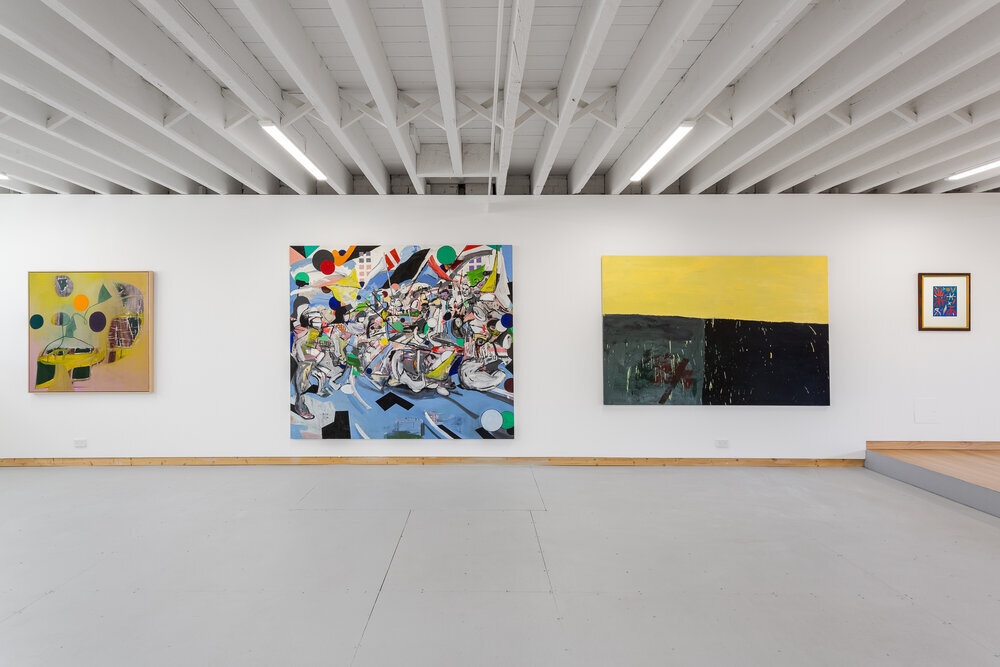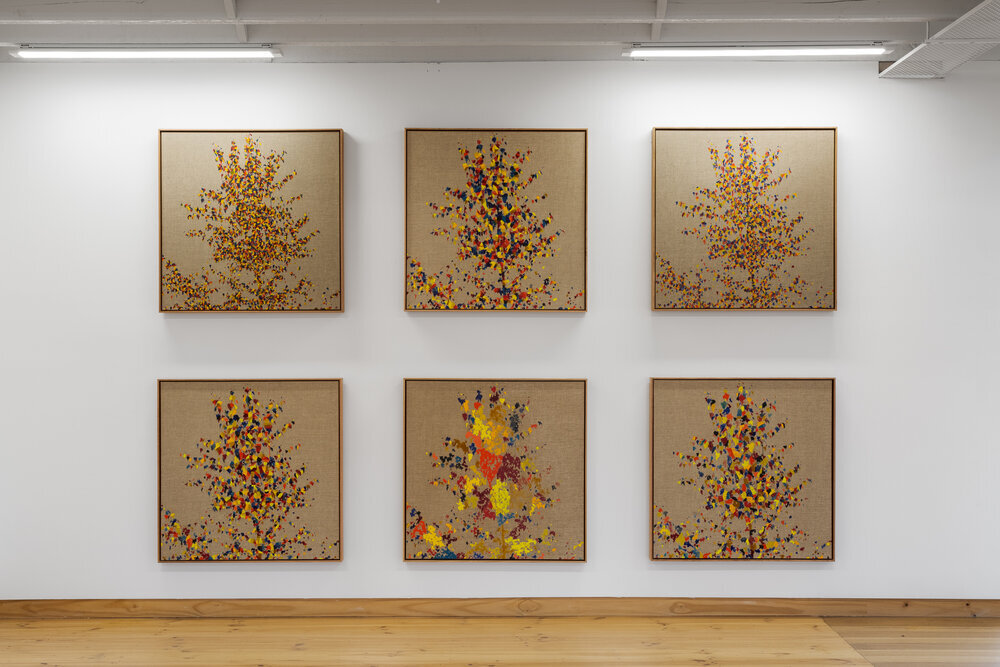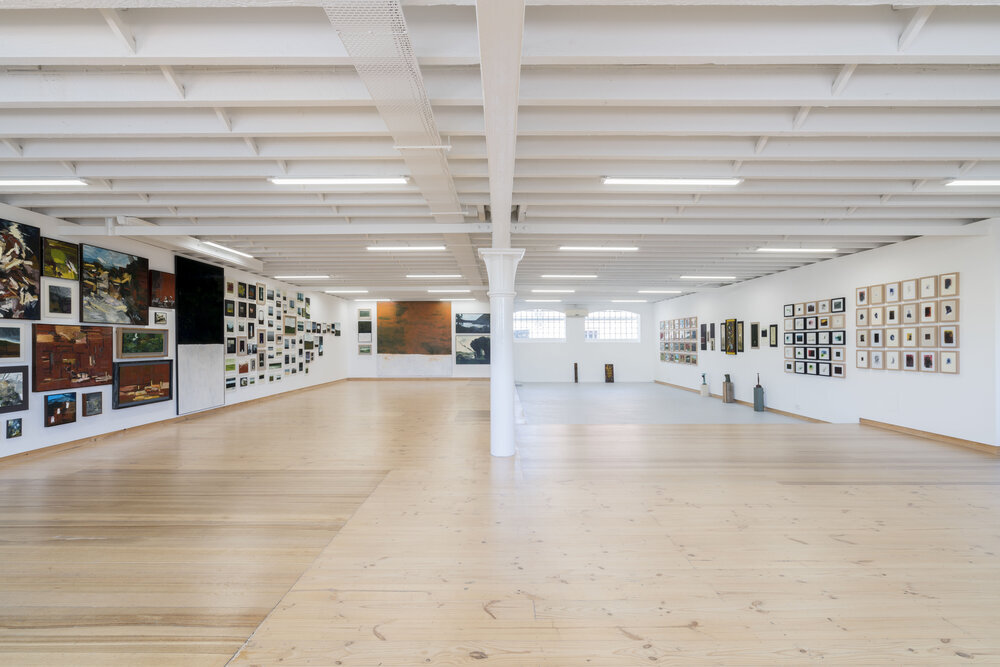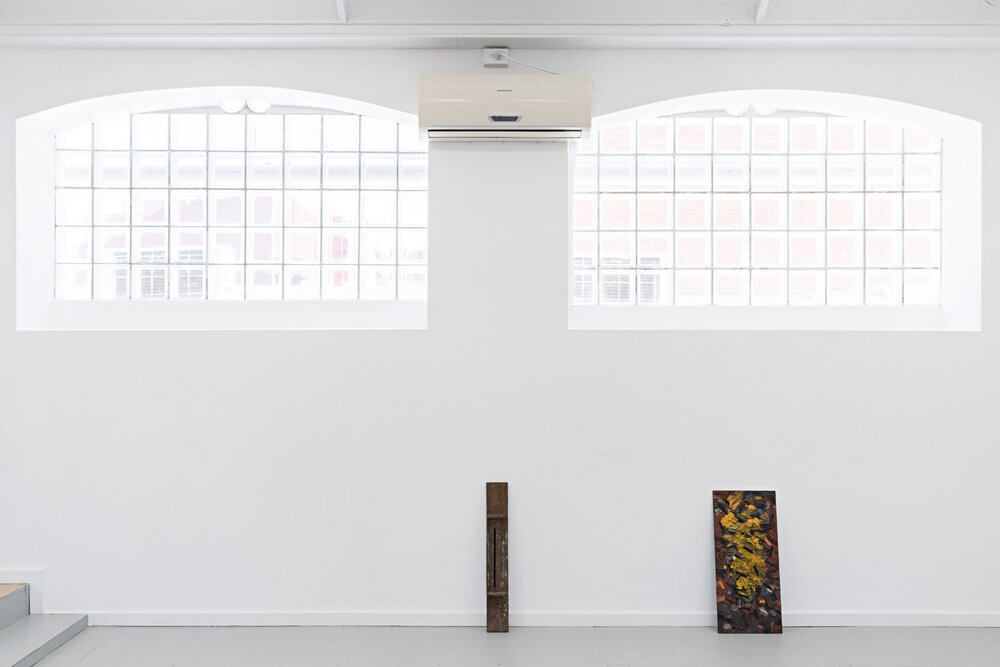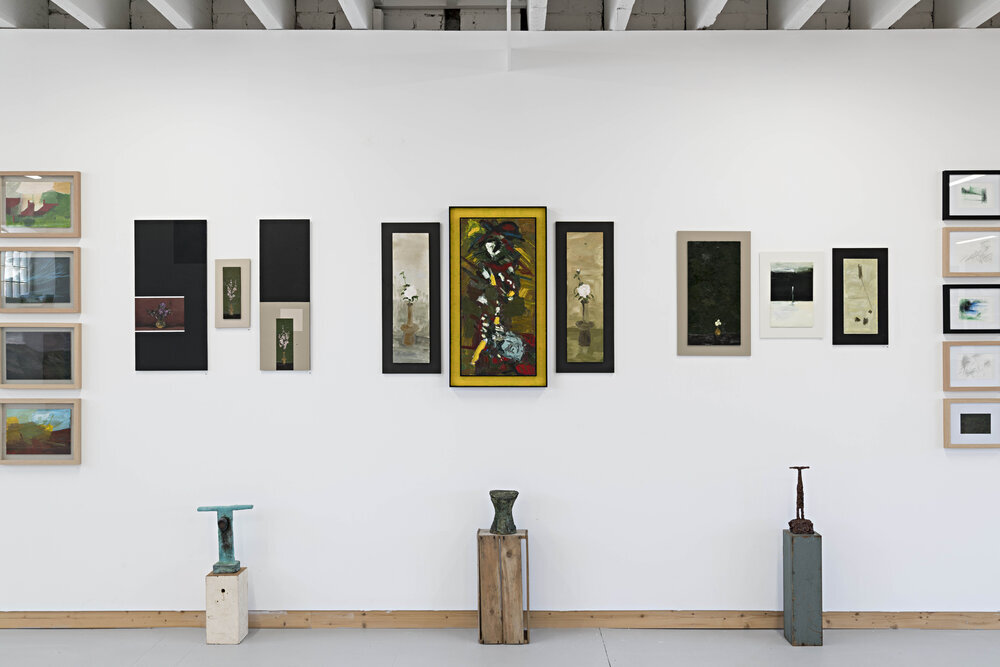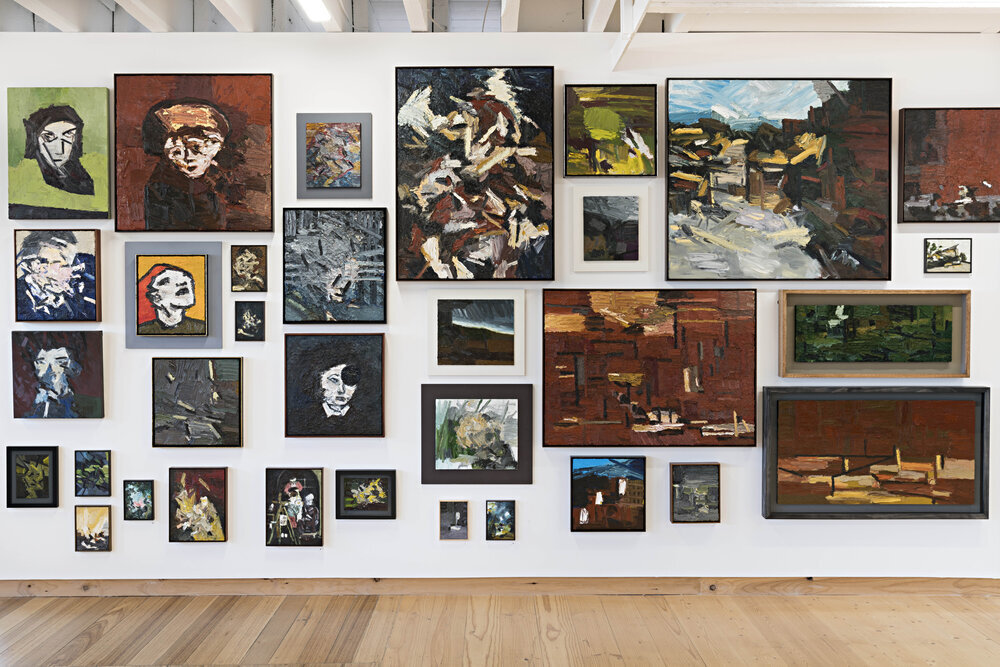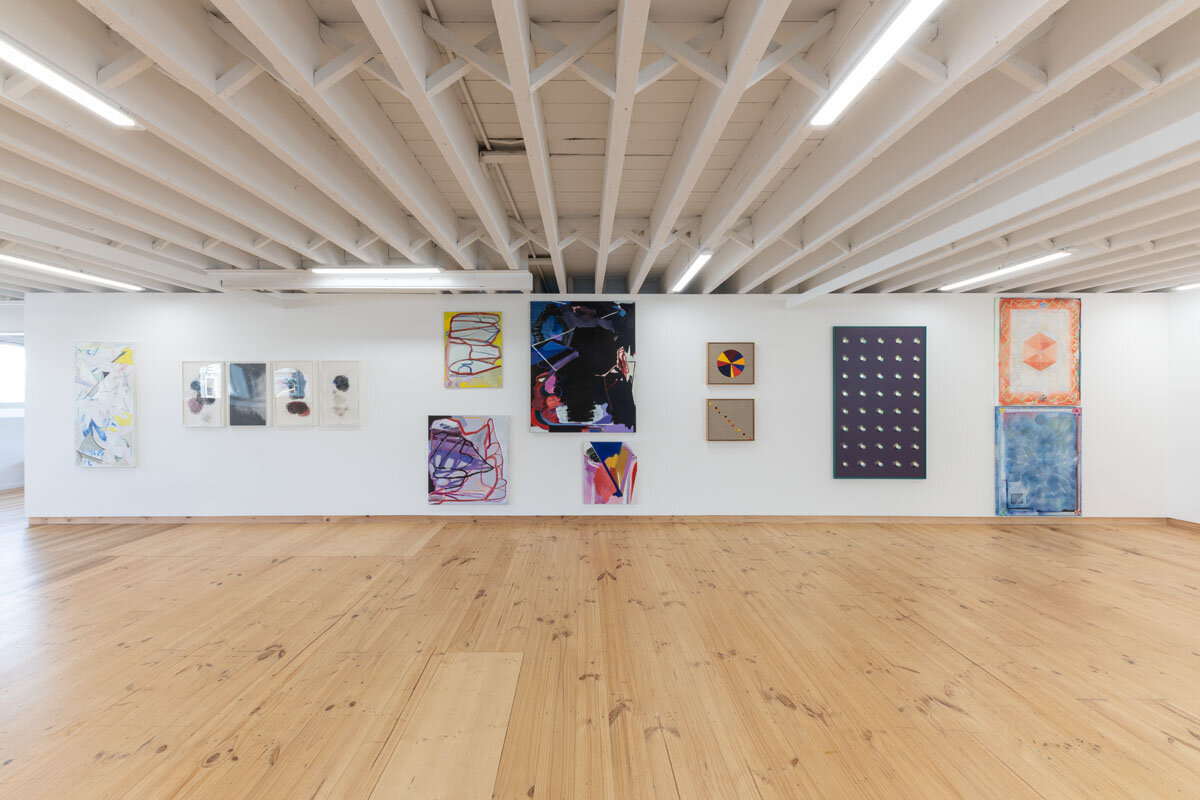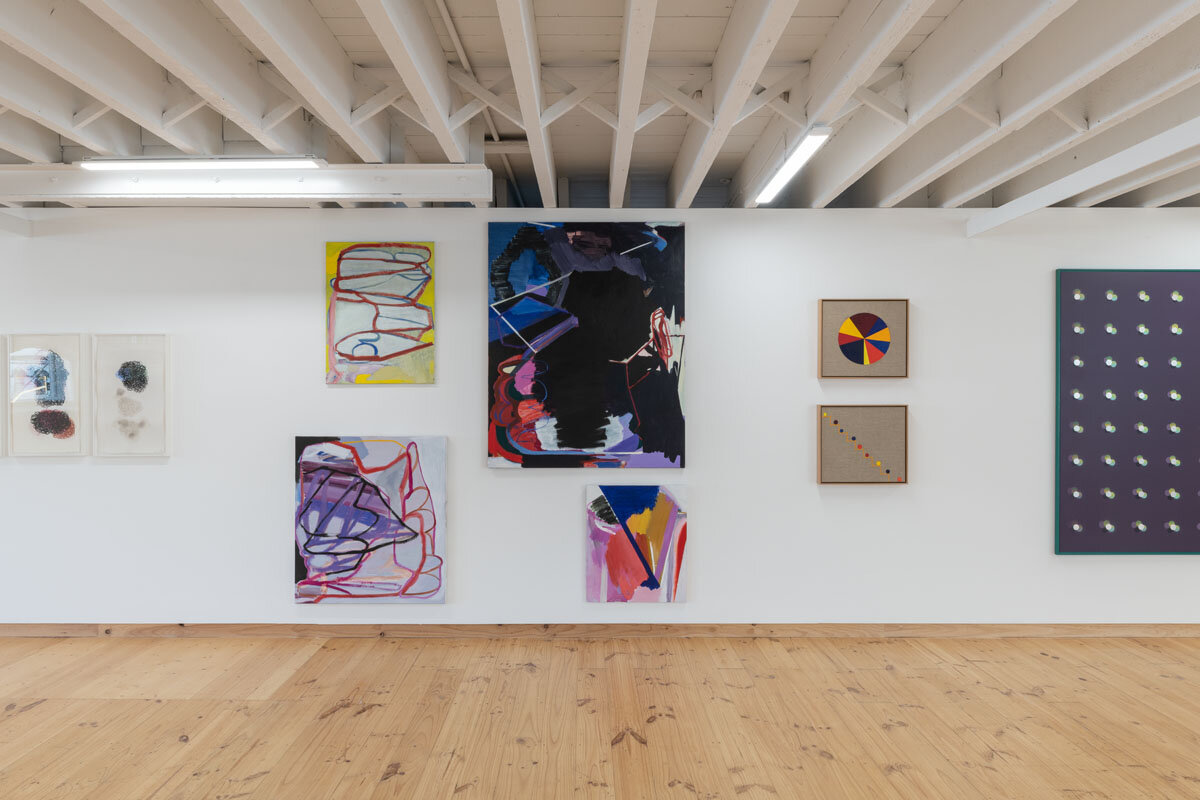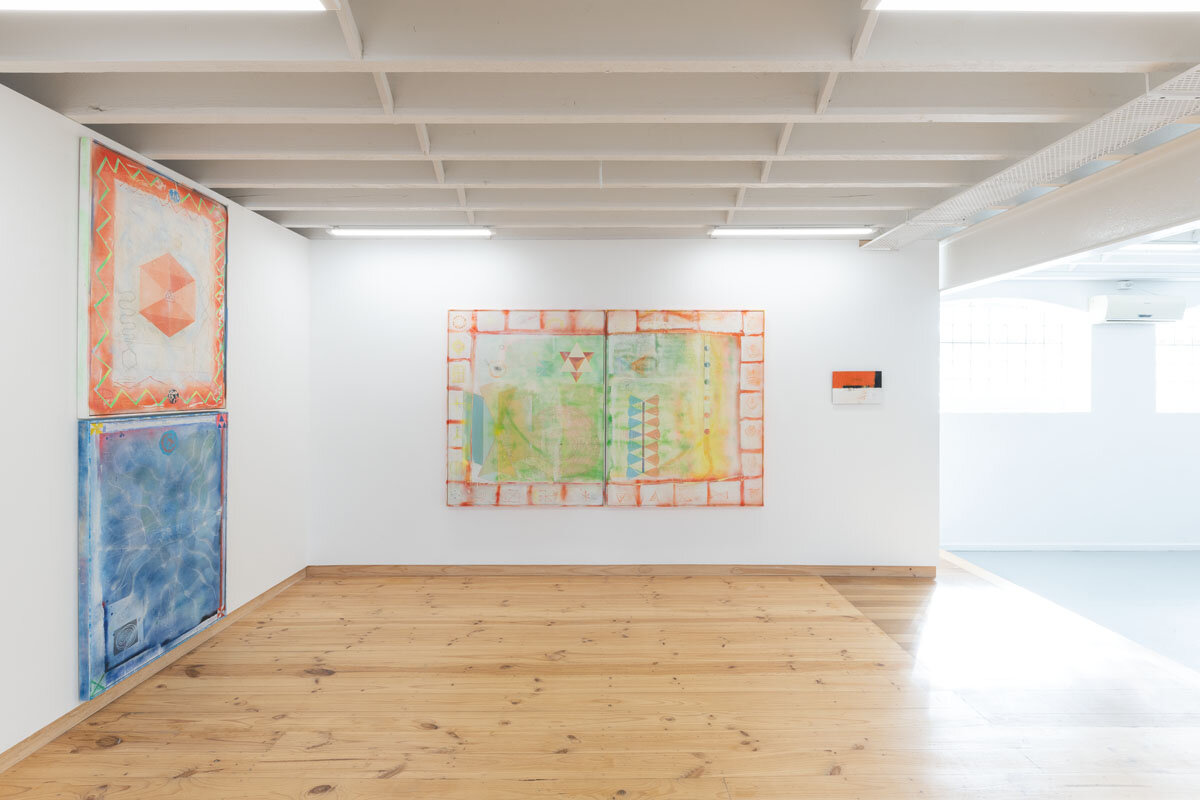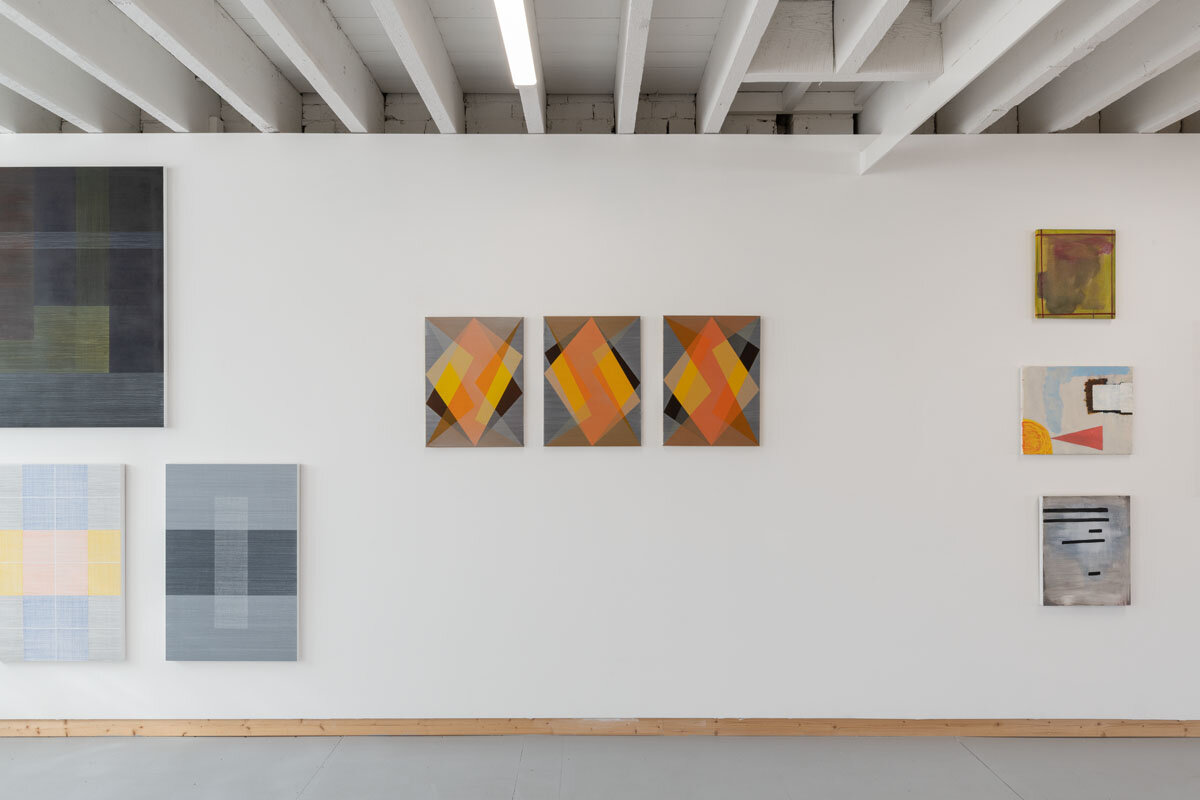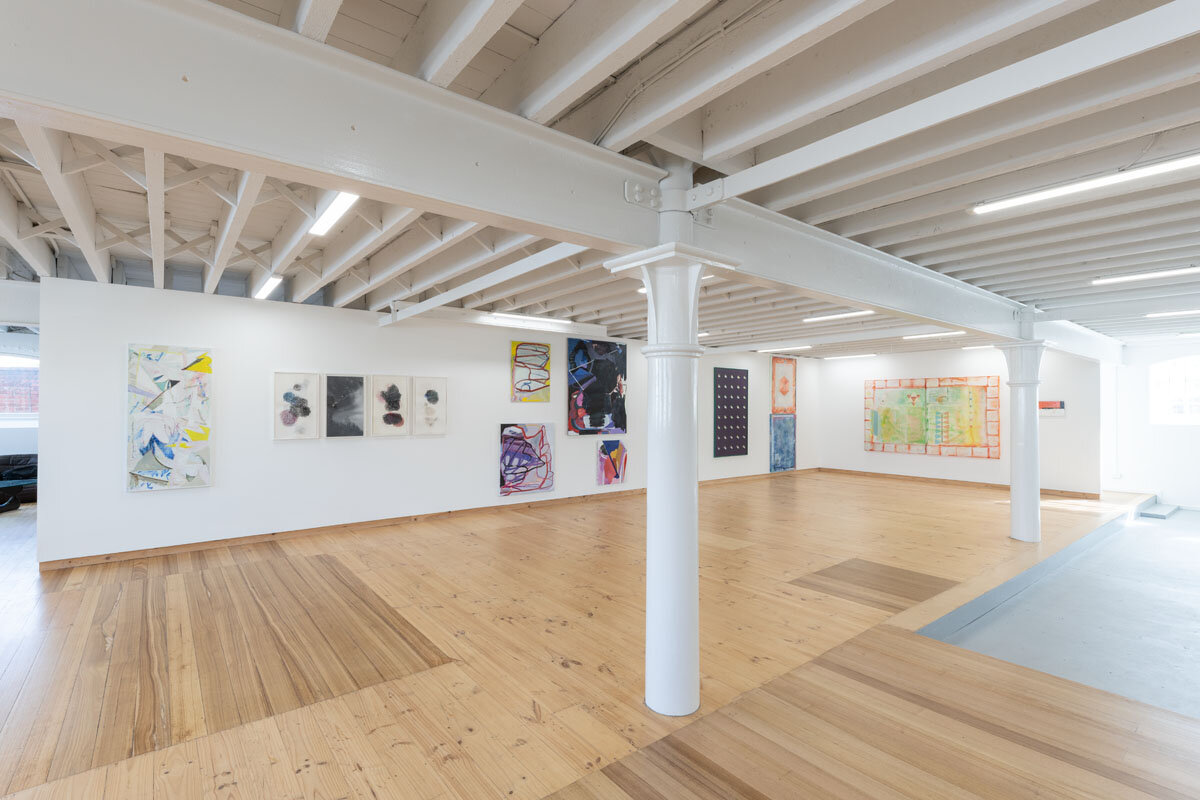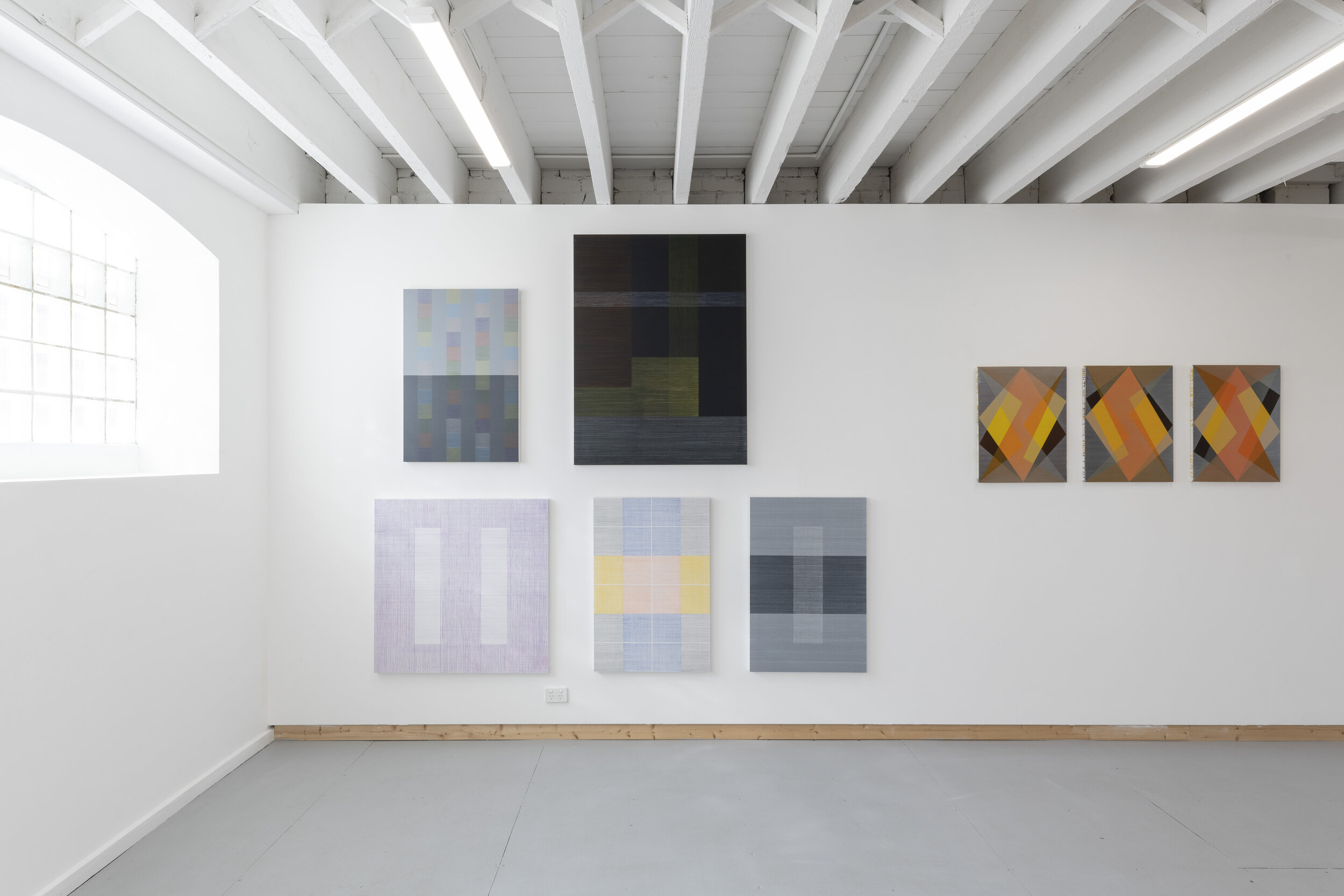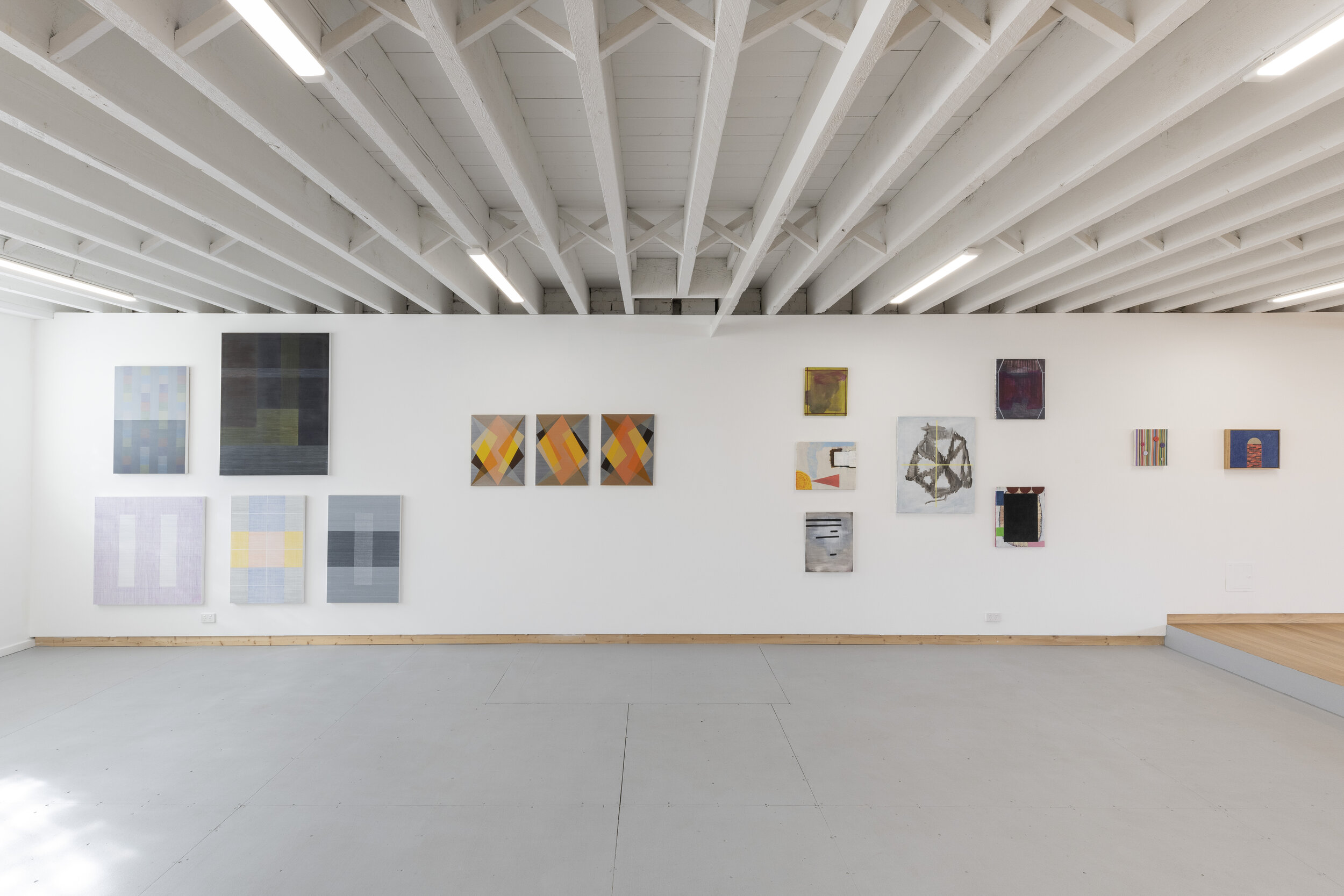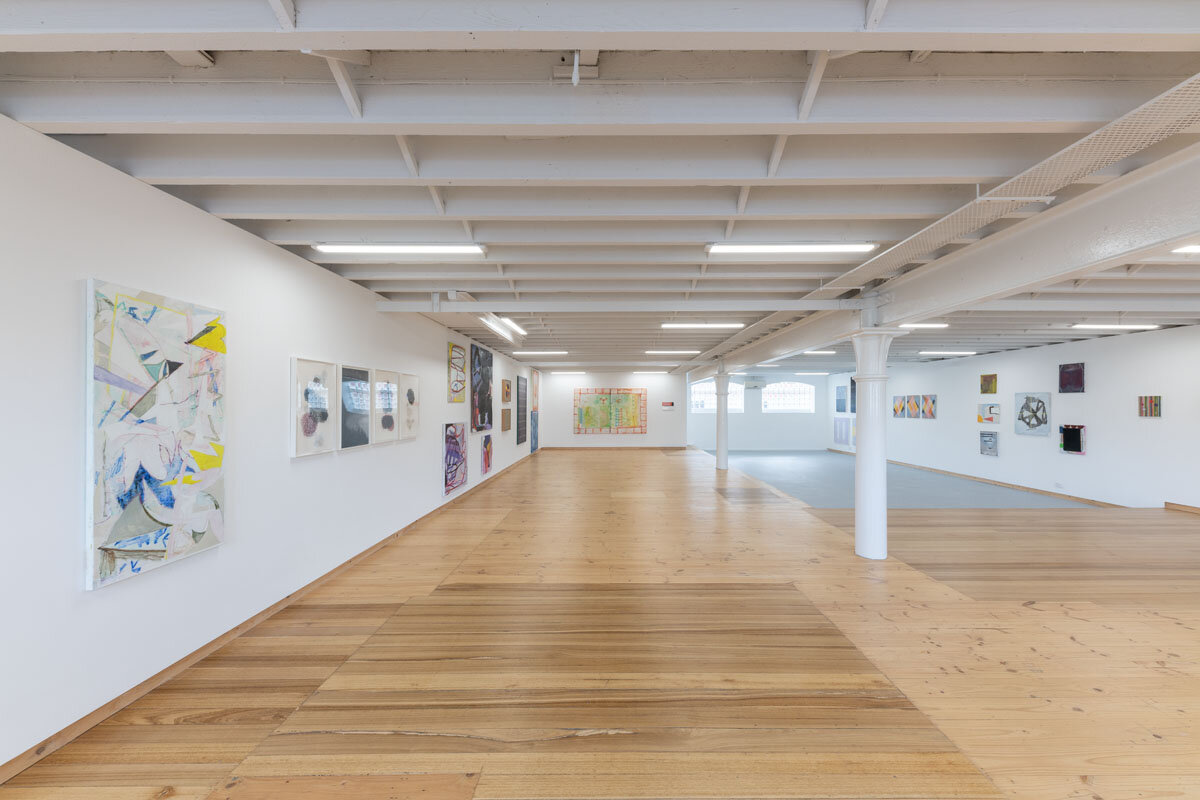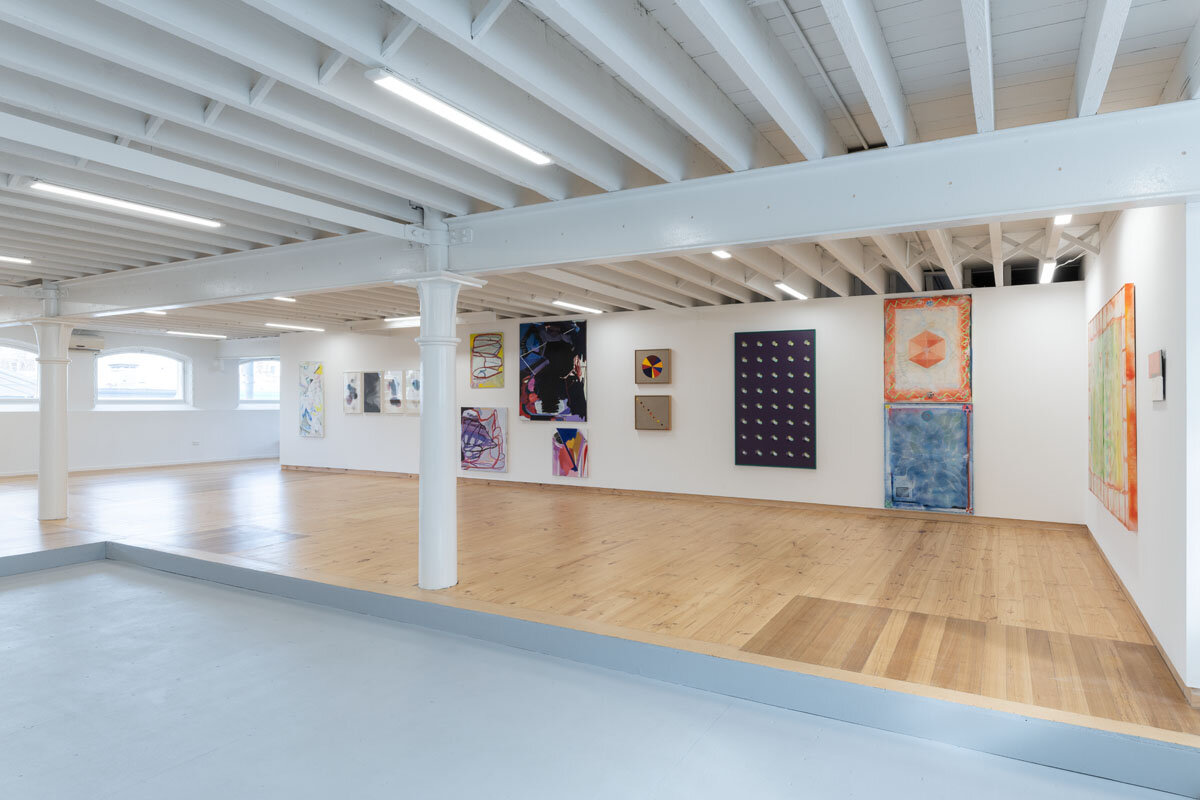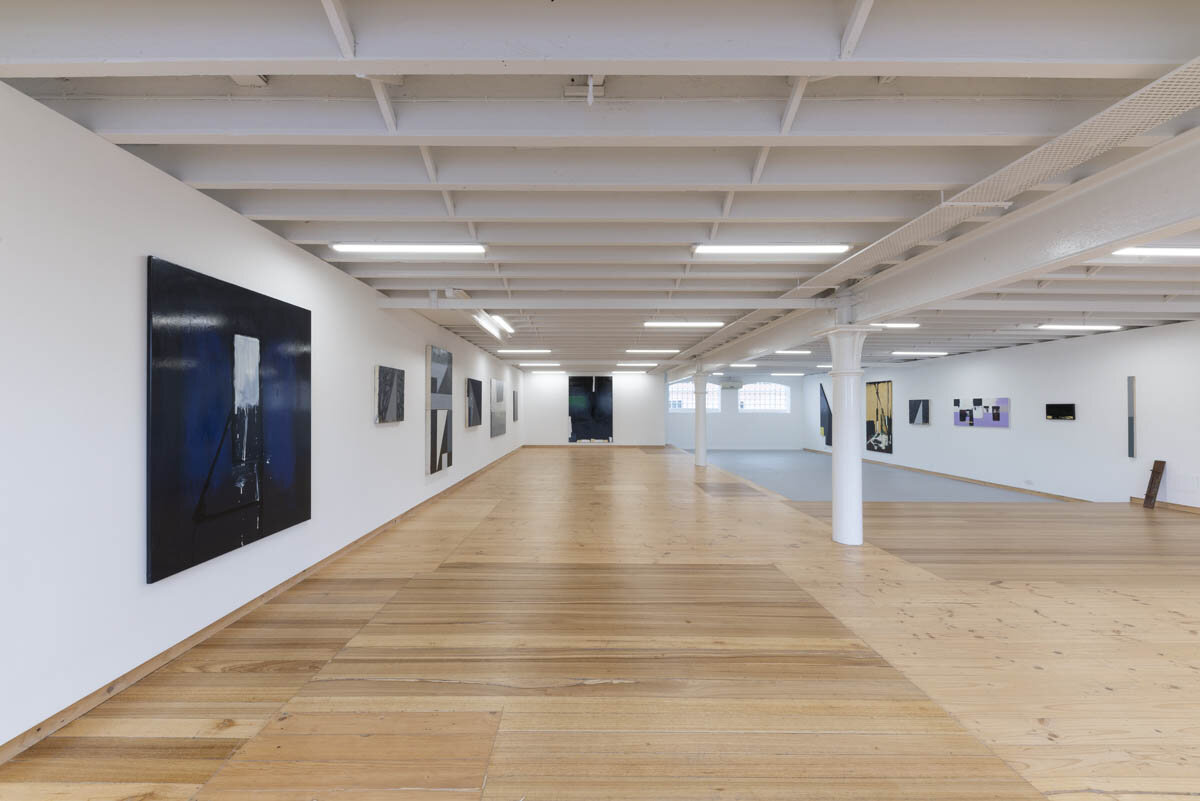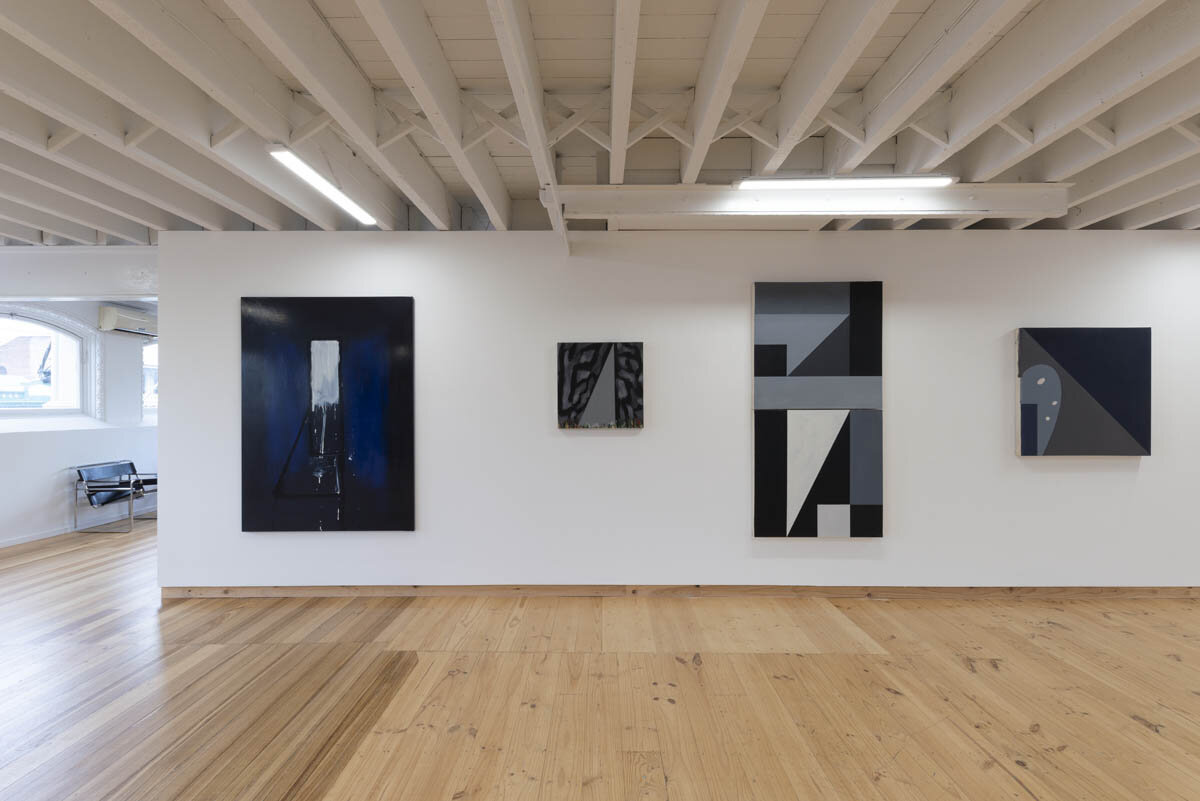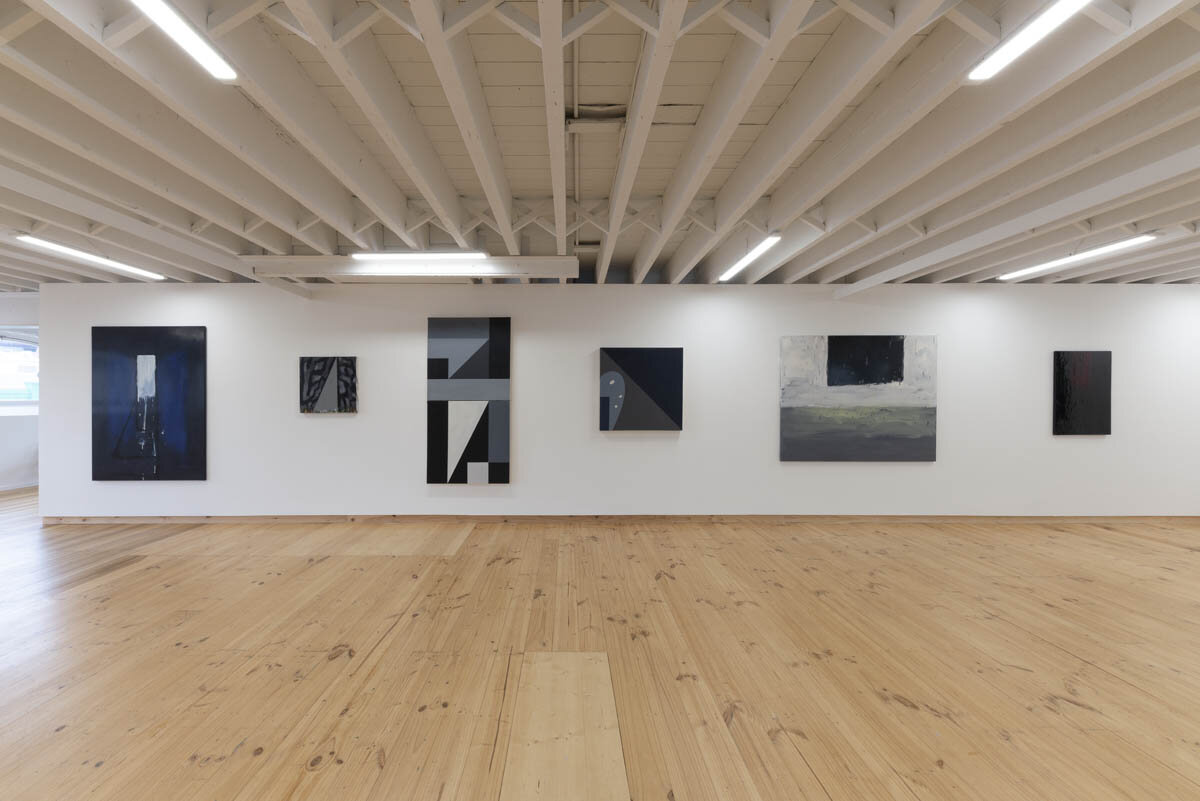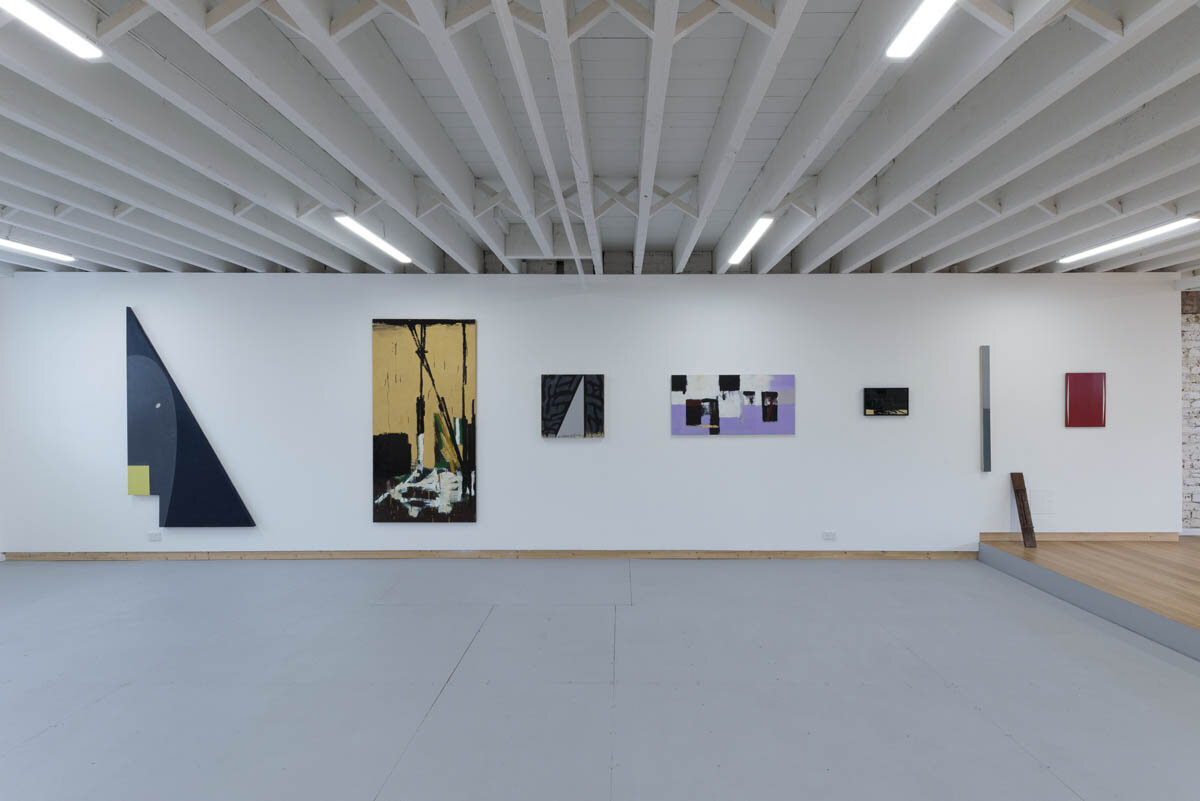the distance between then & now: james clayden, sydney nolan, david thomas, jenny watson, fred williams
The Distance Between Then & Now
09.07.25 - 02.08.25
BLOCKPROJECTS presents The Distance Between Then and Now, a cross-generational exhibition curated by artist and gallerist Jeremy Kibel.
Here, time is not measured in years but in layers of memory, perception, and material. Bringing together five Australian artists, Jenny Watson, James Clayden, Fred Williams, Sidney Nolan, and David Thomas, the exhibition showcases works that span decades yet share a sustained engagement with the temporal nature of image-making.
Each artist navigates time in distinct ways: through autobiographical symbolism, gestural abstraction, reimagined landscape, or conceptual stillness. This is not a historical survey, but a meditation on how the past continues to shape the present and how painting can hold that continuity.
James Clayden, whose practice spans painting, experimental cinema, theatre, and music, contributes his monumental triptych Morning Window #1, #2, #3 (each 244 × 122 cm). Dense and immersive, these works hover between presence and dissolution. Writing on Clayden’s 2020 exhibition at BLOCKPROJECTS, critic Adrian Martin described his painting as “a game of fleeting projection and recognition... the eternal mystery of the horizon.” In Clayden’s hands, that horizon is less a boundary than a zone of psychological tension where form dissolves, re-emerges, and remains suspended.
Fred Williams’s Fallen Tree (1966) is a compact yet commanding painting in which the Australian bush is orchestrated with precision. Dominant vertical trunks are interrupted by the angled fall of a single gum, all framed within a circular composition that asserts quiet structural control. Williams once remarked that when the landscape offered “no focal point,” it had to be built into the paint. In Fallen Tree, the circle becomes a point that concentrates the eye and resolves the visual tension between vertical, diagonal, and horizontal movement.
What might in life appear unremarkable, a tree downed among others, becomes, through colour, compression, and painterly texture, an event of perception. Bark emerges through dragged pigment; the ground lifts gently toward a clear horizon. The everyday becomes extraordinary. The painting reads like a chord: upright trunks sustain the rhythm, the fallen tree cuts across it like an interval, and the horizon holds the final note. It’s a work that evokes “the seeing of sound and the sound of seeing” a synaesthetic charge common to Williams’s most poetic abstractions. Exhibited in Dealer’s Choice at Rudy Komon Gallery in January 1968, Fallen Tree stands as a pivotal expression of Williams’s evolving formal language.
Sidney Nolan’s Parkville (1944–45), a rarely seen early work, offers a lyrical portrait of wartime Melbourne suburbia. With softened contours and flattened perspective, the work captures not topographical specificity, but the mood of a moment. Formerly held by the Sidney Nolan Trust and exhibited at ICA London in 1962, Parkville trades the theatrical intensity of the Ned Kelly series for a quieter, more introspective atmosphere where houses, trees, and telegraph poles settle into a gently pulsing rhythm.
Jenny Watson’s Anointing (1991), first exhibited at Annina Nosei Gallery in New York, is a symbolic, intimate work rendered on fabric. Pairing stylised figuration with diaristic text, Watson’s visual language, shaped by feminist discourse and punk sensibility, transforms lived experience into archetype. Her paintings blur the line between confession and construction, where memory becomes a shared, visual script.
David Thomas’s Untitled (1990-1991), exhibited publicly for the first time, was painted during his residency at the Cité Internationale des Arts in Paris. Modest in scale and meditative in tone, the work reflects Thomas’s sustained inquiry into perception, light, and temporality. “I’ve enjoyed the opportunity to revisit these earlier pieces from my younger days,” he reflects not with nostalgia, but with renewed presence. This quiet painting rewards slow looking, offering a stillness that lingers beyond the canvas.
While diverse in approach, what unites these five artists is not a shared movement or moment, but a profound commitment to painting as a durational, meaning-making act. Their works resist spectacle and urgency, instead favouring depth, return, and resonance.
As Jeremy Kibel observes: “This exhibition is not about nostalgia. It’s about what persists what painting still carries after everything else has passed.”
Each work here reflects a lifelong dedication to painting not as a performance or product, but as a process. These are not images designed for quick consumption or instant affirmation. They are shaped through quiet attention: to place, to material, to memory. And it is within that space between intention and perception, between then and now, that something enduring continues to unfold.
ARTWORKS:
enquire.
JAMES CLAYDEN: 100 DRAWINGS 2020 - 2022
James Clayden
12.03.25 - 05.04.25
James Clayden: 100 Drawings
"These drawings were made between 2020 and 2022 when for no reason l kept them roughly the same size. They weren’t done with paintings in mind, but purely as intimate drawings for themselves alone. When l looked back over them l thought they could possibly go together in a small landscape format book. I had them photographed and slowly l began arranging them into the order they are in this book. There seemed to be a good feeling to the idea of there being 100 drawings, so l made a selection from all l had done in that time and here they are."
James Clayden, a visionary painter, filmmaker, and musician, presents 100 Drawings 2020-2022, a collection that offers an intimate, raw exploration of his creative process during the global pandemic. Through these drawings, Clayden distils his ongoing fascination with abstraction, form, and the delicate interplay of space—unveiling a personal and visceral narrative of artistic evolution.
Spanning two years, 100 Drawings captures a moment of transformation, allowing us to witness the artist’s journey as it unfolds across each piece. This exhibition reveals not only the development of Clayden’s distinctive language but also his deep engagement with the rhythms of time, space, and perception.
Accompanying the exhibition, Blockprojects is proud to release a comprehensive publication showcasing the full series of 100 drawings, offering a deeper insight into Clayden's world and the evolution of his art during these pivotal years.
ARTWORKS:
enquire.
David Thomas: the passing of days and nights
DAVID THOMAS
09.07.24 - 10.08.24
david thomas: the passing of days and nights
Simply put the exhibition is diverse/complex and requires slow viewing. I see it as a journey through various aspects of life, celebrating the intimate and the grand.
THE PASSING OF DAYS AND NIGHTS has a contemplative function.
THE PASSING OF DAYS AND NIGHTS is a COMPOSITE exhibition of abstract paintings, photopaintings, titles, photography, and structures.
THE PASSING OF DAYS AND NIGHTS presents new works that explore the perception of time, space, complexity, impermanence, memory, and feeling.
My PAINTINGS are mainly from the ongoing “Gently Painted Series”.
They are complex in a simple sort of way. They manifest the factual reality of the painting’s materiality, temporality and form. Colour evokes a sense of boundless time/space/ energy. They reveal the sensibility /sensation of human touch in time via surface/facture and celebrate the INTERIOR non-material world of feeling/spirit / thought.
My PHOTOGRAPHY reveals its own material realities (physical, digital, mechanistic). It records the specific, the details of the EXTERNAL everyday world. it activates memory, sentiment, at times reflecting the absurd, the sometimes beautiful, and the sometimes bitter-sweet world of PAST EVENTS.
My use of TITLES is POETIC creating entry points into the work. The titles can be literal, conceptual, humorous, ironic, paradoxical, deeply felt. They act as triggers for recovering content.
The JUXTAPOSITION of the various elements/durations in the exhibition creates COMPOSITE RELATIONSHIPS (at times surprising) between language, form, media, and content… at times simple, at times complex like the world itself.
David Thomas
David Thomas Biography:
David Thomas was born in Belfast N. Ireland. He studied at Melbourne, Monash, and RMIT Universities. He lives and works in Melbourne/Naarm, Australia. His work explores the contemplative function painting, photopainting, and installation, in particular, how new iterations of the monochrome tradition and the composite can explore the perception of time, space, complexity and impermanence. He holds a PhD from RMIT University where he is an Emeritus Professor in the School of Art. He occasionally curates and writes on contemporary Eastern and Western art.
His work is held in numerous private and public collections in Australia and overseas including: National Gallery of Victoria, Melbourne. Australia. Australian National Gallery, Canberra, Australia. Heide Museum of Modern Art. Melbourne, Australia. RMIT University, Melbourne. Australia. Cripp’s Collection, Australia and UK., Gippsland Art Gallery, Victoria, Australia. Ballarat Art Gallery Victoria, Australia. Chartwell Collection, NZ Auckland Art Gallery, New Zealand/Aotearoa. Lowenstein Collection, Melbourne, Australia. Canterbury University, Christchurch, NZ /Aotearoa. Lim Lip Museum, Gong Ju, South Korea.Theodor F. Leifeld Stiftung, Kunstmuseum Ahlen, Germany. Kunstmuseum Bonn, Germany, The Frederick Collection, Germany, Justin Art House Museum, Melbourne.
He is represented by: Block Projects Melbourne, Australia, Minus Space, New York, USA and raum 2810, Bonn, Germany.
ARTWORKS:
enquire.
JAMES CLAYDEN : THOUGHT / MEMORY PAINTINGS
James Clayden
30.01.23 - 02.03.24
Jame clayden: artist statement
Early in 2023 after rewatching Peter Weir’s fantastic film The Last Wave I found myself once again disappointed with the way the film ended and thought to try and paint an ending for myself. The thought kept going around in my head and began merging with the memory of being in the Lisbon Aqueducts that were built on ancient Roman structures during the 18th century; this seemed together with the feeling left by the ending of the film, of being underground beneath the city but at the same time in some deep space far beyond, where past and present pulsed like some atavistic memory of longing amidst water and sky like spheres as one. Out of this, I remembered Michael Snow’s haunting 1967 short experimental film Wavelength and after watching it again it seemed something worthwhile was going on around me, without me, and this together with the mystery of painting itself is more or less how and why I began work on this series of Thought/Memory Paintings.
ARTWORKS:
enquire.
Merric brettle: Physcopomp: In The Eye of The Beholder
Merric Brettle
29.03.23 - 06.05.23
Merric Brettle: Physcopomp: In The Eye of The Beholder
As an artist, I make work about our relationship with the world in which we live, and what is fundamental to me is exploring and expressing this aim in the work’s production.
Central to my methodology is an exploration and use of the ephemeral as this would be the sociocultural associations of various aspects of things in the world such as material, text and context etc.
This description of what I do ‘gets under the hood’ of my practice, and directly relates the methodology I use to the construction of meaning. I have been using an experimental arts practice to make work for the last twenty years. This methodology explores creativity as the product of a clash between the artist and their subject/reality. Making work in this way, I try and capture the presences of both my subject and myself, as these would be my sense for example of the socio-cultural associations of my subject and also the sense of ‘me’ generated by my expressiowithin fabrication. I then explore a resonance or reverberating relationship of cause and effect, between these presences, and personally reflect on its nature as I make work and construct meaning.
This reveals the way that I use an understanding of the presences of my subject and myself, as exploring them helps me make work. When reading my work however, the viewer considers this use a little differently. That is, as they explore this resonance as it would support what I say. It is in this way that understanding the presences and resonance between them that guided my construction, that the viewer considers an emotional/conceptual framework within which understand nuance and complexity within what the work refers to. In this way this resonance functions much in the same way as a painter’s brushstroke, as it puts emotional inflection on a piece.
To illustrate I first used this methodology in a series of works that explore our relationship to a constructed urban landscape. In these works, I captured the presence of my subject by employing the materials and methods of its construction like concrete, plastic and vacuum forming etc. not only because the allowed me to fabricate something but also for their socio-cultural associations.
My presence was then captured in the forms I created and the idiosyncratic way in which I explored the expressive possibilities of these ‘found’ materials and methods. When constructing meaning in the work I explored the resonance between these two presences as I made work about the way that we construct this landscape, but are never able to produce exactly what we want.
This reveals the way that I use the ephemeral as it would guide what I make the work about. When the viewer considers it however, they do so a little differently. That is, as it would give the work emotional inflection. To illustrate, I hoped for the viewer to read these presences and their resonance between them as they would reveal a landscape that is banal toxic and distorting, yet somehow beautiful, alluring and an expression of hope. It was in this way that I hoped for this resonance to give my work emotional depth much in the same way that a brush stroke or texture would. Making work in this way I hoped for the viewers to consider the nature of our relationship to this constructed reality as it would not only reflect our hopes and human abilities to realise them, but also our limits, failings and inability to avoid them.
Employing this methodology, I do not illustrate an idea but create contemplative pieces in which I hope for the viewer to explore sense, presence and resonance as they would express a more nuanced understanding of what the work refers to.
---
This kind of methodology can be simply ‘aimed’ at other subjects and it was with this in mind that I decided to explore our relationship with a now digitised social reality. That is as a social reality is a mixture of the ‘forms’ of our social relations that we interact with and the collective codification of reality that we use as a lens through which to see the world. Because this new subject has no physicality in itself, I started to explore text and text construction methods as my materials and methods. In particular, I explored this text as images and image construction techniques. I did not think that making this shift would be a difficult task, because if there is anything that expresses the ‘presence’ or sense of a social reality, then it is this form of text. I soon discovered however, that this change in subject would create fundamental problems for my methodology. The situation was that because images have no physicality in themselves, I couldn’t capture the presence or sense of my subject in the works materially as I had previously done. The effect of this was that I had an either/or choice between capturing the presence of my subject or my own in the forms I made.
This created a crisis in my methodology, which made not only making work difficult, but also, I realised, reading the work. Consequently, I became determined to find a way to capture these two presences in a piece. I managed to do this via collecting and remaking samples of images and image construction techniques from the Internet. These samples captured the socio-cultural associations/presence of my subject in themselves as they referred to something, while their transliteration from screen images to painted object using spray paint and sign writing vinyl captured mine. My presence was thus no longer in the forms of the work, but in its physicality, and so existed in for example the overlapping of paints between forms, the use of glazes to capture the effect of backlighting and an exploration of the logic of pixilation. This resolved my issue because the works were able to perform something like a cognitive ‘gestalt flip’. That is that like the classic optical illusion in which an image can be seen to ‘flip’ between being a depiction of a rabbit and duck, that these works could also ‘flip’ between being seen as either a sample/found image or an abstract minimalist painting.
This resolution however, created other problems because in locating the presence of my subject in the forms I create and myself in its physicality, I no longer had access to these forms as they could refer to anything. The implications of this was that I couldn’t make the works ‘about’ the relationship between the individual and my subject. I found this incredibly frustrating because this is in essence the ‘point’ of my methodology as an exploration. Consequently, I now had to find some way in which to allow for the works to refer to something, without displacing or destroying the presence of myself or my subject. The resolution I came up with was to explore different physical separations in the work that allowed for me to put either presences or references within them and thus allowing for all to be read in resonance.
To illustrate, I explored the use of different materials to make collage like works in which these images could be seen as separate or together thus preserving the presence in them of my subject while allowing for the relationship between images to refer to something else. I also started to join different panels that would allow for the use of one as a sample and the other as a vehicle for referring to my ideas. I then started to use the sides of the panels and their relationship with a wall as other places where I could locate a presence or a reference to something. It was with these separations therefore, that I felt I now had a whole lot of compartments or what to me seemed to be conceptual planes within which to locate presences and references and explore resonance between them.
---
There is still much that needs to be considered and explained about this expansion of my methodology, but what I can do now is explain the relationship between production and meaning as I both make work and hope for it to be read.
Exploring the nature of my subject with my methodology, I have come to the belief that while a social reality exists, that it is constituted by our projections. Within this framework, I have also come to believe that while we are objective to it as it would be constructed by others projections, we are not objective to it as it would also be constructed by our own. Consequently, I feel that before we can describe this construct and our relationship to it, that we must first understand how we can ‘see’ it as it would be other to us yet not.
The works in this exhibition express/explore this belief and so when considering the references within them, they all relate to the way that our projections are part of what we see even when we are perceiving the projections of others. When contemplating the physicalities of the work by contrast, I would like the viewer to think about the way that I explored my presence in relationship to the samples I use as it would create a reverberating relationship with the works, and in doing this see this relationship as a metaphor for that which we have with a social reality as we can ‘see’ it. It is thus for example, that I would first like the viewer to explore my ‘marks’ as they would be evidence of me ‘within the image/samples’ as there is ‘stuff’ in the glazes, ‘under the image’ as it would relate to the textures that exists, ‘on top of the image’ in the vinyl on top of the paint, and ‘other than the image’ as I would explore ‘around’ the panel or behind it. I would then like them to think about the way that the sense of a reverberating shifting surface that tracing of marks would suggest, would be a metaphor for the kind of vibrating immediacy that I think we need to understand that we have with a social reality before we see it.
When thinking about my personal perspective on a social reality, I do not attempt to describe the perspective I think we should construct, but only the perspective that I explored on the way that we may see that reality as it would be partly our projection. To express this, I would hope for the viewer to explore my ‘marks’ in the work as they would provide them with a metaphor for the experience I had. Consequently, I would like for them to explore the way that they are formally pulled into the works by some of these marks, pushed out by others, and made to go around them etc by yet others as they would in essence ‘step into my shoes’. It is in this way that I would hope they then think about what it means to be ‘in the eye of the beholder’.
Artist Statement, 2023
ARTWORKS:
enquire.
james clayden: flights of fancy
David Thomas
12.11.22-30.11.22
James Clayden : Flight of Fancy Installation Images
‘‘To me, great abstraction has always represented mystery. The literal or the realist painting grapples and passes with a moment. It merely records a single grain of sand on the eternal beach. Great abstract paintings deepen the mystery of our existence but also emote the feeling of the eternal. I feel that Clayden has always been in this zone of deep questioning but has an insightful understanding of what we have to get done in our nominated period as human beings. The mantra.
When l have had the privilege of standing in front of some of the greatest abstract paintings ever made, from east to west, they have all had a commonality of making me feel that there is something strange and mysterious beyond the physical and material world. I have had this feeling on many occasions in front of Clayden paintings. It is as if he has an understanding of that mystery, an insight that has come from humility and a dense art practice that has never followed fashion trends. A true gift of new conditions and discoveries. A moment of insight that gives us a reason that it all meant something to exist on this mystical spinning ball in space.’
Jeremy Kibel
ARTWORKS:
enquire.
the colour & the shape
10.08.2022 – 03.09.2022
Installation images, The Colour & The Shape. Blockprojects, 2021. Photography: Simon Strong
Blockprojects is please to present The Colour & The Shape, a group exhibition exploring the visual language between shape, form, colour and line in abstraction.
ARTISTS:
Steven Asquith, James Clayden, David Freney-Mills, Jason Haufe, Kyle Jenkins, Paul Newcombe, Tom Vincent, David Wallage.
SELECTED ARTWORKS:
now & then : 40 years of abstraction
08.04.2022 – 16.04.2022
Installation images, Now & Then : 40 Years of Abstraction . Blockprojects, 2021. Photography: Simon Strong
This group exhibition features a selection of abstract works from the last 40 years.
ARTISTS:
Steven Asquith, Neil Keith Baker, Stephen Bram, Merric Brettle, James Clayden, Dan Dan Dai, Robert Jacks
Dale Frank, Marc Freeman, Denise Green, Kyle Jenkin, Michael Staniak, John Nixon, Julia Powles, David Thomas, Vivian Cooper Smith, Tom Vincent, Peter Westwood, what.
SELECTED ARTWORKS:
THE DIRECTOR’S CHOICE 2021: important australian & international works of art.
17.04.2021 – 28.04.2021
Installation images, The Director’s Choice 2021: Important Australian and international Works of Art. Blockprojects, 2021. Photography: Angela McKinnon
This group exhibition features a selection of abstract and figurative paintings, works on paper and sculpture by important Australian and International artists.
ARTISTS:
Tony Bevan,
James Clayden, Adam Cullen, Robert Jacks, John Olsen, David Thomas, Tony Tuckson, Ben Quilty, Brett Whiteley, Ken Whisson, Fred Williams.
SELECTED ARTWORKS:
HOW SOON IS NOW
12.08.20 - 12.09.20
Installation images, How Soon is Now. Blockprojects, 2020.
Blockprojects is proud to present, HOW SOON IS NOW,
an exhibition featuring fifteen contemporary artists who explore the mystery of abstraction.
ARTISTS:
Darren Munce
Julia Powles
Eduardo Santos
David Thomas
Tom Vincent
David Wallage
Peter Westwood
Neil Keith Baker
Merric Brettle
James Clayden
Dandan Dai
Robert Doble
Marc Freeman
Kyle Jenkins
Jason Haufe
enquire.
THE DIRECTOR’S CHOICE 2020: LEADING AUSTRALIAN AND BRITISH ARTISTS
09.06.2020 – 11.07.2020
Installation images, The Director’s Choice 2020: Leading Australian and British Artists. Blockprojects, 2020.
This group exhibition features a selection of abstract and figurative works by important Australian and International artists.
ARTISTS:
Tony Bevan,
James Clayden,
John Colburn,
Adam Cullen,
Sydney Nolan,
Albert Tucker,
Gareth Sansom,
Peter Walsh,
what.
SELECTED ARTWORKS:
JAMES CLAYDEN: PAINTINGS - DRAWINGS - GROUPINGS
10.03.20 - 11.04.2020
Complex Translation by Adrian Martin
Art, a wise person once said, is a matter of the “complex translation of the seen and the felt to a series of visual marks on a flat surface”. That’s a mystery you can contemplate forever. For such translation has nothing to do with verisimilitude, copying, faithful reproduction. Things change, transform along the line between the seeing & feeling, and those marks laid upon the flat, layered surface.
The original impetus – that landscape, object, face, moment, flicker or flare – can be lost altogether, beyond recognition in its eventual rendering. That doesn’t matter, in the end. It is what arises, what we – both artist and spectator arrive at, which counts.
James Clayden can sometimes seem like an abstract painter. But I never, personally, find his work (whatever media he uses) to be entirely abstract. There is always the trace – sometimes evident, at other times faint – of what, in the world, inspired him to begin his complex translation.
We sometimes see a line, a shape, a nose, a post, a fence railing. Maybe that’s what they are, maybe not. The nomination doesn’t matter. What matters are the visual marks, the marking, the intensity and process of that.
Edward Colless writes: “It is something else – that com- motion of vague and fleeting sensations … I loiter among vagrant, half-formed perceptions, bewitched”.
It seems to me that James begins from something at once very concrete (a sight, a sense-impression), and some- thing cloudier: a feeling, an association, some obscure reminiscence that has been sparked within him. It is all those things at once that he seeks to translate. Not to disentangle them, necessarily, but certainly to convey them to the canvas, page or screen. Maybe he himself is not always completely sure what this process is all about. But it drives him.
Sometimes, I feel, with a sharp pang, that I grasp some- thing very specific in his pictures. Maybe a person I know (who we both know), a film scene that I too have seen, a precise location where I have stood and viewed something from that very same angle. There are place names indicated in the titles: Hampstead Heath, Primrose Hill. Have I ever been there, or are these pictures just making me imagine it was so?
I never attempt to verify any of this with James, because I may be entirely dreaming it. But what’s important is that his art can incite this game of fleeting projection and recognition.
The fleetingness is what matters. The dissolution and rebirth of the trace. The loss of a stable, consensus referent; but also the finding of a personal point. Just for a moment, before it vanishes again. The complex translation that takes the artist down one path, and the spectator along another, around the same work.
There is truly a hallucinatory aspect to immersing your- self in James’ work; that’s certainly my experience of it, at any rate. Dark patches, shadow, pools of night. Outlines are blurred, and are plunged into amorphous masses. The tops of trees shimmer and dissolve into each other. Square objects – they could be anything – rise out of the ground, but also disappear into it. Faces are creased, folded, their features unaligned.
The eternal mystery of the horizon: is it a thing, existing in itself, or just the interval between other things, land and sky, earth and clouds? The horizon is the line that is not a line; yet what work it can do inside an image.
The hallucination can be three-dimensional, 3D. Layers and smudges on that surface. “The skin of another”– where skin is translated by folds and swathes of coloured paint. Depths emerge but then find themselves, once again, brutally flattened, cancelled. James is always fighting with the flatness, resigning himself to it, then making it “pop”, somehow, in and for our eye.
The incessant movement in his film and video work is never far away from his paintings, drawings, and other as- semblages. Yet his films and videos, too, wage war, stage a dance, between the flatness & stasis of abstraction and the fullness of actors in space – a space of theatre, of mise en scène, another medium in which he works and plays.
James is often involved with the telling of stories in his work. But the stories are cryptic. Suggested, elusive, allusive. Memories crossed out, but still visible, struggling to be seen and heard. Ghost paintings. A vertigo of the visible; an inaudible, murmuring soundtrack.
I experience a kind of synaesthesia from James’ art. While I stare, I am hearing the sway and rustle of those trees; and also the scratch and bustle of his own painting- drawing tools. Things are returning to me – even if they are not the same things that James himself began from. Voices speak, whispering poetic fragments in my head.
Ruins of texts, of the sensations and feelings they gave me, once upon a time. Shakespeare, Cassavetes, Sondheim: I know they are all, somewhere, in James’ neural memory banks, and sometimes also in mine. But convergence and divergence are the same, ultimately, in this game. He can start from a mountain and end at a movie; I can go in the opposite direction. The translation shuttle is two-way, and eternal.
Art, the reception of art, is the crowded, suddenly fro- zen, eternal moment in the middle, in medias res. We are caught between things and feelings, objects and their metaphors, memories and their stories. Stranded between the host language and a newer language to come. A series of visual marks on a flat surface returns us to the seen and felt not the original thing seen and felt, but something else, something that is coming into being.
Something stirring in the darkness and in the light; something flitting between the lines and the outlines. The marks made on our bodies, and our hearts.
James Clayden’s art, in all its forms and manifestations, is the art of infinite suggestiveness.
Adrian Martin is an associate professor at Monash University, and a film and arts critic.
SELECTED ARTWORKS:
CANTO
31.08.19 - 14.09.19
Installation images, Canto. Blockprojects, 2019.
Blockprojects is proud to present, HOW SOON IS NOW,
an exhibition featuring fifteen contemporary artists who explore the mystery of abstraction.
ARTISTS:
Justin Andrews
Neil Keith Baker
James Clayden
Will Cooke
Jordan Grant
Denise Green
Melinda Harper
Julia Powles
Tom Vincent
David Wallage
what
enquire.
ROBERT JACKS & JAMES CLAYDEN: WHAT IN THE WORLD
28.05.2019 - 22.06.2019
Blockprojects is pleased to present, What in The World, an exhibition of paintings by two of Australia’s most pre-eminent painters of our time, Robert Jacks and James Clayden. The exhibition features paintings from the late 1960s to mid-2000.
